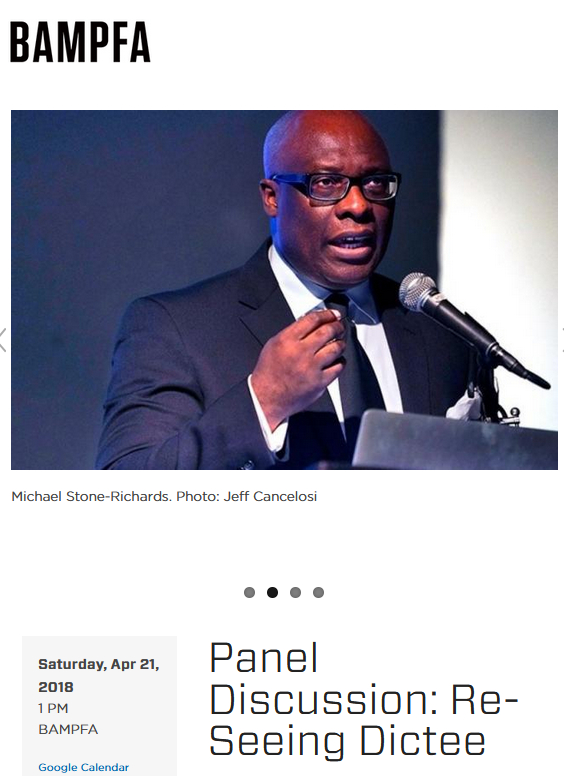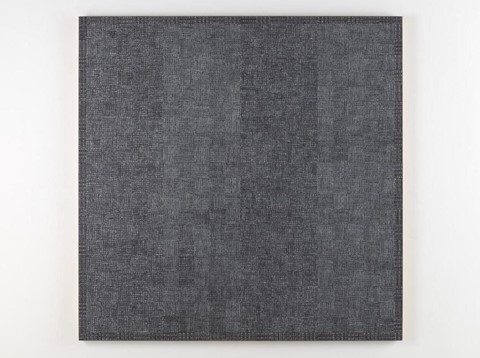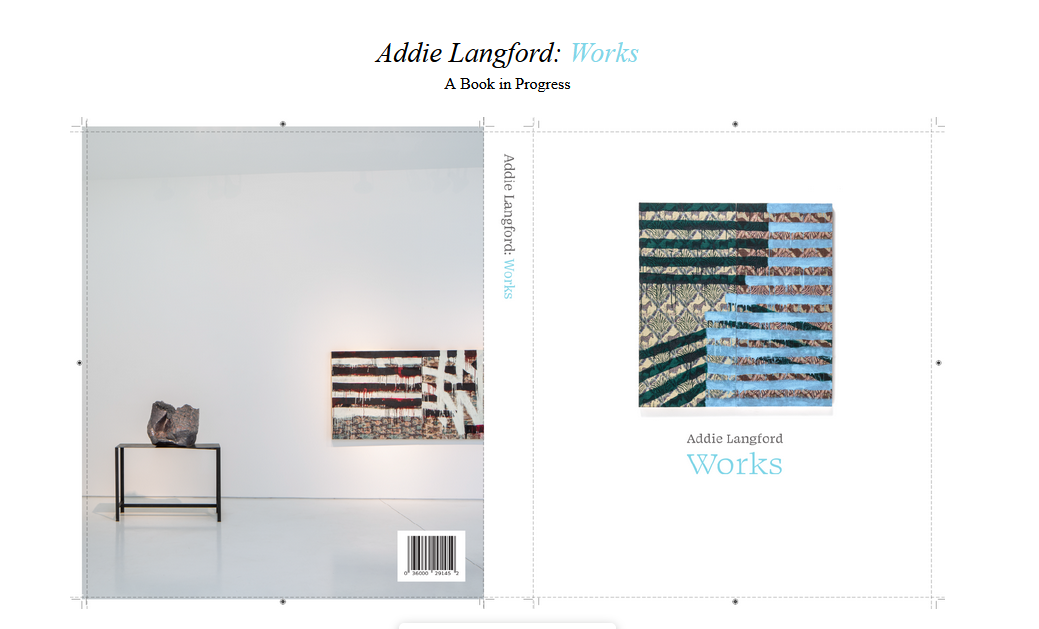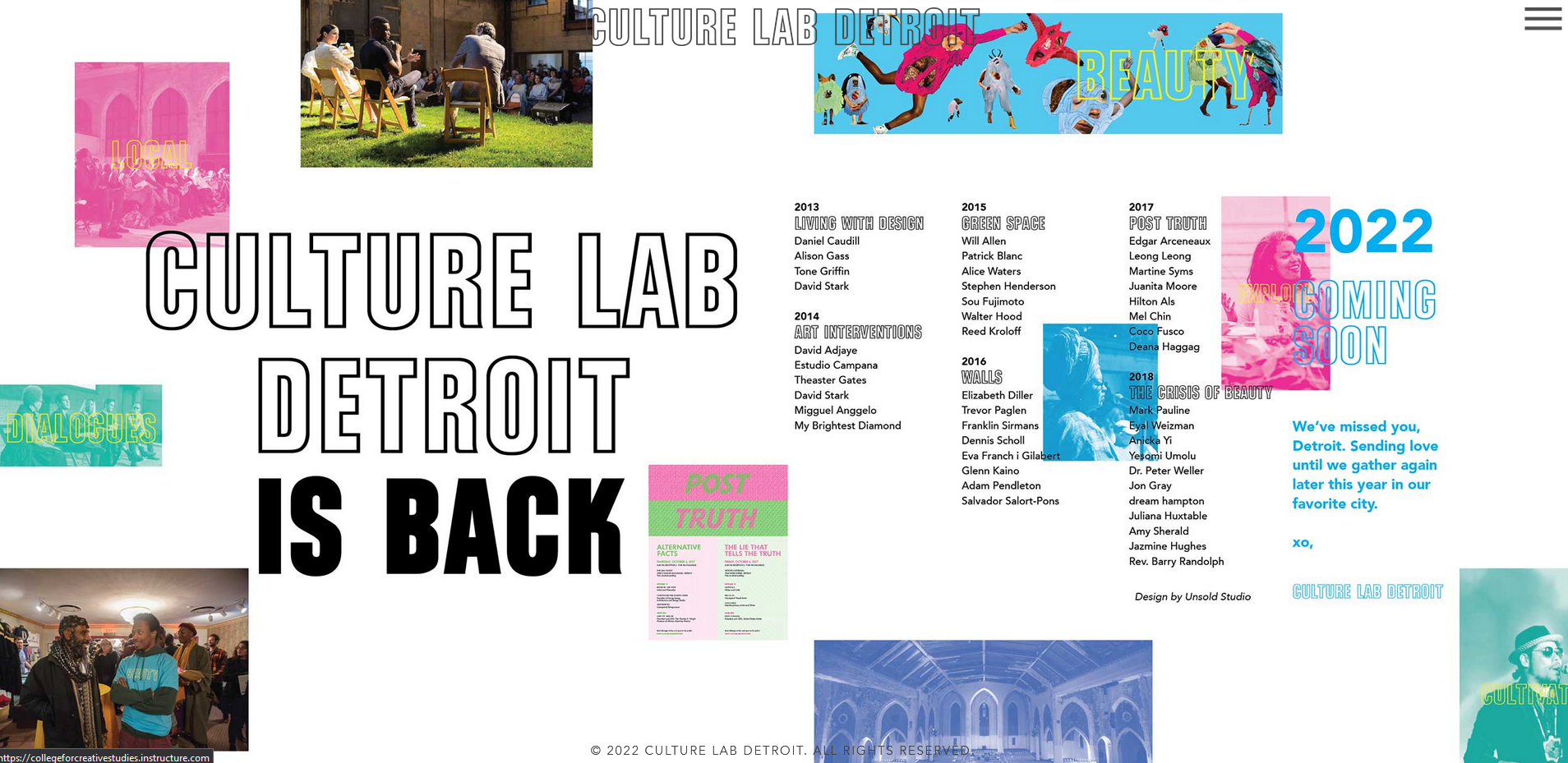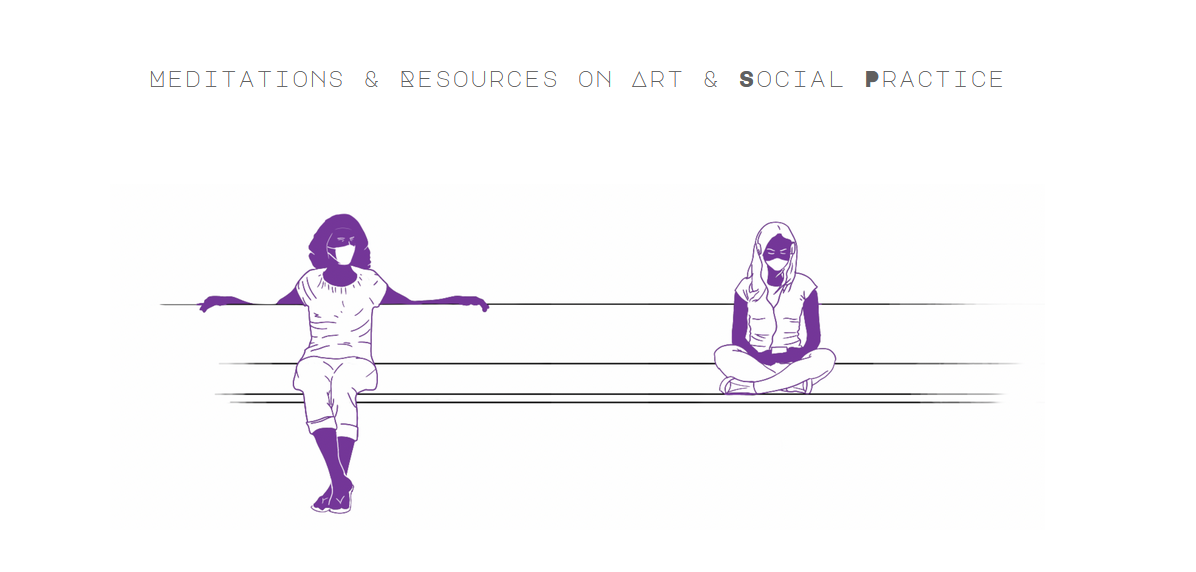
Michael STONE-RICHARDS is a scholar-teacher of critical theory / biopolitics, comparative literary / and visual studies, Social Practice, and the history and theory of modern and contemporary art practice. He has published widely in French and English on the avant-garde in poetry, critical theory, and art. Since his arrival in Detroit, he has become deeply involved in the various parts of its arts and performance community, beginning with MOCAD, where he was a founding member of the Program Committee and a co-curator of the exhibition ReFUSING Fashion on Rei Kawakubo and Comme des garçons; he has also served on the founding board of advisors for the Kresge Arts in Detroit, and is a long-time member of the board of the Friends of Modern and Contemporary Art at the DIA. He has many engagements in the city and organizes the open-format Conversation in the Park which he co-curates with artist Addie Langford as well as collaborations with artists and writers with whom he shares a practice of the Banquet of friends (convivial strategies), and with his students the friendship of collaborative work, thought, and celebration. These engagements with Detroit will continue as part of his appointment as Dean of Programs and Partnerships at Cranbrook Academy of Art.
Michael is the author of Logics of Separation (2011), “Néo-Stoicisme et éthique de la gloire: Le baroquisme chez Guy Debord” (2001), “Failure and Community: Preliminary Questions on the Political in the Culture of Surrealism” ( 2003), and numerous studies on the poetry of Theresa Hak Kyung Cha, J.H. Prynne, Paul Celan, and the Negro Spirituals as well as essays in art writing dealing with McArthur Binion, Donald Judd, David Hammons, Arthur Jafa, Theaster Gates, Sonya Boyce, Scott Hocking, Okwui Enwezor, Rei Kawakubo, and fashion and Surrealism. His current research bears on questions concerning the ethics and politics of Care; pedagogy and transmission in the art + design school of the 21st – Century; curatorial practice; Blackness and biopolitics; the French analyst Solange Faladé; and the language of moral perfectionism in the work of Simone Weil, Guy Debord, and John Berger.
Michael has taught at Northwestern University (Art History and Comparative Literature), then English and Comparative Literature at Stonehill College, Boston, and critical practice and visual studies at CCS in Detroit. His translations from the French - Surrealism, Reverdy, Martine Broda, Blanchot - are an integral part of his conception of critical practice. With the support of a Knight Foundation grant, Michael was the founding editor of Detroit Research, devoted to a broad comprehension of visual and critical studies in choreography, ceramics, performance, post-studio art / Social Practice, and critical theory. With Addie Langford, he recently established Hors Commerce: Detroit Research Collection for the publication and free circulation of new work in critical practice. He also served as Executive Director of the Modern Ancient Brown Foundation (created by McArthur Binion) in Detroit where he set up the Core Program of Visiting Fellows and a post-bac artist residency as well as offering support to artists and institutions across Detroit and beyond (such as Black and Brown Ballet).
Michael is currently Dean of Programs and Partnerships, and Head of the Program in Critical Studies at Cranbrook Academy. Prior to his appointment at Cranbrook, he had been a Visiting Fellow in Critical Studies at Cranbrook Academy of Art, a Fellow at the Centre canadien d’architecture in Montréal, and a Fellow at the Alice Berlin Kaplan Center for the Humanities, Northwestern University. He has received a Graham Foundation Grant for his work on Guy Debord and recently received a Warhol Foundation Grant for his book in progress on Care of the City (forthcoming Sternberg Press / MIT). Living Exposure, from David Hammons to Arthur Jafa: Essays in Art Writing is also forthcoming.
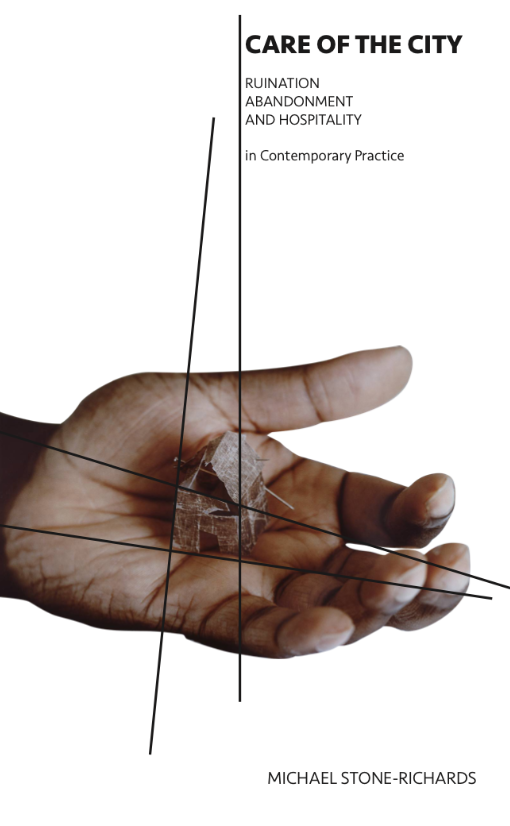
Care of the City is a set of exploratory readings in Critical Practice at the intersection of critical theory with spatial and social practices. What is a city that Care might be part of its nature? The roots of the word Care reveal anxiety, sorrow, attention, lament. Care is both affect and capacity, and one consonant with the political global condition. Everywhere the political condition is marked by retreat, collapse, withdrawal – from treaties, systems, values, social compacts – and no country or region is spared, not even the most privileged of countries or regions which can often be the most hysterical. And just as the globalizing condition, the condition of expansion ironically at one with symbolic contraction, leaves retreat and social collapse in its wake, strangely there is an emerging response of a kind of weak “power” (in the way that gravity is said to be a weak force): the refusal of dominion in favor of Care. In the most fundamental sense, the radical anxiety produced by retreat and collapse of social compacts and values has produced an equally radical awareness not only of mutual interconnectedness with, but dependencies upon, environments, nature, and peoples, that is, entanglements which are often not visible when power works smoothly. Care is the name for the response to this exposure, and the subject across a set of approaches in social / spatial practices / and the poetics of the city. Care of the City is a sustained reflection on this condition of radical exposure through the work of practitioners and poets – Paul Chan with Beckett, Rilke and the League of Revolutionary Black Workers, John Akomfrah with Homer’s Odyssey, Theaster Gates with Auden on the need to “rebuild our cities not dream of islands,” Jim Gustafson, Proust, and Paul Valéry in Detroit with Tyree Guyton’s Heidelberg Project and Scott Hocking’s ephemeral structures marking sites of erasure, and Alfredo Jaar and Chantal Akerman with Guy Debord in the rethinking of boundaries / immigration / emergencies.
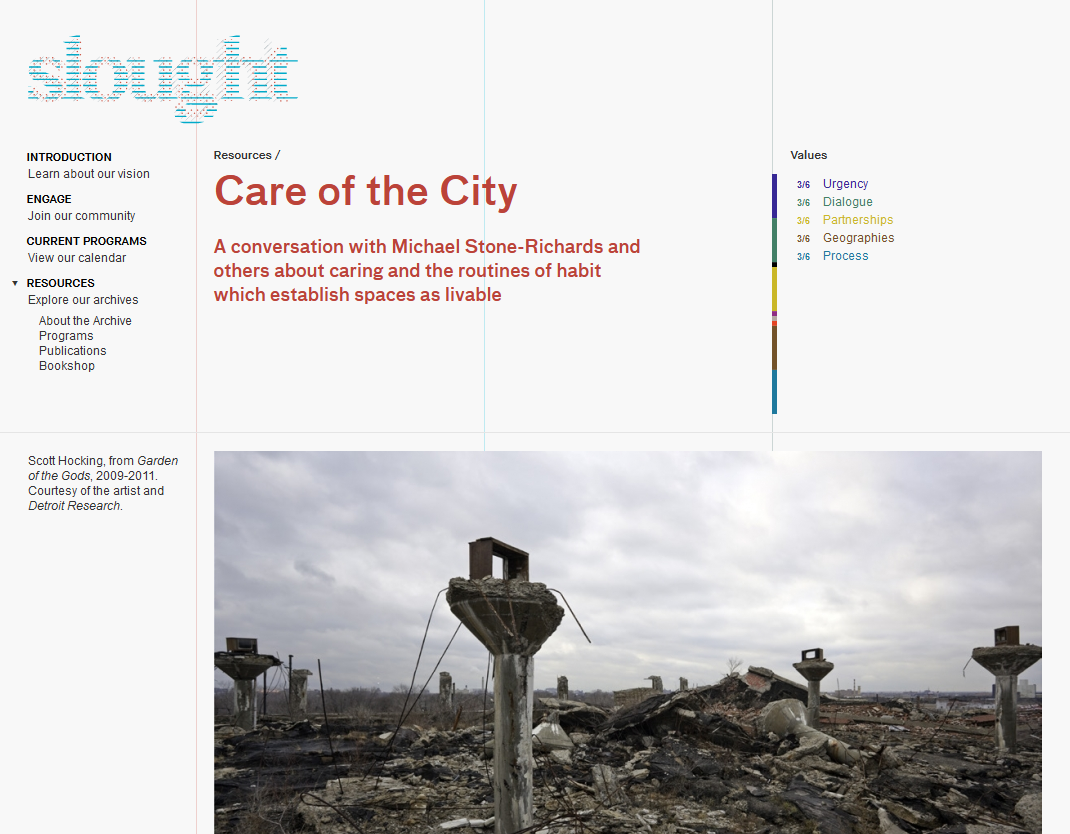
Curated by the John Cage Trust, Bard College and the Slought Foundation, Performed on the 30th of October Museum of Contemporary Art: Detroit. 2016. Recorded Live.
The great English aesthete Adrian Stokes once said that modern art had accomplished much but that there remains a powerful need for an aesthetics of domesticity. What a remarkable thing to have said! For we do not normally go to art or aesthetics to talk about …domesticity! We go to art, it is said, to be lifted up, to be made to feel the spiritual, to be taken out of oneself, indeed, to forget domesticity. (Is it an accident that in the Detroit art scene there has never been any sustained reflection on domesticity?) Stokes, however, was onto something for one of the great accomplishments of modern art in its avant-garde practices - practices most readily associated with Surrealism, the Situationist International, and Judson Dance – and shared with ordinary language philosophy and critical thought from Wittgenstein to Cavell, from Heidegger to Erving Goffman and the Feminist ethic of Care tradition is the recovery of the everyday as the ground of all human existence. When Heidegger made Care (Sorge) central to Being and Time, central that is, not only to philosophy but to the comprehension of existence, he also made the everyday central to philosophy and existence. When Heidegger said that Care is the response to the radical anxiety experienced when confronted with the collapse of familiarity, he meant the collapse of the everyday, of the ordinary, of all the things that we take for granted – the habits, routines, unexamined practices – that make up our social identities. The collapse of familiarity rips these away from us and leaves us exposed and vulnerable but also as a result able to be-alongside others (strangers as well as environments) without the social masks that we inhabit and through which we project our fears as means of defense of our social roles. At the same time, the collapse of familiarity is the collapse of the domain of the domestic sphere: the home with its rituals and manners of welcome and sheltering; the home and practices of domesticity that we take for granted, whose securities and memories are the background of subjectivity and our ability to face the world – as Rilke wrote “Whoever has no house now, will never have one. / Whoever is alone will stay alone” (“Autumn Day,” trans Stephen Mitchell). In the time of COVID-19 – the desolate time, the destitute time, the meager time, the distressful time – there is much talk of economics (“re-opening the economy” is the phrase) but little to no attention to where the real damage is being enacted: in the sphere of domesticity. What happens when the domestic is no-longer-at-home?
- Michael Stone-Richards
- Unless “we” fall into a state of exception we are all citizens and any and all ethical or political responsibilities befall us qua citizens.
- There is no political or ethical responsibility that the artist or designer qua artist or designer has that the citizen does not first possess qua citizen, and we cannot design citizenship, we can only sustain a fragile culture of citizenship.
- When Beuys wrote that Jeder Mensch ist ein Künstler – We are all artists – this was in part a statement about radical democratic potentiality, akin to Simone Weil: We are all capable of creative action. What pre-empts or interrupts the flowering of such action remains the question of questions that no traditional idea of art or design can comprehend methodologically or epistemologically.
- Participation is existence. Its opposite is alienation. If so, why so much talk of participation? What impedes participation? To speak of participation here is first to draw upon the etymological sense of participation, namely, to have a share or a part in something; but participation is also a movement – intentional, affectively expressive – by which we grasp possibilities and meanings always a part from the locus of movement; above all, participation is world-building practice. Here participation reveals an important feature of our existence, namely, that human existence is always existence or movement in a world beyond bare life, beyond, that is, the Cave. We should more properly speak of an event of participation between partners in the community of being, that is also the City, and as such a phenomenon of shared and complex creation. The restriction of movement is the restriction of existence itself, and this is the basis of being able to say that participation is existence. If though what is also intended is political participation, as must be the case, and all participation is conflict, it should be realized à la Hegel, as Charles Taylor put it succinctly, that “the aspiration to total and complete participation is rigorously impossible,” and would only serve to magnify the conflict inherent in all human activity. Markus Miessen has made much of this Hegelian insight in his meta-thinking on design. What kind of participation and in what kind of community of affect or shared interests are questions that might point to an emerging conception of the artist / designer as thinker / interrogator in need of new institutional expressions.
- It is thus ethically required that any restriction of movement, any pre-emption of shared movement that would impede or restrict the modes of existence of any human existence seeking the community of being, the City, should be challenged.
- But is it as artists or designers, that is, in the name of the artist or the designer that the ethical and then political challenge should be made?
-
First, what the great Harvard, French scholar Paul Bénichou first called the sacralization of the artist / writer, namely, the idea that the artist qua artist had a special calling or vocation, that is, a secularized but still priestly role, is not something that can any longer be taken seriously. Strictly speaking, it was not first and foremost a Romantic idea. It was an idea born of the French Revolution but it expired with Late Romanticism and was critically buried with the various New Art Histories and Cultural Historicisms of the post-1968 generation of critical theorists.
- And what if design, the pre-critical idea of design as solution to problems of efficacious structure, is part-and-parcel of the problem? Is there a competence unique to designers that entitles a generalization to the level of practice as the Marx of the “Theses on Feuerbach” understood practice, that is, as the dynamic totality of embodied social relations? As Beatriz Colomina and Mark Wigley put it in their recent critical history of design, Are we Human? Notes on an Archeology of Design (Lars Müller, 2016):
The nineteenth-century dream of “total design” has been realized. The famous slogan of the 1907 Deutscher Werkbund “from the sofa to city planning,” updated in 1952 with Ernesto Rogers’s “from the spoon to the city,” now seems far too modest when the patterns of atoms are being carefully arranged and colossal artifacts, like communication nets, encircle the planet. Designers have become role models in the worlds of science, business, politics, innovation, art, and education but paradoxically they have been left behind by their own concept. They remain within the same limited range of design products and do not participate fully in the expanded world of design. Ironically, this frees them up to invent new concepts of design.
Ironically, that is, the expanded world of design would free up designers to leave behind the lazy emphasis upon products, making things, stuff, and designing places for stuff to occupy. Colomina and Wigley quote Lina Bo Bardi as saying that “The grand attempt to make industrial design a motor for renewing society as a whole has failed – an appalling indictment of the perversity of the system.”
- Design in the expanded field, let us call it – why not! – does not have its pedagogy and is emerging without designers or institutional base in design schools. It is not merely 3-D replicators that will soon make definitively redundant traditional ideas of the skill of making, so, too, will the emergence of self-organizing, self-replicating auto-poietic systems. The question of what participation, an event of participation between partners in the community of being, will then mean will have a new urgency.
- Again, to quote Colomina and Wigley:
At the very least such an expanded conception of design as interrogation would not only jettison the concern with stuff, it would expand its thinking into a care beyond the human – our companion species with which we also participate – and become part of a critical activity of biopolitical thought and the non-alienating activity alone worthy of being called participation.
Michael STONE-RICHARDS
This set of theses was delivered as part of the panel “Citizen-Artist – The Role of Participation” convened by Amy Deines at the annual AICAD conference held in 2019 in Chicago.
Research / Art + Pedagogy / or, Time in Critical Practice
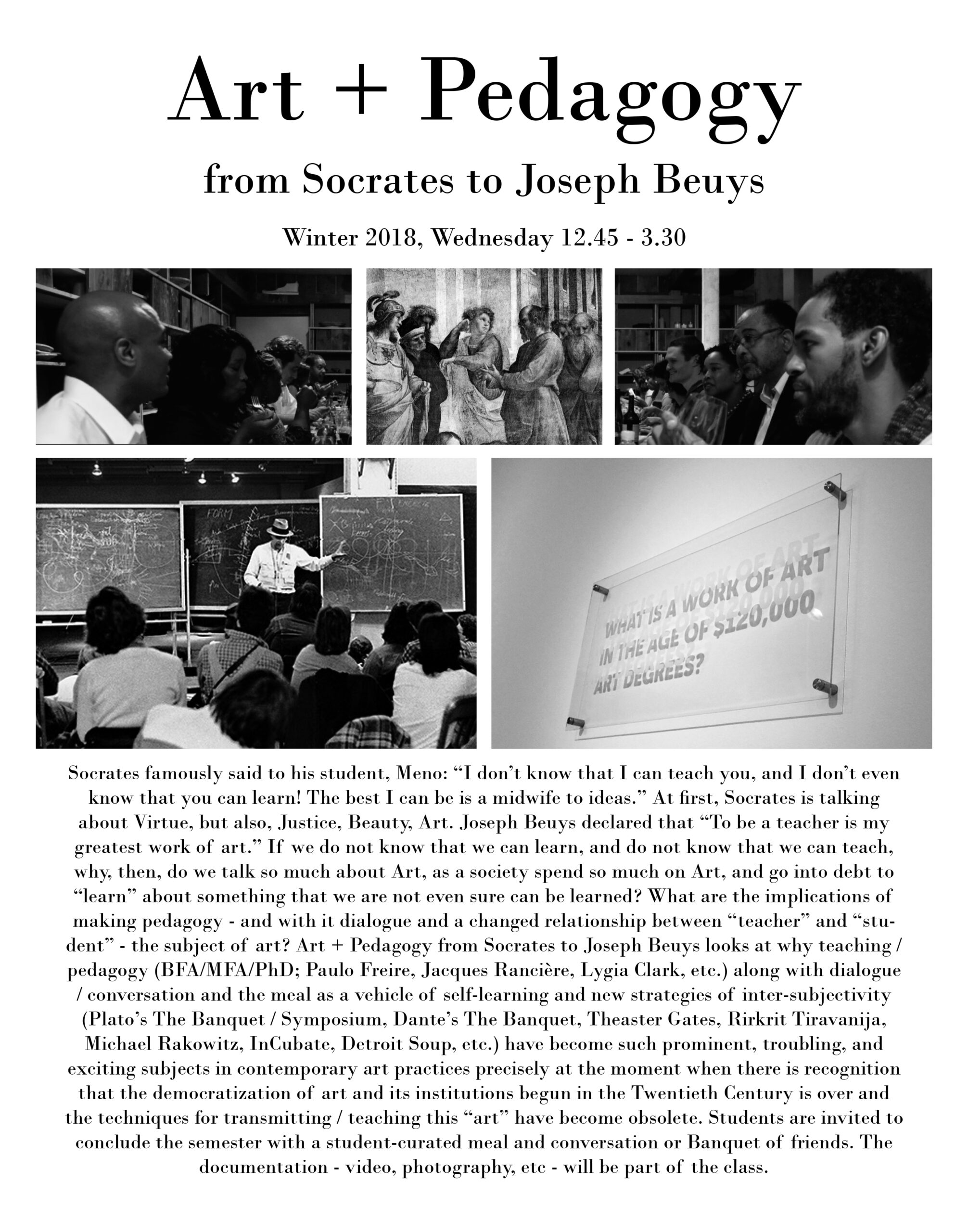
The passions ignited by discussion of Asher’s post-studio crit – and not a single student had ever heard of Asher, still less his post-studio class – stunned me. I have not infrequently been in a situation when class discussion takes off and as a teacher one becomes an engaged observer trying to stay out of the way, but this went on for three weeks before I said that I would re-work the syllabus and pursue new but related pistes. - For example, Robert Irwin would enter the new iteration of the seminar.
I have a precise memory – and notations – of what was said during these discussions, but let me start here: Students themselves must take some responsibility for the failure of Crits. I was struck by the maturity of this recognition and the quality of the observations which it provoked. Even more, however, the Crit itself was the problem. In Asher’s practice, on the other hand, students saw a whole new practice of temporality and agency: that a Crit might run for 12 or 15 hours did not frighten them but instead excited them; that the “professor” did not speak, or barely so, intrigued them, even more so as they would come to grasp that the implied practice of listening and utmost presence left students to come to their own realizations about the strength and weaknesses of their work;4 from this many students started a discussion about the role of duration in the Crit, being durationally embedded, both instructor and students, hence no outsiders joining the Crit simply to talk about their own taste or aesthetic; above all, what they got a hold of tight was the idea that the silence of the instructor in the practice of the Crit meant that the work was not there to be turned slowly into a copy of their instructor’s work or become an instance of the instructor’s taste. Here Robert Irwin joined Asher – my own deep interest in Irwin was wholly due to one of the most important CCS alums, the artist Michael E. Smith, whose work is in dialogue with Irwin’s thinking on spatiality - especially the Irwin who observed:
Point 1: A main aim of the class was to consider the nature and purpose of teaching / learning as the transmission of values that constitute a field of practice, knowing that, as Plato explored in the Socratic dialogues, values and ideas die and so there is nothing inevitable or necessary about a particular set of ideas that is being currently taught.
Point 2: We read Howard Singerman’s exceptional book, Art Subjects,3 on the history of the MFA in the American academy and how the MFA was explicitly never intended to become, and is not to this day, a degree connected with the ability to teach.
All the time my ideal of teaching has been to argue with people on behalf of the idea that they are responsible for their own activities, that they are really, in a sense, the question, that ultimately they are what it is they have to contribute. The most critical part of that is for them to begin developing the ability to assign their own tasks and make their own criticism in direct relation to their own needs and not in light of some abstract criteria. Because once you learn how to make your own assignments instead of relying on someone else, then you have learned the only thing you really need to get out of school, that is, you’ve learned how to learn. You’ve become your own teacher.5
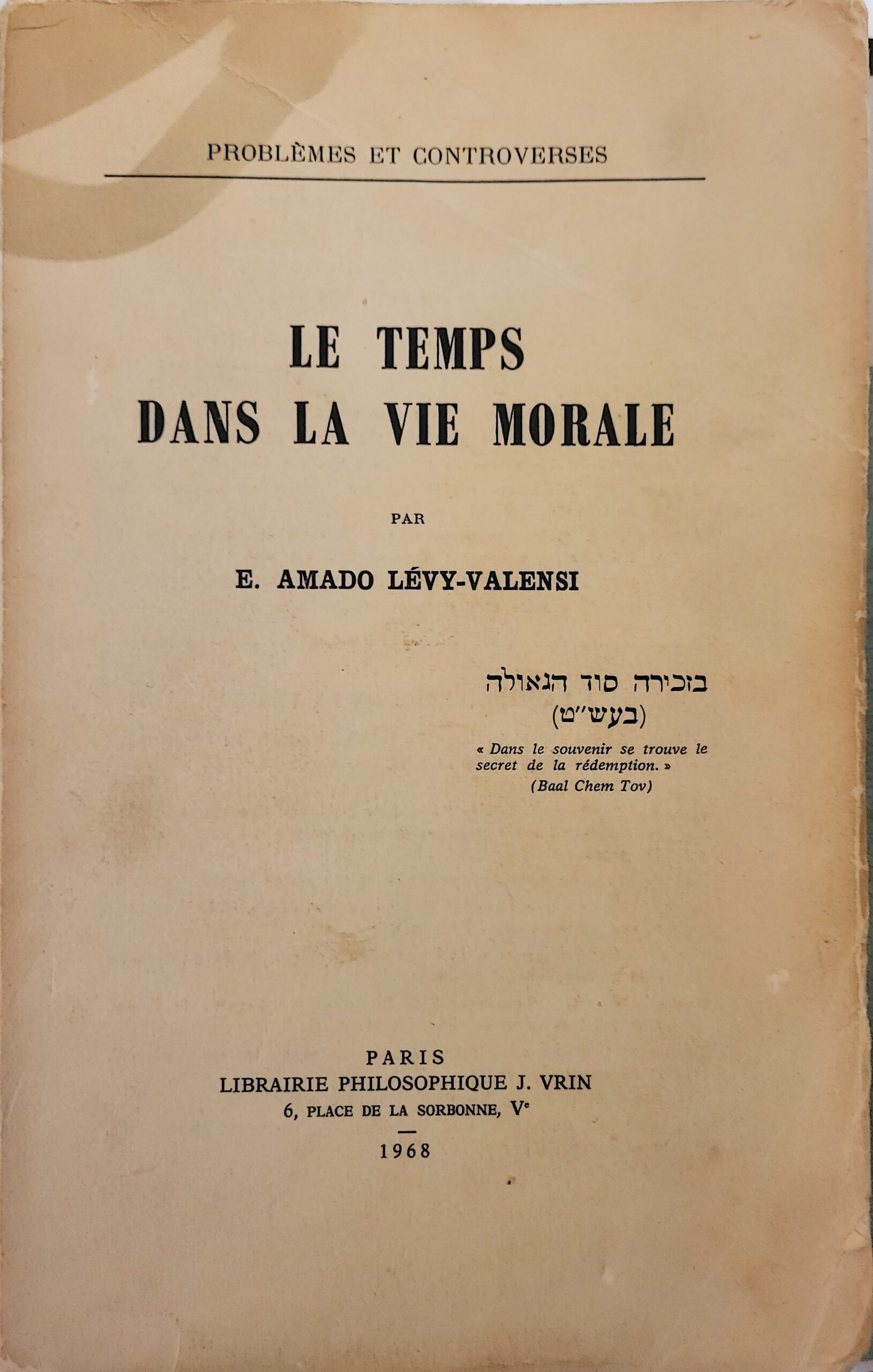
Observation 1: A key question that emerged from discussions on the Crit, a question which formulated a concept, was the following: What do we want a Crit to be: an artisanal imprinting or a critical practice? Artisanal imprinting pointed to the absorption of the instructor’s studio practice6 the best version of which might be, say, a conservatory approach, whilst the idea of a critical practice, pace Asher, Irwin, but also Roland Barthes’ conception of co-creation and mothering in the space of the seminar, that is, the shared space of learning, pointed to critical practice, research, and knowledge.
Observation 2: There was a fascination with Barthes’ conception of co-creation and mothering as developed in his “To the Seminar”7 – the genre of the German lieder An die Musik (with reference also to Rilke) was discussed as also the transferential dimension in learning – from which the following question: What if the Crit as conventionally established is a refusal of co-creation? This led to an examination of the mothering aspect of Asher’s post-studio crit, that is, the space of the Crit as an envelope jointly created by all who participate.
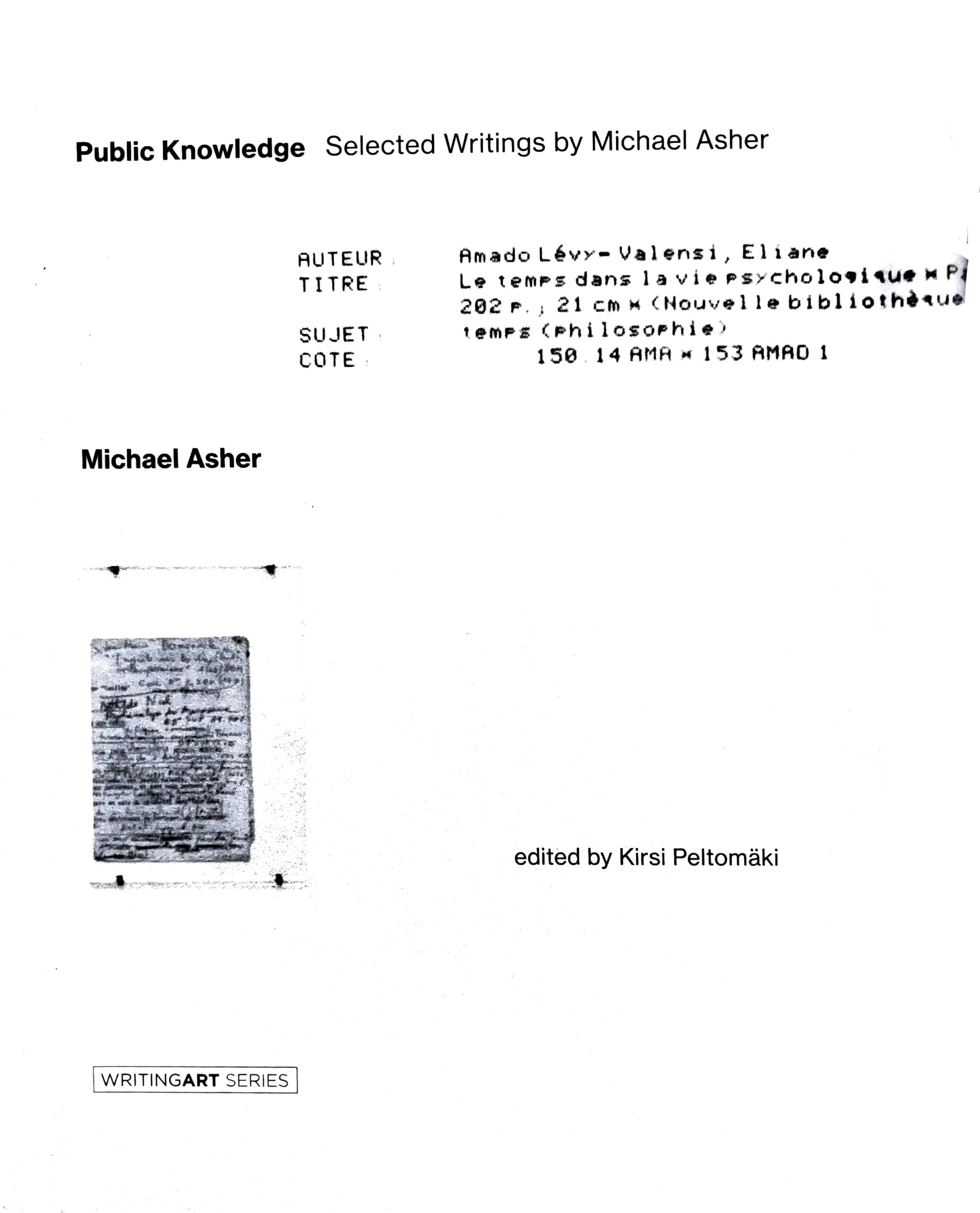
Cover of Public Knowledge: Selected Writings by Michael Asher, 2019.
The cover shows an installation detail of a work in the Centre Pompidou’s Michael Asher, 1991.
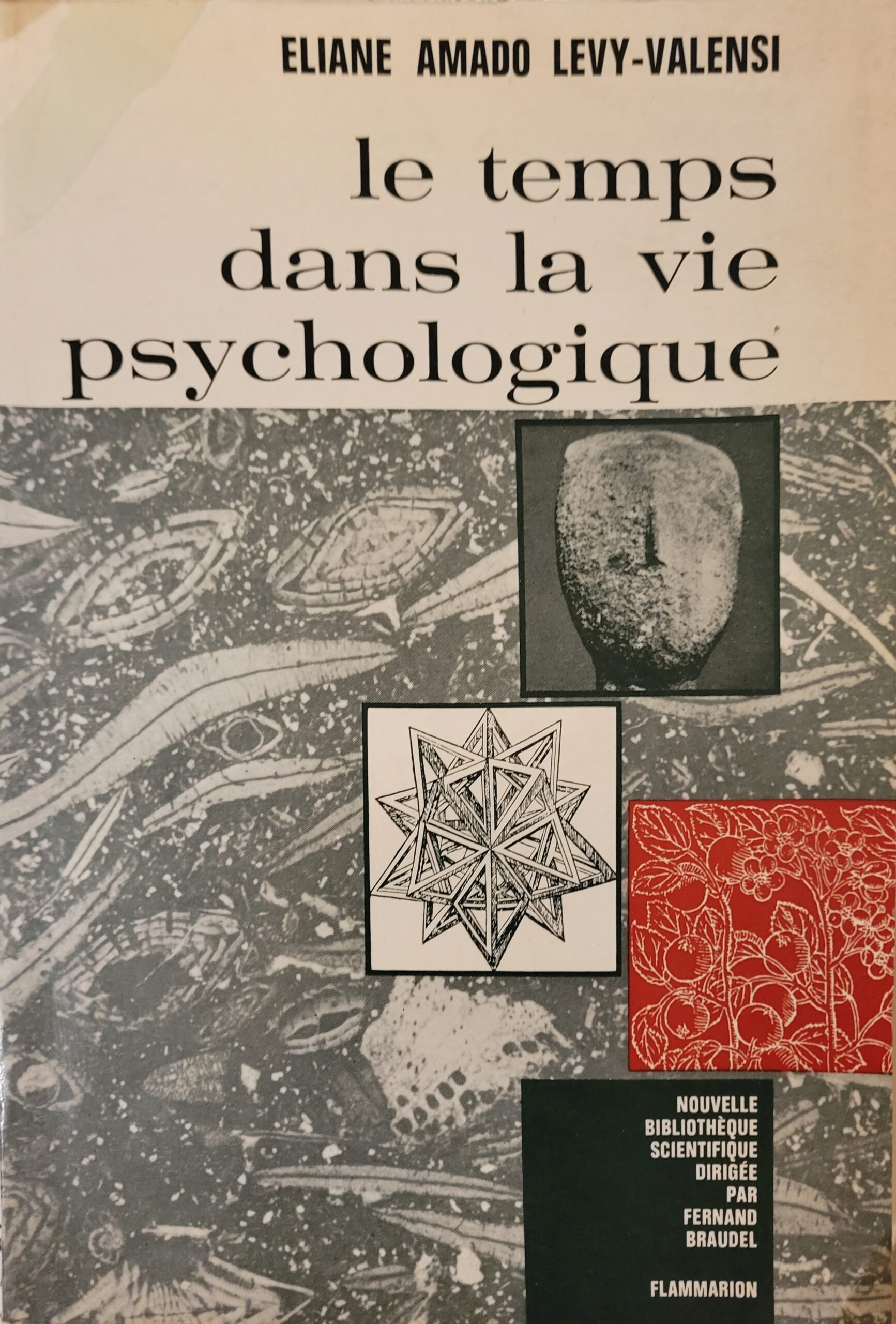
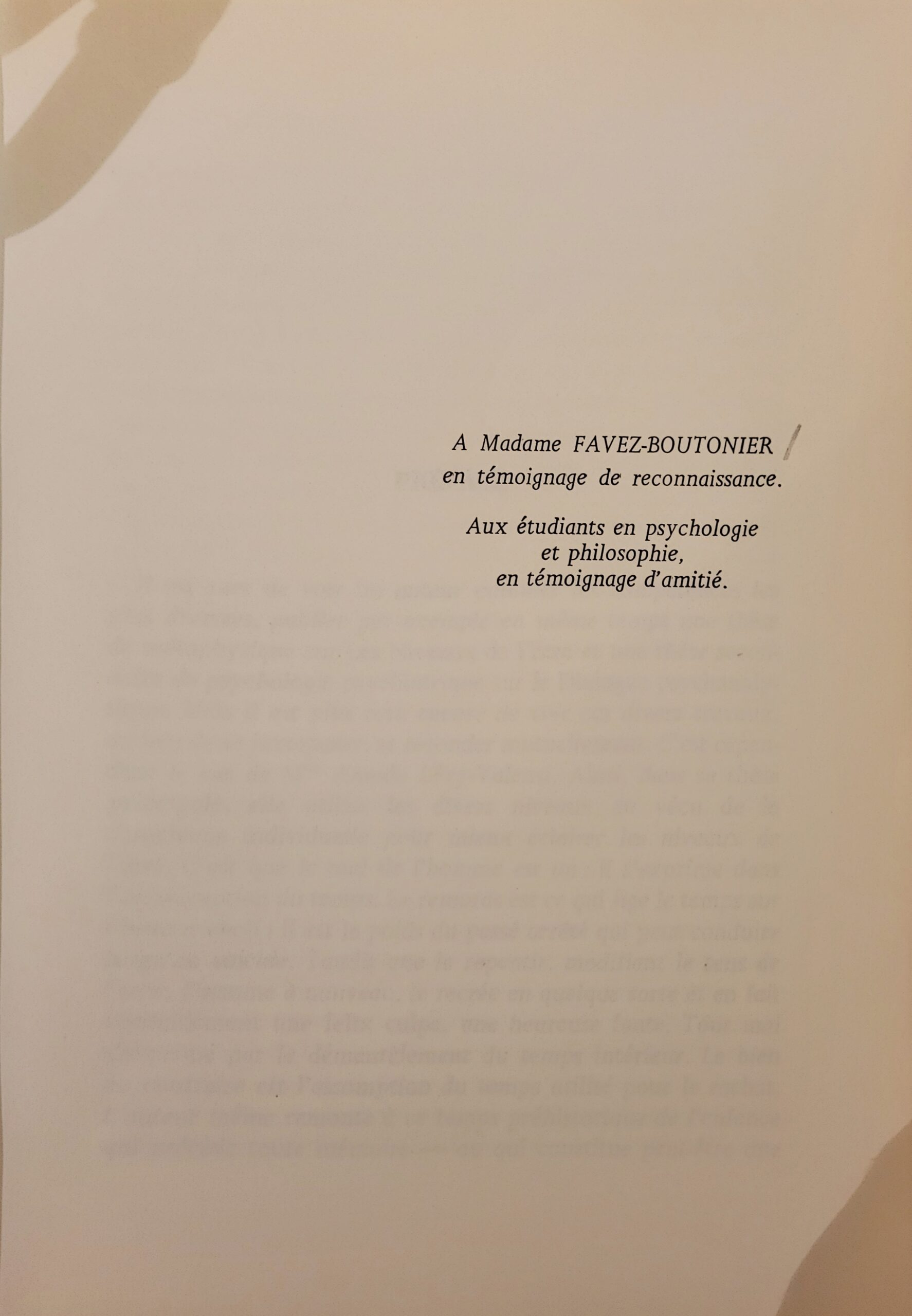
All cultural progress, by means of which the human being advances his education, has the goal of applying this acquired knowledge and skill [that is, practice, MSR] for the world’s use.13 But the most important object in the world to which he can apply them is the human being: because the human being is his own final end. – Therefore to know the human being according to his species as an earthly being endowed with reason especially deserves to be called knowledge of the world [emphasis in original], even though he constitutes only one part of the world.14
Kant goes on to clarify his sense of pragmatic anthropology by saying such knowledge of the world is only called pragmatic “when it contains knowledge of the human being as a citizen of the world.”15 In this respect Kant’s pragmatic knowledge is here a transition between the classical Aristotelian view of practice and the modern view of praxis as formulated by Marx and re-transmitted by Althusser. It is also fundamentally the basis for any critical account of practice as central to the modes of contemporary art as critical engagement with world-making and demystification of representations, that is, the ideologies masked as realities which serve to distort the relations to the world. Eventually this mode of thinking about practice and pedagogy in the art and design school would become formulated using the established language of the PhD, namely, that document of research that makes a contribution to knowledge, or, in the language of Critical Practice, the production of knowledge since there must always be awareness of the material conditions of knowledge-production. (It is, of course, by no means clear that Asher would have been invested in the idea of the PhD in Art, and certainly not as a qualifying degree for teaching.
Life consists in learning to live one’s own, spontaneous, freewheeling: to do this one must recognize what is one’s own – be familiar and at home with oneself. This means basically learning who one is, and learning what one has to offer the contemporary world, and then learning how to make that offering valid.
The purpose of education is to show a person how to define himself authentically and spontaneously in relation to his world – not to impose a prefabricated definition of the world.20

Endnotes
[1] On Detroit Soup, see Amy Kaherl’s “Dinner Music,” her memoir in progress, in this issue of Detroit Research and her reading online at Detroit Research website.
[2] Cf. Sarah Thornton, “The Crit,” Seven Days in the Art World (New York: Norton, 2009), 41-74.
[3] Howard Singerman, Art Subjects: Making Artists in the American University (Berkeley: University of California Press, 1999).
[4] I continue to see in this practice of listening and agency for the students a version of what the Lacanians of the École freudienne de Paris, between 1967 – 1969, called la Passe (the pass), which was an experiment in the very foundations of institutionality by allowing candidates for the status of analysts to declare themselves when ready to assume the role of analysts. It was a dangerous but still important idea especially worthy of further investigations precisely in a culture of the artworld where no one believes that the acquisition of a degree eo ipso confers the status of artist – thus a denial of the performative act of conferring a degree - thereby bringing into question what kind of education (or training?) it is that one has received as well as to foreground, going forward, what education for art and design might become as economic and demographic pressures mount on all aspects of post-secondary education. And yet the art degree – what a practitioner like Rick Lowe, in the context of Social Practice degrees, refers to somewhat contemptuously as credentials – retains a gatekeeper function to the Artworld. That there is a pedagogical dimension to Asher’s practice is evident - institutional critique is nothing if not pedagogical - the question, rather, is how to read the pedagogical dimension, and its (latent?) Lacanian registers. Here the presence of Lacan in the Centre Pompidou’s Michael Asher (1991) could be a starting place. In the Art + Pedagogy seminar we have explored this dimension of Asher’s practice through an ethics of temporality as this bears on but without being limited to the Crit.
[5] Robert Irwin, quoted in Lawrence Weschler, “Teaching,” Seeing is Forgetting the Name of the Thing One sees: A Life of Contemporary Artist Robert Irwin (Berkeley: University of California Press, 1982), 120.
[6] As one student commented to the class: “There was a moment when I realized that all that I was being taught was my teacher’s studio practice!”
[7] Cf. Roland Barthes, “To the Seminar,” The Rustle of Language, trans. Richard Howard (Berkeley: University of California Press, 1989), 332-342. The BAK art school in Utrecht organized an artist symposium on the critical practice derivable from Barthes’ “To the Seminar.” See the discussion moderated by Vivian Sky Rehberg in 2017 at https://www.youtube.com/watch?v=yNKzPgP8gkU.
[8] Cf. Herbert Marcuse and Bryan Magee, “Marcuse and the Frankfurt School: Dialogue with Herbert Marcuse,” in Bryan Magee, Men of Ideas: Some Creators of Contemporary Philosophy (London: BBC Books, 1978), 61-73; on Critical Theory as negation of philosophy (in parallel with Heidegger’s negation of metaphysics, and the avant-garde negation of art and poetry and music), cf. Herbert Marcuse, “The Negation of Philosophy,” Reason and Revolution: Hegel and the Rise of Social Theory (1941) (London: Routledge and Kegan Paul, 1955), 258-262. It would be relatively easy to show that Critical Studies as developed in the contemporary and international art + design school is the discursive disciplinary / pedagogical equivalent of Critical Theory, that is, Critical Studies is the negation of liberal arts in favor of a new critical practice developed from the intersection of Critical Theory and art + design understood as discursive formations. Within university culture - where “humanism” can indeed have richly innovative defenders - “liberal arts” is an all but meaningless term as disciplinary transformations have all but made liberal arts as a foundation of knowledge redundant. Certain important institutions such as Stanford, Chicago, Columbia, or St. John’s College which have a commitment to (an expanded conception of) a Great Books approach cannot be understood as teaching liberal arts in the ordinary sense, rather they have become a training ground in a certain mode of perception through reading (whether the text being read is mathematical, astronomical, or literary).
[9] On the question of the PhD / terminal degrees in the Arts, see the very illuminating NASAD Policy Analysis Paper, “Thinking about Terminal Professional Degrees in Art and Design,” October 1, 2004. Available at https://nasad.arts-accredit.org/publications/assessment-policy/nasad-policy-analysis-papers/. Accessed 05 – 23 – 21.
This document makes clear the extent of tension within the Art + Design school over the issue of the PhD in the Arts as a new terminal requirement; equally clear is NASAD’s refusal to take an official side in the debate.
[10] And the Conservatory is the highest form of this practice – the Conservatory in music, in acting, etc. Might it be possible to think of Black Mountain College, in its time, as an experimental Conservatory? Where, that is, the conservatory is a stricter community of interests and passions, more singular in its orientation, with no obligation to an abstract “general education”?
[11] Michael Asher, “Notes on professional degrees in studio art” (ca. 1988), in Public Knowledge: Selected Writings by Michael Asher, ed. Kirsi Peltomäki (Cambridge, Mass.: MIT Press, 2019), 203.
[12] Stephan Pascher, speaking with Michael Asher, “Conversation with Stephan Pascher on Teaching” (2005), in Public Knowledge, 235.
[13] For the world’s use, that is, practice – if it is not simply the production of stuff – must be reflexive. The production of things, to be clear, is also one sense of Aristotelian poiesis.
[14] Immanuel Kant, “Anthropology from a Pragmatic Point of View,” in Anthropology, History, and Education, ed. Günther Zöller and Robert B. Louden (Cambridge: CUP, 2014), 31.
[15] Kant, “Anthropology,” 231-232. Emphasis in original.
[16] It does not hurt because some person in authority wants to abuse their authority, impose their prefabricated knowledge on a young mind in the name of a personal conviction, which amounts to little more than a form of abusive implantation. The Socratic example shows that learning must also hurt for the person who would presume to call themselves teacher, not least, as Kierkegaard explored in his readings of the Meno, because the teacher may not be able to teach – think Moses in Schönberg’s Moses und Aron (1932 / 1957) – or because what there may be to teach may not be transmissible – think, say, Hölderlin’s Empedocles or Paul Celan’s “Pallaksch. Pallaksch,” for which cf. Paul Celan, “Tübingen, Jänner,” Die Niemandsrose / NoOnesRose, in Memory Rose into Threshold Speech: The Collected Earlier Poetry, trans. Pierre Joris (New York: Farrar, Straus, and Giroux, 2020), 264-266; and cf. Søren Kierkegaard, “Thought-Project,” Philosophical Fragments, trans. Howard V. Hong and Edna H. Hong (Princeton: Princeton University Press, 1985), and Kierkegaard, “The God as Teacher and Savior,” Philosophical Fragments, 23-36; and finally, Jacques Lacan’s Séminaire II on “Questions à celui qui enseigne,” Le moi dans la théorie de Freud et dans la technique de la psychanalyse (Paris: Seuil, 1978), 241-257.
[17] Samuel Beckett, Proust (New York: Grove Press, 1981), 21.
[18] Cf. “Aporias of Attention,” forthcoming in Michael Stone-Richards, Care of the City (Berlin: Sternberg Press).
[19] Paul Celan: “ ‘Attention’, if you allow me a quote from Malebranche via Walter Benjamin’s essay on Kafka, ‘attention is the natural prayer of the soul’.” Paul Celan, “The Meridian,” Collected Prose, trans. Rosemarie Waldrop (Manchester: PN Review / Carcanet, 1986), 50; and Simone Weil: “Attention, taken to its highest degree, is the same thing as prayer. It presupposes faith and love.” Simone Weil, Gravity and Grace (1947), trans. Emma Crawford and Mario von de Ruhr (London and New York: Routledge, 2002), 117. Faith is a translation of the Greek pistis, also trust. Learning presupposes trust, but the classroom is also an arena of love, and this is what all reflections on transmission / transference come to realize.
[20] Robert Merton, “Learning to Live,” Love and Living, ed. Brother Patrick Hart (New York: Harcourt, 1979), 3.
[21] My own thinking on the question of transmission has long been shaped by Wladimir Granoff, Filiations: L’avenir du complexe d’Oedipe (Paris: Minuit, 1975), but also Solange Faladé’s final seminar for the École Freudienne before her death on La Transmission (2001 – 2002).
[22] Cf. the “Conversation” between Michael Craig-Martin and John Baldessari in Art School (Propositions for the 21st Century), ed. Steven Henry Madoff (Cambridge, Mass.: MIT Press, 2019), 41-51.
[23] Louis Althusser, “Qu’est-ce que la pratique?” Initiation à la philosophie pour les non-philosophes (Paris : PUF, 2014), 163. Emphasis in original.
[24] Cf. Susan Jahoda and Caroline Woolard, Making and Being: Embodiment, Collaboration, and Circulation in the Visual Arts (New York: Pioneer Works Press, 2020).
[25] Cf. Molly Beauregard, Tuning the Student Mind: A Journey in Consciousness-Centered Education (Albany: SUNY, 2020).
[26] Cf. David Kirp, “Community Colleges should be more than just Free,” The New York Times, May 25, 2012. https://www.nytimes.com/2021/05/25/opinion/biden-free-community-college.html?campaign_id=39&emc=edit_ty_20210525&instance_id=31506&nl=opinion-today®i_id=66849993&segment_id=58953&te=1&user_id=4ee170ec26ea24442e7b658c8dd82fae. Accessed 06-07-21.
Religion and Economy of Affect: A Reading of Love is the Message, the Message is Death
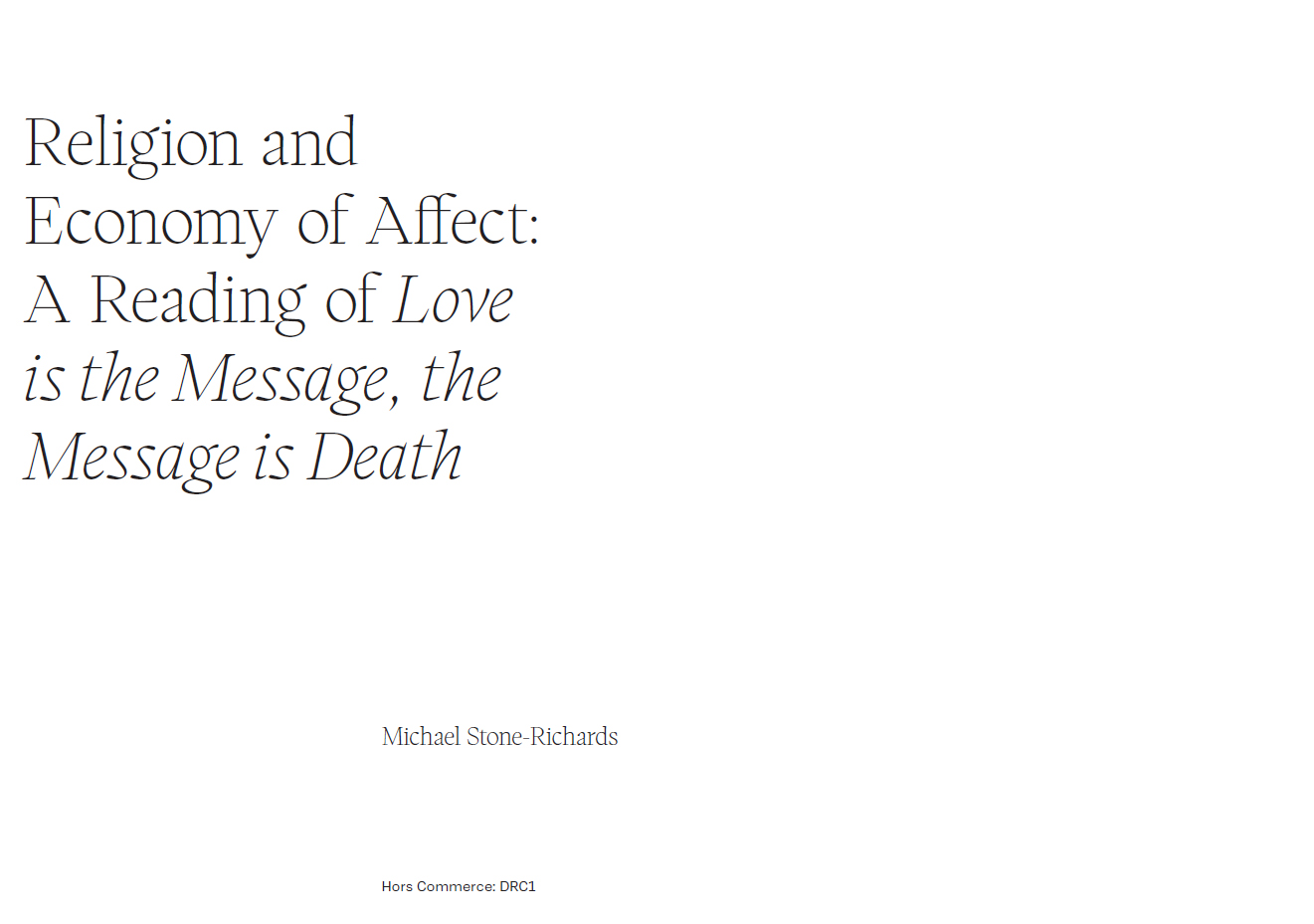
Undernneathness—
Surface—
Work in McArthur Binion
Object—
Attention—
Environment
Retreating/Retracing Space: Scott Hocking’s Diagrams of Visibility
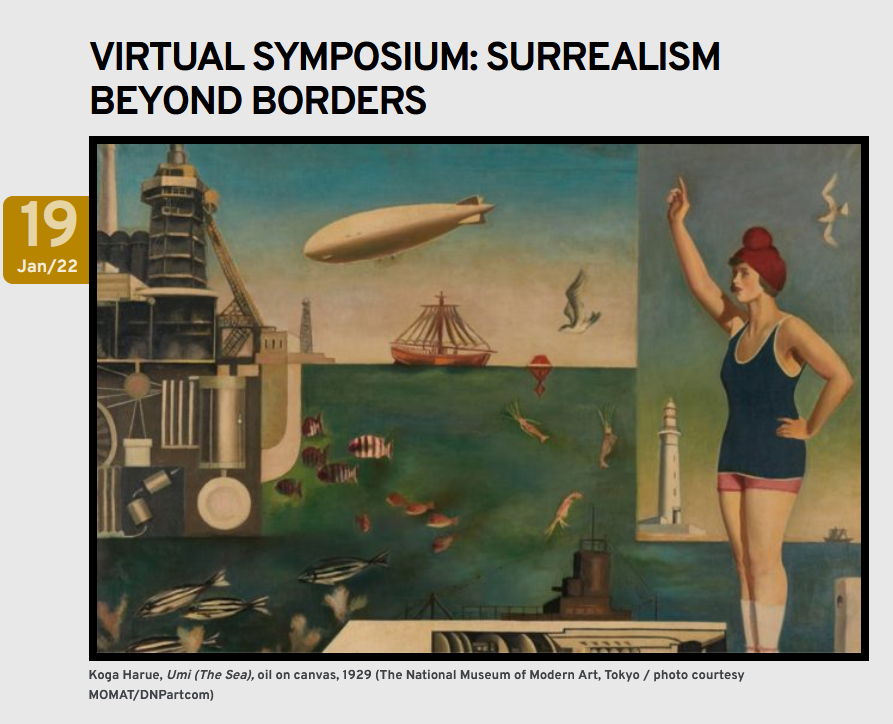
Work is a foretaste - a preliminary
experience - of death.
William Stringfellow, Instead of Death
King Henry VI, Part 2, IV.ii.19-201
The Hand in the painting of McArthur Binion. First, the seductive surface. On approaching the painting of McArthur Binion – whether for the first or the umpteenth time – it is the surface that attracts, that seduces: the textures are soft and rich, delicate in the way that surfaces laid down by slowly made crayon or ink can be, the patient gridded lines clearly hand drawn, the face of the artist bent over closely to the plane, almost breathing on the soft crumbly surface of crayon and ink, the pressure of the hand, the fingers intent/tion – first intention, as it were – not only making but being captured simultaneously, not only depicting but being in the latency of the frame. There are moments, as in the DNA series exhibited in Chicago in 2014, when the surfaces of Binion paintings are like jewels of glistening light and as a viewer one simply wants to hold back a little and not hasten the reveal, not allow any perceptual moment to become too quickly resolved into an image – any image - but simply to allow the play of surface textures made by the varied force and lightness of this touch, this hand, of this artist. Rarely is it such a pleasure not to know, and simply to allow oneself, one’s looking, one’s seeing to be trained by the surface, led by the hand, through the touch of the work. At a certain distance, however, a sense of relief – physical relief – begins to allow itself to be glimpsed, and with it another kind of work, a kind of sculptural work of relief as forms – vaguely – allow hints of their underlying presence through the texture. At first, what seem to be other marks and markings, under-markings, are slowly revealed as letters, in rhythms of letterings, glimpses of words and wordings in groups revealing names / dates / locations sometimes in whole, often in parts. The medium reveals more than one support. Paper, maybe. Names. Numbers. Addresses. Yes. Dates. Or a map. Of Mississippi. Or photographs, fragments of photographs. Portraits / unknown? Anonymous? Self-portraits. Lynching. And all at once the perceptual plane dissolves, re-adjusts itself between the seductive and the repulsive, as if one part of the painting recoils from another in the same temporality as one part of the mind of the viewer also recoils in shock from its own recognition. At first, you, as viewer, think there is something buried – stories, histories – but the painting is a seduction in which the handling of memory is a masking of the blow without which masking there would be no distance to allow the viewer the time of recognition, of acknowledgment. The acknowledgment of work. The memories that are handled as phylogenetic memories, memories, that is, that an individual carries for a group, a species, a people: the child in a large family – in Mississippi – of cotton-pickers. The life of labor for an entire family and people. The geographic displacement of the family along with thousands, eventually millions of others from Mississippi and The South northward in search of work and a different state of mind – 12 Million Voices, says Richard Wright, seeking work and “to escape these marked-off areas of life.” Art is, though, a marked-off area of life for the young Binion, a zone of engagement that allows for needed autonomy from the family, as well as offering a means to reflect upon the labor of the family and the nature of labor to which the family – the species – is condemned, or, too, labor as means of escape, liberation. Suddenly the many beautiful, troubling textures of Binion’s oeuvre seem to assume a figuration – the hand – and a subject: what the hand, the instrument of instruments, as Aristotle put it, does, namely, work in the construction of a world. I think of the recent works – for example, the paintings in dialogue with Saarinen in the recent Binion / Saarinen: A McArthur Binion Project at the Cranbrook Art Museum – of which Route One: Box Two, 2017 [oil paint stick and paper on board] has become something of a talisman for me for the way in which the minimalist grey surface of grids yields to grids nested within smaller grids – from the frame to the clear sense of the division of the picture in two halves, then into larger boxes, each diminishing into a smaller scaled version of itself nested within to reveal the movement of language as a form of light within the smallest hand-drawn and so not quite rigid grid, almost as though the grids, that is, the unit of measurement, are made up of bodies (metonymically: the middle passage?) not abstract (modernist) forms, bodies delivered by hands… The Standard Certificate of Live Birth [in Mississippi] can be read in several of these works including Lehmann Maupin’s Route One: Box Two. The standard is the abstract norm, but the part refers to what has been delivered by hand, namely, the result of labor, the living body of the child. The hand, in Binion’s work, is a stand-in, a metonym, for labor, fragility, death.

For Jane Schulak + Culture Lab Detroit
It is present with equal insistence and knowing literalism in Theaster Gates’ Tar Painting series, 2012, inspired, he says, by the labor of his father as a roofer; and think, too, of Gates’s 2012 White Cube exhibition My Labor is my Protest where, in conversation with Tim Marlowe,2 Gates speaks of exploring through his practice “a conversation about labor [and] the role of performance and the possibility of beauty”; where, in the same interview, he also says that “my dad was a roofer for much of my life, and I think that I’ve come to my creative hands as a result of learning to build buildings and roof with him.”3 Finally, Gates explicitly situates his father’s labor as a form of sacrifice which frees him, Theaster Gates, from the need to be angry: “and part of the reason that I have the luxury of not being angry is because my dad labored so hard - so there is a consciousness of the history of struggle.” (Theaster Gates in conversation with Tim Marlowe, White Cube website, 2012). Most telling in the White Cube conversation, however, is Gates’ (acknowledgment of) mourning the death of his mother in 2010 of whom he says that she helped make his work possible even as she did not understand it but, even more pointedly, that he did not seek to bring her into his work, which is also to say, his world, and he did not wish to repeat this omission with his father. In another context I shall delve further into the language of mourning - the public act - shared by Gates in this conversation. Here, I simply wish to foreground the connection Gates establishes amongst labor (both his father as a roofer working with tar and his mother in some sense subsidizing the beginning of his art), mourning (his mother, but also proleptically his father of whom Gates says that he did not, after the death of his mother, want to repeat the same mistake with his father), and Art (here represented by “Jasper Johns,” in a tellingly odd passage the sense of which requires that it be treated as a parenthesis and the sentence incomplete). I quote in extenso as it is in many ways a remarkable passage:
My mom died in 2010, and I think that I really hated myself for not having her
understand better what I was up to on the day-to-day; and especially because she
financed so many of my crazy ideas … I just never gave her the nod, the respect,
to trust that she would understand this crazy world that we occupy, and I just didn’t
want that to happen with my dad. (In a way, we could say that the Tar works are a kind
of response to … um … Jasper Johns … that there’s a … that from reading about Johns,
there was a kind of insistence upon only considering the work at even, you know, as
people move on, they say, “No, Johns, that was about your dad, man! It’s about,
you gay, dude! You gotta deal with that! You gotta deal with that!” “I’m not gay! This is
not about my father!”) And, so, I think that in a way, my dad’s 78, my dad’s gonna pass
[...] my dad is aging, and it just seemed, it was only this moment that I realize that my
first Gift was roofing, and that my dad was actually the beginning of my artistic practice,
because I had to labor with him, and I had to help him take care of his buildings as a very
young person - and I never thought about that as fodder,4 potential fodder, until I was in
the middle of my show here, and I realized that in these moments, when my dad is aging
and things are decaying - spring is turning into winter in his life5 - that I didn’t want to
miss the opportunities [...] from having direct engagement with the people I love … and I
felt that my dad had loaded content that was super good and he was a helluva of a
fabricator who could roll with me through a successful body of work!
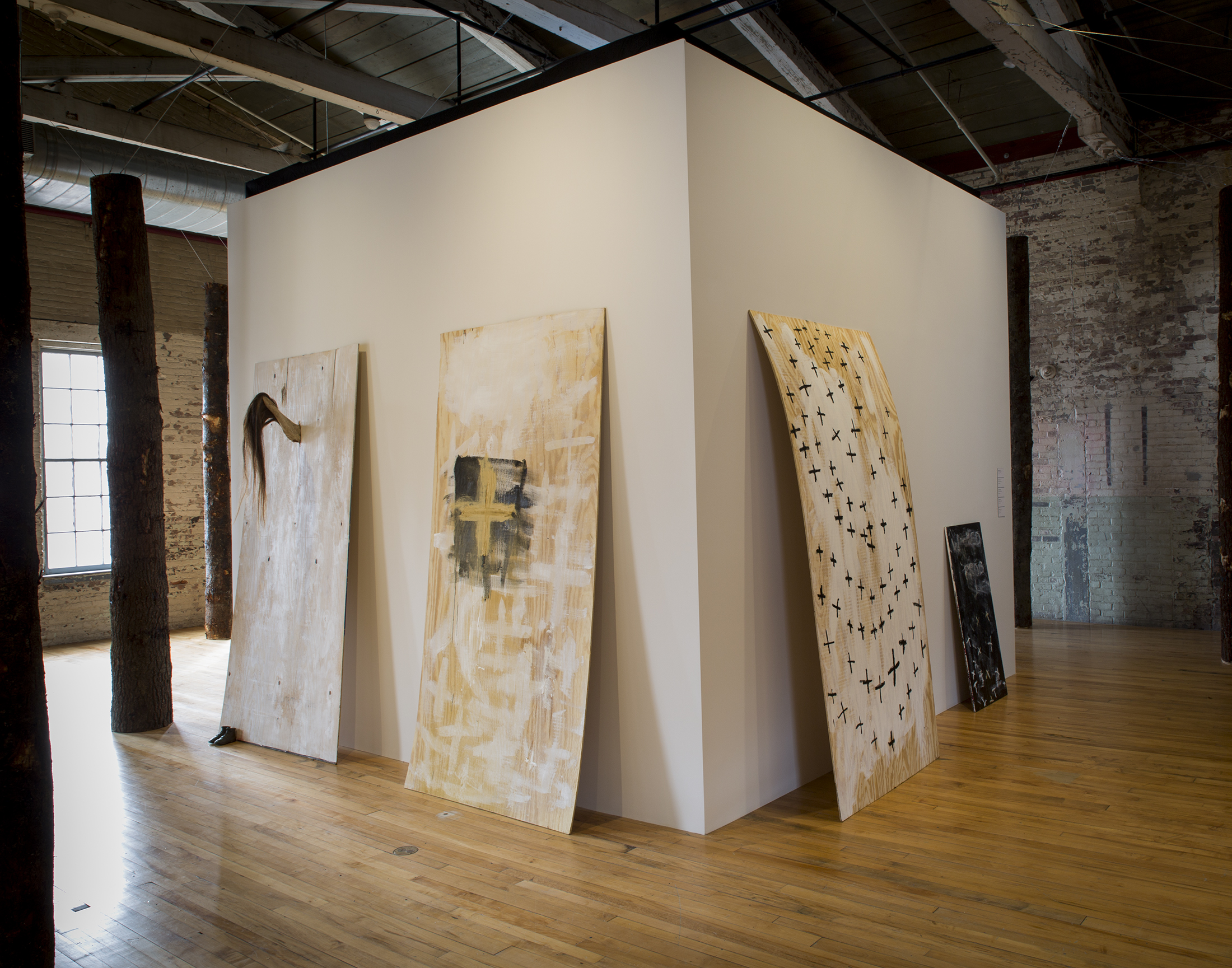
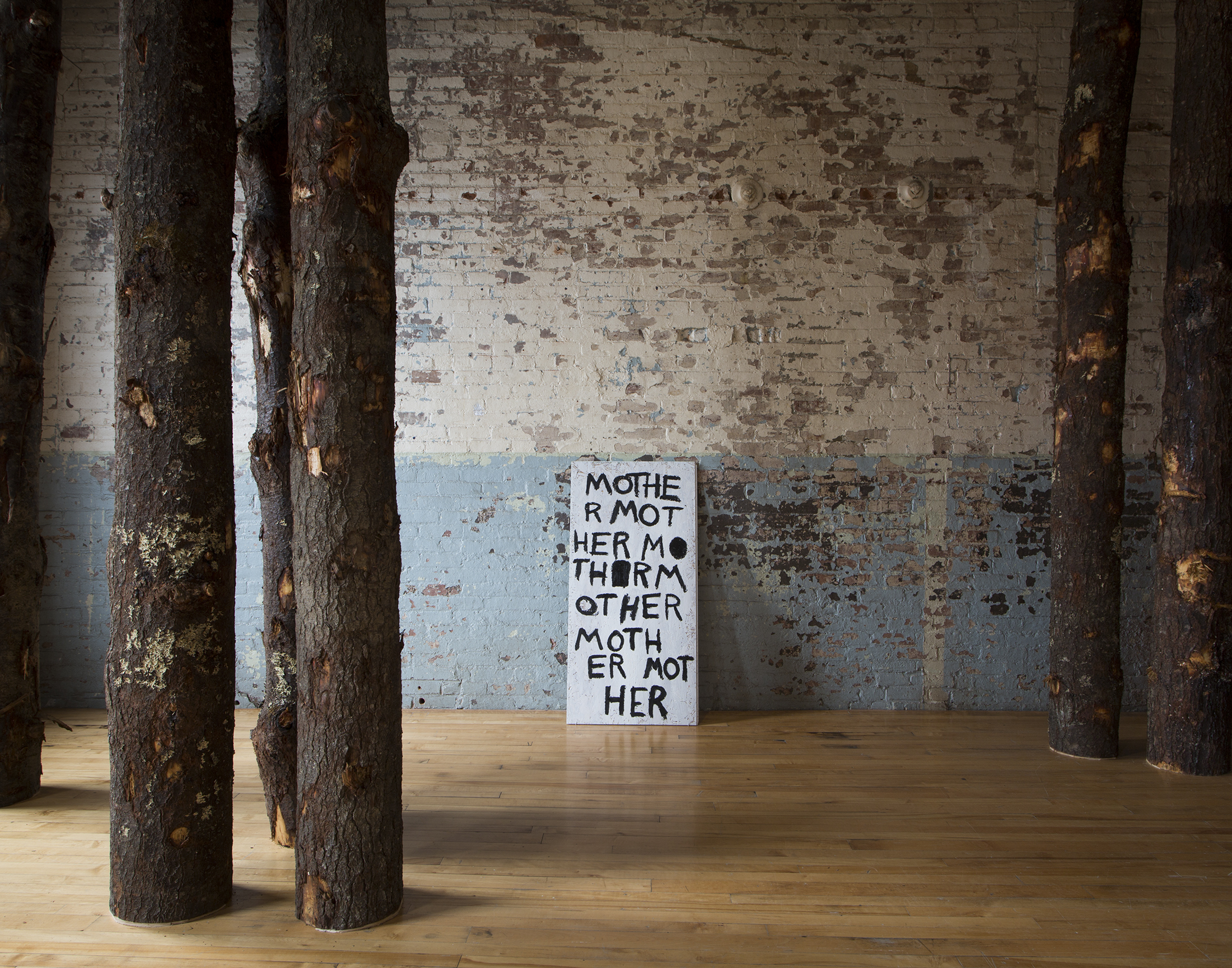
Quick - as there will be other occasions to unpack in detail this remarkable passage: In this passage Gates discusses the following implicit relations:
“Art” is Jasper Johns - Labor is the Father - Mourning is the Mother.
Consistently labor is the physicality of what is undertaken by the working-class father (tar, roofing), whilst Johns produces work, and Gates says that his father can roll with him, Gates, “through a successful body of work.” Again, moving quickly, Gates wants to say that Johns represents a conception of Art that insists on the work itself, by which one presumes he means a certain kind of autonomy of the work of art and the mental processes that it entails or entrains; Gates, on the other hand, at least in this moment of acknowledgment in “direct engagement with the people I love,” wants labor, contra Johns, to represent - or better, even, indicate, point to - a beyond of Art, an outside of Art, beyond the white cube (“there are things that are more important to me than White Cube gallery,” he will say): labor is one such, but so, too, is mourning. This outside of Art can lead to a revalorization of Blackness in Art as well as Blackness and Abstraction. The association of Blackness with labor marginalizes it in terms of modern art (and such is also the case for working class art per se in the economy of modern art6), but the implicit relation with mourning, Black mourning, might change the way of thinking about the materiality and language of abstraction - not Malevich, not Mondrian - to allow a conception of abstraction based upon neither a semiotic of disembodiment (say, primitively: Aurier; say, in its most powerful technology: Mallarmé, but in all cases post-symboliste) nor the historicity of art language (say, Binion and Whitten speaking always about not being of art history),7 but rather a conception of abstraction as veiling (of grief) or masking (of power) anchored in different material practices, whence labor.8 The Tar paintings declare in all their surface viscosity the class-based labor of the father: there is nothing to see beyond it (there is no transcendence à la Mondrian, à la Malevich, or Kandinsky): this black substance is the substance of labor itself. It is pure function. It fits where it must. The Tar works also and simultaneously block vision - there is nothing to see into - and so they veil, protect the grief of loss (the personal), thereby making for (public) mourning.
More than ever I regret that I was not able to be present at this exhibition at the White Cube gallery in London! It is only after listening to this remarkable passage and requesting permission to reproduce an image of Gates producing Tar work with his father - an image which I first encountered online - and was politely informed that “This is not a work that we allow to be reproduced” that I began to think more clearly as to why it might be that the photography of Gates and his father with Tar work production as reproduced in the exhibition catalogue, My labor is my protest, are all reproduced in varying degrees of low-res quality.9 (A new kind of low-res, different to what appeared in the 1980s in mail art, is now current in advanced practice: in Paul Chan’s Waiting for Godot in New Orleans: A Field Guide (2007), in Arthur Jafa’s akingdoncomethas (2018), and in each case there is a distinct significance of mourning. - And may be this practice of the low-res as marker of mourning and limited un-masking might be seen, too, at work in Okwui Enwezor’s Catalogue for Documenta 11, Platform 5: Exhibition the first 30 (unpaginated) pages of which, compiled by Nadja Rottner, consist of montages of (relatively) low-res documentary photographs of various catastrophes of our modernity - AIDS, (civil) war, state terrorism, guerrilla terrorism, forced migration, genocide, scenes of sweat labor in the manufacture of consumer commodities - as if the lowered quality of resolution (but which of the available senses of resolution?) suggests a diminution, a lessening in some way (the mystery or the alchemy of the commodity?) the result of circulation within the neo-liberal economy of commodification.10 - The refusal of high definition (and the attendant refusal of circulation) might well be grasped as an attempt to guard, to secure, to retain something from dissipation and even prurience. It would be to keep from full view, and here in Gates, to convey the sense of the image as somehow incomplete and so not fully commodified.
(Susan Cross and Larry Ossei-Mensah, Pitch, MASS MoCA, 2018. Text available online at MASS MoCA website.)
There is of course more, much more, that can be said about this important work of an emerging artist, not least on the role of the “MOTHE/R […] HER” and related questions of natality... We could return to Gates’ Tar works and see in them, too, a deep concern with natality and the way in which natality foregrounds the need to change stories or narrative commencements. Suffice to say that a new visual language is being configured out of and around questions of world, world-making, subjection, and physical labor precisely when the digitization of representation (and lived experience?) has become irreversible - and maybe it is surprising just how varied is this visual language as it articulates a new subject in art.



And snow, scarce as any Northern cotton, or, David Hammons doesn’t work hard like James Brown
For Max Dax - Berlin / Detroit
W.E.B. Du Bois, “The Black Worker,” Black Reconstruction in America, 1860 - 1880
Finally, but by no means exclusively, this insistence on Black labor is present, too, in David Hammons’ Bliz-aard Ball Sale, 1983, Cooper Square, New York, near the Cooper Union Art School, where David Hammons laid out rows of snowballs for sale in New York City, for what is Bliz-aard Ball Sale if not the negative of Negro Work? Here is Hammons as recorded in an oral history: “I’m not working that hard. When you find a found object, the work is halfway complete.” (David Hammons quoted in Elena Filipovic, “The Color of Money,” David Hammons: Bliz-aard Ball Sale (London: Afterall Books, 2017), 79.) And: “I’m not going to put that much energy into an art object to prove to these folks that I’m legitimate. […] But now that I’m not going to spend like, uh, the rest of my life overworking, like James Brown, the hardest working man, he up sweatin’ and screamin’ and crawlin’ on the floor to prove to these folks that you’re a good singer. I’m not gonna do this shit.” (David Hammons, ibid, 79-80.) The art historian Elena Filipovic comments, “After all, what could be more simple and less work[-like] than making snowballs in winter?” (Elena Filipovic, ibid, 80.) This witty nonchalance is the reductio ad absurdum that makes the point of the labor of the black avant-garde, for as Hammons knowingly comments, “Ain’t no black person gonna pay you for a snowball. [laughs] That’s not gonna happen.” (Hammons, ibid, 89.) And Hammons has in mind not only “no black person gonna pay for a snowball,” he has in mind, or rather, the work brings into its orbit - its metonymic web - Black artists who are focused on the kind of work that would find - or is it, fit? - its market conditions, surrounded as Hammons was - especially in New York - by a commercial culture of painting where “Other Black artists [in New York] couldn’t understand why you would do it [produce something] if you couldn’t sell it.”11 When Hammons, here in his interview with Kellie Jones, speaks of other Black artists, he has in mind other Black artists unlike Senga Nengudi who, in Los Angeles, was conceptual when he, Hammons, “was [still] working in frames,” but who, through sharing a studio with him, helped him become more conceptual just as she in response to his presence became more figurative, “That’s when she started doing the pantyhose [i.e., not your communal garden figuration, MSR]; those pieces were all anatomy,” and this following on from “when she used to put colored water in plastic bags and sit them on pedestals.” No one would speak to her and “She couldn’t relate.” Nengudi made the move to New York “and still no one would deal with her because she wasn’t doing ‘Black Art.’ She was living in Harlem. So she had to leave here and go back to L.A. and regroup.”12 There is more than a little anger (mixed with astonishment? at the blindness? at the self-defeating lack of self-awareness?) in Hammons’ tone as, crucially, he points to a different economy: “Then I came in after her; I said: ‘I’ll try it, I’ll try it with my shit,”13 which is not only the language of refusal (James Brown has his shit, afterall) but a marking of transition to the magical substance of shit that Hammons can deploy as he channels, plays with the bad areas. Here is Hammons again: “There were no bad guys here [in New York], so I said ‘Let me be a bad guy,’ or attempt to be a bad guy, or play with the bad areas and see what happens.”14 Nengudi and (her refusal of) the submission of “Black Art” to the market were material and psychic conditions for the emergence of Hammons’ limning of a possible economy of anti-commodification where he played with bad areas where “nothing in it was for sale,” coming up “with an abstract art that wasn’t salable”:
These things were brown paper bags with hair, barbeque bones, and grease
thrown on them. But nothing was for sale. [My emphasis] Other Black artists
here couldn’t understand why you would do it if you couldn’t sell it.
And:
I came here with my art in a tube. I had a whole exhibition in two tubes. I laid
that on the people here and they couldn’t handle it, nothing in it was for sale.15

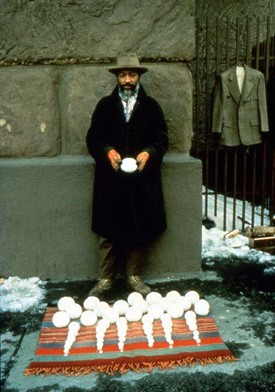
David Hammons, Bliz-aard Ball Sale, 1983, Performance documentation.
Courtesy: Tilton Gallery, New York.
Hammons speaks of the contact with Nengudi (“So by us sharing a studio”) as precipitating a new mode of practice which in being outside commodification resulted in forms or, better, following the late Pierre Fédida, informal substances from playing with bad areas, psychic bad areas and bad cultural areas: brown paper bags (bad enough) but with hair (Jews and Blacks have a thing or two about hair), and barbeque bones, and grease.16 At their moment of origination these informal substances are outside the art frame and this feature or aspect alone allows one to grasp them as part of a collapse of the work (oeuvre) in a movement toward the event (evénément), and indeed, in both Nengudi and Hammons performance - with a pronounced cultural-therapeutic dimension which draws upon identifications in series and which also falls outside the art critical model of discrete form - will assume increasing importance. (Here, it becomes unavoidable, for me at any rate, not to see that Hammons’ description of Nengudi’s practice evokes the parallel practice of Lygia Clark and Clark’s movement from discrete abstract objects to performative object-situations with therapeutic goals.17)
In light of the contact - and there can be no contact that does not leave a trace - and the encounter with Nengudi and the resultant playing with bad areas that makes available or possible the range of informal substances not for sale as outlined above, it remains that not only selves but objects, too, need testing, and the test (épreuve) here will be an object for sale that will survive the fact of exchange. Bliz-aard Ball Sale. A molded form prepared from (New York) snow, and so not an informal substance per se but one which nevertheless participates in the economy of anti-commodification essayed and prepared by the informal substances which emerged from play with bad areas.
Bliz-aard Ball Sale permits another angle on work / labor production and, through a series of metonymic associations, the cotton gin, for we need to be reminded that the cotton gin, as conceived for the Americas by Eli Whitney, was meant to lessen the burden of labor, but instead vastly increased and expanded the burden of labor on enslaved Americans and in such a way that it became efficient to employ - which is also to say, to enslave - vastly more Black Americans. The cotton gin had exactly the opposite effect from what its creator intended and thereby increased suffering in the world. Allow me to put this another way, Eli Whitney’s cotton gin is one of the most stunning illustrations avant la lettre of the Jevons Paradox, that paradox first formulated by the nineteenth-century British engineer and mathematician William Jevons that for any technology made more efficient the end result will be an increase in overall consumption of whatever material it is that one first sought to conserve. Increased efficiency necessarily leads to increased consumption. Hammons’ refusal of the idolatry of labor - of demonstrable and demonstrative expenditure of energy as figured through “James Brown” - might thus be construed as a refusal that recognizes that labor is the violent insertion of the subject into industrial time. (It is, after all, John Dewey, not Heidegger or Ernst Jünger, who speaks of that condition in which work becomes labor.) Bliz-aard Ball Sale, on this construal, is not, however, merely a token of non-work but rather a presentation through metonymy of an economy of work-anti-work-non-work in a landscape - of which the rug is a synecdoche18 - for the production or work-like construction of something like cotton - the metonym par excellence of violent labor which, pace Du Bois on “The Black Worker,” could build a new world - namely, snow balls. Here is Jean Toomer’s sonnet, “November Cotton Flower,” from Cane, with the onset of winter,
And cotton, scarce as any southern snow,
Was vanishing.
With the onset of winter, cotton vanishes from the South, and its attendant or associative violence hibernates, as it were. What if cotton - and its attendant violences - could reappear in the North as snow - a violent rainstorm (blizz, dialectal), or a violent blow (blizzard) - something in its way as equally light as (Northern) cotton? Here they are, lined up on a rug / landscape arranged like cotton balls rhyming with snowballs. A miracle? That such a transposition might occur? Or that anyone - but not a Black person - could pay for snowballs in winter in New York (or anywhere else for that matter where snow customarily falls)? Cotton does not grow in winter, and Toomer’s sonnet, “November Cotton Flower,” imagines the immaculate appearance of such a November Cotton Flower as correlative of a possible time in which something new comes into the world, something that not even Superstition had seen before:
Brown eyes that loved without a trace of fear,19
Beauty so sudden for that time of year.
If cotton meant a new world, why might snow not also intimate (the equally spectral outlines of) a new world? A world not based upon labor, nor money and so where “all the realm shall be in common,”20 a world, it might be said, where the common is based upon talking, the encounter through speech? Hammons:
When you have an object between you and them, people will talk to you. They’ll say,
‘What is that? Is it for sale?’ But if you’re just standing on a street corner, everyone’s
an enemy of each other. But one object… it becomes a conduit for conversation with
with someone you’ve never met before.21
Du Bois on the coming of freedom to the enslaved at the end of the Civil War:
For the first time in their life, they could travel; they could see; they could change the
dead level of their labor; they could talk to friends and sit at sundown and in moonlight,
listening and imparting wonder-tales.22
- “The first thing we do, let’s kill all the lawyers.” King Henry VI, part 2, IV. ii. 73. One day whilst listening to the radio I decided that I had heard this line followed by knowing giggles once too often and that it was time that I knew what it meant in Shakespeare. I pulled down my copy and started to read and was absolutely stunned to realize that the sentence is embedded in a workers’ discourse on justice, labor, and social rank, a not unimportant part of which was the desire on the part of those who labored to eliminate money - “there shall be no money,” and “All the realm shall be in common,” an expression of the realm being held in common would be conveyed through garment: “I will apparel them all in one livery,” as sumptuary laws would be abolished. To this end, “The first thing we do, let’s kill all the lawyers,” presumably as lawyers are part of the machinery of policing social order. The argument does not end here and there is more than a whiff of Pol Potism involved - Shakespeare will, after all, compose Coriolanus - but the issues bearing upon the relations between labor, rank, and justice are all present where “Virtue is not regarded in handicraftsmen,” even though “there’s no better sign of a brave mind than a hard hand.” Whence the injunction, “Labor in thy vocation.” (King Henry VI, Part 2, IV. ii. 15.)
- Power and labor. Long before Marx, or Capitalists, for that matter, one of our oldest creation narratives, the Enuma Elish, and related Mesopotamian stories, made clear the cosmological significance of labor in the organization of societies. From tablet 1 of the Story of the Flood the problem is posed as follows:
When gods were man,
They did forced labor, they bore drudgery.
Great indeed was the drudgery of the gods,
The forced labor was heavy, the misery too much,23
and don’t you know, the gods complained. Throughout these narratives there are variations on a theme for how the (lesser) gods escaped the drudgery of labor, but perhaps the most powerful version is to be found in tablet 6 of the Enuma Elish where, after an intergenerational battle between the first and younger gods, Marduk, leader of the victorious younger gods, takes a defeated god, Quingu, on whom symbolic punishment will be inflicted:
They bound and held him before Ea,
They imposed the punishment on him and shed his blood.
From his blood he made mankind,
He imposed the burden of the gods and exempted the gods.
After Ea the wise had made mankind,
They imposed the burden of the gods on them!
That deed is beyond comprehension,
By the artifices of Marduk did Nudimmud create!24
That deed is beyond comprehension - no matter the translation, the effort is to convey what a miraculous thing it is to be able to create a being, a creation requiring powers great and exemplary even for a god, a being to bear drudgery and labor and, miracle of miracles, for that being, created by a god, to accept its condition. Here is Marduk’s speech, Marduk’s promise to his fellow gods - the 1% of their day -
“I shall create humankind,
They shall bear the gods’ burden that those may rest.”25
In other translations it is made clearer: So that the gods may be at leisure. The politics of labor is here the foundation of the politics of jouissance after which the architecture of society and sociality is wholly organized.
We have seen, says Postone, that Marx’s presentation indicates that general historical
emancipation is grounded not in the possible full realization of the already extant form
of production but, rather, in the possibility of its overcoming. This critique is rooted not
in what is but in what has become possible - but cannot become realized within the
existing structure of social life.30
My name is Bordeaux and Nantes and Liverpool and New York and San Francisco
not a corner of this world but carries my thumb-print
and my heel-mark on the backs of skyscrapers and my dirt
in the glitter of jewels!
Who can boast of more than I?
Virginia. Tennessee. Georgia. Alabama.
Aimé Césaire, Return to My Native Land, 1939 / 1956, translation 1968.
Endnotes
[1] William Shakespeare, King Henry VI, Part 2, ed. Andrew S. Cairncross (London: Methuen, 1957, 1969).
[2] See the website for My labor is my protest at White Cube, including the conversation between Theaster Gates and Tim Marlowe from which all my quotations from Gates are taken: https://whitecube.com/exhibitions/exhibition/theaster_gates_bermondsey_2012. Accessed 04-18-22
[3] On the cultural and class significance of the work of the hands, cf. Janet Zandy, Hands: Physical Labor, Class, and Cultural Work (New Jersey: Rutgers University Press, 2004).
[4] Difficult not to hear father, also content, the father as content.
[5] Listening to Theaster speak, the poetic register is not merely in the (surprising?) diction - “when my dad is aging and things are decaying - spring is turning into the winter of his life” - but the very tender tone of voice.
[6] And this is so even in spite of the deeply felt valorization of folk art and song, of which the Negro Spirituals are very important examples along with the Blues, within the culture of Modernism.
[7] Jack Whitten: “LEARN TO HATE THE HISTORY OF ART AND ABOVE ALL DON’T TRUST IT.” Whitten, “Studio Log, 8 October ‘98,” Notes from the Woodshed (New York: Hauser and Wirth, 2018), 257.
[8] I have outlined a conception of abstraction in terms of veiling and masking in Michael Stone-Richards, “Underneathness - Surface - Work in McArthur Binion,” in McArthur Binion: DNA, ed. Diana Nawi (New York: DelMonico Books, 2021), 13-21, and in lectures during my time as Visiting Fellow in Critical Studies at Cranbrook Academy of Art, 2019-2020.
[9] See the low-res photographs of Tar works and the instruments of tar work (brush, truck, etc.) concluding with a portrait photograph of The Artist and his Father in My labor is my protest (London: White Cube, 2012), 25-35.
[10] See the Catalogue for Documenta 11_Platform 5: Exhibition (Kassel: Hatje Cantz, 2002).
[11] David Hammons, in Kelly Jones, “Interview with David Hammons,” EyeMinded: Living and Writing Contemporary Art (Durham: Duke University Press, 2011), 249.
[12] Hammons, “Interview,” 249-250.
[13] Hammons, “Interview,” 249.
[14] Hammons, “Interview,” 249. My emphases.
[15] Hammons, “Interview,” 249.
[16] See Tom Finkelpearl’s conceptualization of this same material in terms of dirty materials, “On the Ideology of Dirt,” in David Hammons: Rousing the Rubble (Boston: ICA, New York: P.S. 1 Museum, Cambridge, Mass.: MIT Press, 1991), 61-89.
[17] On Lygia Clark, see Pierre Fédida, “Substance informe,” Par où commence le corps humaine: Retour sur la régression (Paris: PUF, 2000), 105-119, and Fédida, “Ne pas être en repos avec les mots: Entretien avec Pierre Fédida,” in Lygia Clark: De l’oeuvre à l'événement. Nous sommes tous le moule. A vous de donner le souffle, ed. Suely Rolnik and Corinne Diserens (Nantes: Musée des Beaux-Arts de Nantes, 2005), 69-70.
[18] Robert Farris Thompson identifies the rug as a Moroccan rug and also observes, quite rightly, that the rug changed the situation. Cf. Robert Farris Thompson, “David Hammons: ‘Knowing their Past,’” Aesthetic of the Cool: Afro-Atlantic Art and Music (Pittsburgh and New York: Periscope Publishing, 2011), 100.
[19] My emphasis in order to mark what is immaculate in the sudden appearance of beauty.
[20] King Henry VI, part 2, IV. ii. 65.
[21] David Hammons, quoted in Filipovic, David Hammons: Bliz-aard Ball Sale, 73.
[22] W.E.B Du Bois, “The Coming of the Lord,” Black Reconstruction in America, 1860-1880 (New York: The Free Press, 1992), 122.
[23] Story of the Flood, 1700 B.C.E., trans. Benjamin R. Foster, in From Distant Days: Myths, Tales, and Poetry of Ancient Mesopotamia (Bethesda, Maryland: CDL Press, 1995), 52.
[24] Enuma Elish, 1900 - 1600 B.C.E., trans. Benjamin R. Foster, in From Distant Days: Myths, Tales, and Poetry of Ancient Mesopotamia (Bethesda, Maryland: CDL Press, 1995), 39.
[25] Enuma Elish, 38.
[26] Cf. Robert L. Herbert, “City vs. Country: The Rural Image in French Painting from Millet to Gauguin,” From Millet to Léger: Essays in Social Art History (New Haven and London: Yale University Press, 2002), 23-48. In one way or another Herbert’s book of essays is concerned with labor and the technology of labor.
[27] Cf. Thomas Zander, Walker Evans: Labor Anonymous (D.A.P. / Koenig, 2016).
[28] I first chanced upon this photograph of Martin Luther King at Bowdoin in the exhibition catalogue, Le Modèle noir: De Gericault à Matisse (Paris: Musée d’Orsay / Flammarion, 2019), 21. In the context of Bowdoin’s 1964 exhibition, the image may be found online with further rich documentation at https://www.google.com/search?q=martin+luther+king+bowdoin&client=firefox-b-1-d&sxsrf=ALiCzsabmdW7UGy1 0zYcQURLgOYO0QqBJw:1661527092450&source=lnms&tbm=isch&sa=X&ved=2ahUKEwimyITh5uT5AhU-lWoFHUsBAacQ_\AUoAXoECAEQAw&biw =1152&bih=534&dpr=1.67#imgrc=JBlQMYUGEeLhzM.
[29] In another context, I shall touch on the life and work of Tillie Olsen as a way of exploring the way in which even, or may be especially, writers insistent on the social and political engagement of their practice still come up against aporias which lead them to recover the insights of the modernist fiction that sees the aesthetic as a refusal of labor and its political ordering - its ontology of commodification. See Michael Stone-Richards, “Aporias of Attention,” Care of the City (forthcoming, Sternberg Press).
[30] Moishe Postone, Time, Labor, and Social Domination: A Reinterpretation of Marx’s Critical Theory (Cambridge: C.U.P., 2003), 360-361.
[31] Postone, Time, Labor, and Social Domination, 361.
It is our sorrow. Shall it melt? Ah, water
Would gush, flush, green these mountains and these valleys,
And we rebuild our cities, not dream of islands.
Auden, “Hearing of harvests rotting in the valleys”
I.
Care
Maggie Nelson. On Freedom: Four Songs of Care and Constraint. Minneapolis: Graywolf Press, 2021. 288 pp.
Emma Dowling. The Care Crisis. London: Verso, 2021. 250 pp.
The Care Collective. The Care Manifesto: The Politics of Interdependence. London: Verso, 2020. 114 pp.
The Politics of Care: From COVID-19 to Black Lives Matter. Ed. Deborah Chasman and Joshua Cohen. Boston: Boston Review, and London: Verso Books, 2020. 216 pp.
The Pirate Care Project. https://pirate.care/pages/concept/
Pirate Care is convened by Valeria Graziano, Marcell Mars, and Tomislav Medak.
Pirate Care is a transnational research project and a network of activists, scholars and practitioners who stand against the criminalization of solidarity & for a common care infrastructure.
Care is everywhere, and everywhere marked by its absence. Hardly a week goes by without a friend sending me yet another reference to a new book or pamphlet on care. Since there is not only an ethic and politics of care but also, increasingly, an aesthetic of care, Maggie Nelson thinks it is worth challenging what is at stake in the new pervasive obsession with care, since who would think care a bad thing – but Maggie Nelson does not do warm and fuzzy, and in her own way she arrives at, but without channeling, Martin Heidegger (The Essence of Truth) and Orlando Patterson (Freedom, vol. 11) on the conflict inherent to any adequate conception of freedom and further, hence her title, On Freedom: Four Songs of Care and Constraint, that most of what is in play when people talk care is what Heideggerians would call ontic, rather than ontological. It would not be a distortion to say procedural, not of the nature of the being of Care in question, and thus peculiarly open to certain unacknowledged aporias of power, which is where a compelling collective such as the Pirate Care Project comes in for the almost brutal way in which it addresses the power dynamics in the business of caring, for there is no author or collective so direct, so stripped down in its demystification of care as a locus of state power and power differentials between individuals, no group which so seeks to strip the language of care of the sentimentality that seems to attach itself to care-talk as the Pirate Care Project at precisely the cultural and political moment when Care has broken through the obtuseness and distortions of reigning economic illusions worldwide and in the light of which Pirate Care proposes, well, a pirate form of Care as practice of solidarity: “Thus pirate care, seen in the light of these processes - choosing illegality or existing in the grey areas of the law in order to organize solidarity - takes on a double meaning: Care as Piracy and Piracy as Care.”2 Who – what – is or is not worthy of Care has, it seems, become the new demarcation between the human and the non-human even as it begins to enter social awareness that the human demonstrably is dependent on the non-human. Pirate Care may be guerrilla warfare from the non-violent souls of our dürftiger Zeit, our abject times.
In March 2020, as American society began to accept that there was indeed something out there from which it was worth sheltering, I was, wouldn’t you know, teaching a class on Care of the City through an introduction to the feminist ethic of care tradition. It was straightforward to get students to grasp the significance of the gender and neglect of care practices, grosso modo, both receiving care and care-giving – of the body, the child, the house, environments, working with the routines which are the bases of larger habituations which establish spaces as livable or as sanctuaries, such care being the basis of images of relationships, and also (ultimately?) the City to which in certain moments of crisis we relate as a body in need of care, that is, presence, time, for which the work of the hands becomes a metonym. We even came to understand that we can care for strangers in a way which, say, and with all due respect to Senator Cory Booker’s Democratic Presidential Primary run, one cannot love whom or what we do not know. It was relatively easy, even, to grasp that gendered caring practices were, following Selma James and Sylvia Federici, a form of invisible work which erased itself as soon as it was accomplished3 thereby providing an image of why it was difficult to get society to accept that housework should be paid work (very few students would accept this proposal), that the unpaid care that went into the work of habits (housework) was the basis without which economies would collapse. What was more challenging, however, was moving away from voluntarist thinking – I choose to care; I do not choose to care because … - to a mode of thought where to care was not a choice, the position of Heidegger’s ontological conception of care, which is the basis for a mode of thinking of Care as response to the threat or fact of broken sociality, indeed, of broken sociality as an instance of retrait - retreat, withdrawal, voiding, collapsing, even dis-investment (in both the colloquial and analytic sense of this last term). Then came COVID-19 and the anxiety of what Heidegger characterizes as the collapse of familiarity, that is, the everyday, and the anxiety, that is, Care, induced by the confrontation with the loss of what is normally taken for granted. It is here that it is essential to be reminded of the Germanic etymology of the English care. The standard etymology of the English word care (from a current writer such as Anatoly Liberman all the way back to Skeats) points to “Anxiety, sorrow,” heedfulness, attention, even to lament, or to sorrow (“wholly unconnected with Latin cūra, with which it is often confounded,” say most dictionaries of etymology). So, the English care has built into its latencies and historical sedimentation the idea of grieving, or sorrowing for that for which one cares: the frail body of the loved one, the body about to depart for distant travels which induces melancholy and vague anxieties centered on the possibility of the non-return of the loved one, which may also be an image for, or a way of proleptically living the absence of. the body about to depart this world, the body incapacitated and thus utterly dependent upon the caring relation, that is, the relation of attentiveness, heedfulness, underwrit by a certain anxiety or anguish. Grief, however, collapses the grieving self and not necessarily because of what is already proximate to the one who grieves – and this is Heidegger’s insight into the non-voluntaristic dimension of Care, the ontology of Care, without which, the demand for care – also the demand for attention – is indistinguishable, and tellingly so, from a demand for love. …And so COVID becomes the home for the greatest drama of attending that we have all witnessed in our recent cultural memory, the murder of George Floyd, a graphic drama in the literal sense –- and here, I happened to be reflecting on a set of photographs on The Confederate Monument in the American South which my colleague Carlos Diaz had been developing for a book over a number of years, the opening of which, my response to seeing these photographs during COVID-19 and the murder of George Floyd, I reproduce here as it allowed me to think the relation between image and suffering, care and the collapse of familiarity, as well as image and mimetic desire in a framework where repression is the form under which things can be hidden – and disavowed – in plain sight.
II.
1. “The time is out of joint.” Hamlet, 1. v. 188.
When, just over a year ago, Carlos Diaz, the author of this collection of photographs, The Confederate Monument in the American South, came by my office in the College for Creative Studies in Detroit where we both teach and asked if I might be interested in writing an essay to accompany the work, I jumped at the opportunity not only to work with a photographer whose work I had come to admire but because I was very recently back from my first visit to Richmond, Virginia, which is also to say, I had been taken, as is every first-time visitor to Richmond, to Monument Avenue to see the collection of Confederate Monuments – and more thought needs to be devoted to this word collection and the phenomena which it evokes and shelters. I had never seen anything of the kind anywhere in my life! Parisians must be tired of the visitor’s response to La Tour Eiffel, just as many in New York are utterly unfazed by the Empire State Building – even after Jay Z and Alicia Keys’ “Empire State of Mind” – or many in Detroit are politely bored by the many visitors who are awed by the ruins of the Michigan Central Train Station, but during my stay in Richmond I do not recall anything blasé in anyone’s conversation about the statuary on Monument Avenue and this was not surprising for the city that had once been the capital of the Confederacy is now a bastion of liberal and progressive wealth and privilege, and just as no one could ignore the monuments no talk could not be also simultaneously about the question of the monuments: the entangled politics of their afterlife, the complex ethics of aggression and impotence entailed in their cast shadows, and their continued injury to thought. If, after the collapse of Communism and the Warsaw Pact as symbolized by the Berlin Wall, the world had become accustomed to the idea that with the collapse of a governing order goes also the monuments to its own magnificence – something repeated and televised the world over with the collapse of the regime of Saddam Hussein – then it must seem all the more jarring and discomfiting to encounter the phenomenon of the Confederate Monument in the American South: Everywhere else in the modern and contemporary world the monuments of losing regimes in Budapest, Hungry (1956), in Accra, Ghana (1966), in Tehran, Iran (1979), in Addis Ababa, Ethiopia (1991) – and no regime loses because it is good or virtuous – are by popular assent pulled down, dragged off, and melted or broken down or, as with the recent pulling down of the statue of the British slave trader Edward Colston in the English port city of Bristol, thrown into rivers or oceans - or occasionally put into museums as apotropaic objects: Look on this and shudder!4 It is not easy, after all, to imagine a German person saying, Yes, let’s keep 750 monuments and commemorative objects to Hitlerism because that is after all part of our history and heritage and you can’t erase history!
2. “Be you my time,” Troilus and Cressida, I. iii. 313.
And there it might have stayed, the cultural version of treading water – until, that is, everything changed, and with a speed, a temporality, a (biblical) suddenness that no one could have imagined as decaying but still resistant values suddenly could no longer temper or deflect the counter-movements of long suppressed histories and repressed psychic injuries. First, it must be said, that the phenomenon of COVID-19 induced something that the world has not experienced at least since 1918, that is, since the time of the Spanish Flu, something that even the direst events of economic collapse cannot ensure, namely, shared experiences of exposure and vulnerability. Every natural or quasi-natural disaster that one can think of from the meltdown of the nuclear reactor in Fukushima, Japan to New Orleans and Katrina or the astonishing gun violence on the south and west sides of Chicago is a disaster from which the rest of society can be sheltered, or, the disaster being elsewhere leaves all else intact and life as usual may continue as usual, but with the phenomenon of COVID-19 a new temporality joins the world and joins together all the intervening moments of separation and differentiation as the disaster envelops every neighborhood – state – country – continent such that, suddenly, with the collapse of familiarity, that is, the collapse of the everyday and life as usual, the shared sense of exposure and vulnerability compels the recognition and adoption of practices of care that many had thought previously were acts of benevolence toward the less well-off either at home or abroad. Care, says Martin Heidegger, is the response to the radical anxiety confronted with collapse of familiarity, the moment in which the human creature realizes that it is a creature (or phenomenon) of care which it has failed to realize because of the distortions inherent to everyday life obstructing its potentiality for being-in-the-world. Care, in this sense, is not a choice (I do not choose to care or not) and becomes overwhelming as when in the phenomenon of radical exposure we begin to realize our consonance with what is not-us, not only fellow human creatures but other bodies, selves, and environments which make for our life-worlds and particular forms of life now grasped as vulnerable and hence in need of care – an ethic and politics of care. Retreating from this collapse entailed a new kind of temporality, a new awareness of care where suddenly the need to care – that is, something no longer a choice or moment of generosity – reveals our entanglements as this term is understood in contemporary anthropology, that is, beyond our mutual inter-relations or symbioses, entanglement is a structure of mutual dependencies. Suddenly the entanglements extending from my home and neighborhood that make my existence depend on the communications system, on the global systems for food distribution and much more are made manifest through their absence as my autonomy, or sense or claim of autonomy, is shown to be no more than my projection of power made all the more risible in my need for others and relations and practices of the everyday. If no one can work at the supermarkets I cannot buy food. If schools and nurseries for my children are closed, I cannot go to work. If no one will work in the hospitals, then…and so on. We have come to apply the military term frontline to such workers, and of course who is a frontline worker is often a function of class and privilege and racial histories. Within this radical exposure, this vulnerability, and compromised sense of autonomy, within, in other words, this phenomenon of dependency so alien to most citizens of the United States, comes the most extraordinary image of human pain, suffering, and degradation articulated simultaneously as an image of human depravity and monstrosity: the killing, the very slow yet inevitable killing (like a disease finding its prey), as captured on multiple phone videos, of George Floyd at the hands of the white police officer Derek Chauvin in Minneapolis on May 25, 2020, as Chauvin knelt on Floyd’s neck for 8 minutes 46 seconds, ignoring Floyd’s pleas of “I can’t breathe!”

3. “For thy records, and what we see, doth lie.” Shakespeare’s Sonnets, 123.
The killing of George Floyd changes the temporality of social and political life in the USA; indeed, the temporality of the social and political processes is made possible by, and follows the temporality of, COVID-19. Above I spoke of the image of human pain and the image of human depravity, and I do not intend this sense of image, the weight to be borne by the term, in any casual sense, for I mean precisely to say that the suffering is articulated as part of an economy of visuality and it is precisely because there is a vast and complex network and system of circulation for the recording, disseminating, and sharing of images – an economy of visuality – that it will become possible for the attention of Americans and the world (a contemporary world composed of afferent networks leading from and back to the United States of America in banking, economy, the military, politics, and culture) to be simultaneously and spontaneously shared as condition of mimetic behavior. The commanding and magnification of attention by the material infrastructure of image-circulation, the photo-graphic condition of contemporary communication(s), in other words, après-coup provides a genealogical structure (what Michel Foucault understood by the law of the archive, which is not simply a collection of things but a principle of inevitability of power) for visualizing affect and replication of the same (think Eric Garner’s I can’t breathe, say, as announcing the work and structure of inevitable power when repeated by George Floyd’s I can’t breathe at which point it becomes an archive of inevitability; or the artist Dread Scott’s flag A Man Was Lynched by Police Yesterday, 2015 announcing a similar archive of inevitability in light of the NAACP’s banner A Man Was Lynched Yesterday [NAACP headquarters in midtown, Manhattan, 1920 - 1938]. Grasping the instance, the practice of the replication of the same is also a grasping of the moment of the instantiation of the law of the archive, as if, in our example, the photography of lynching as conveyed in the NAACP banner A Man Was Lynched Yesterday – for here we do not need to see the photographs and postcards of lynched bodies5 - is at one with, and part of the same economy as, the institution of the American Confederate Monument by the United Daughters of the Confederacy (see the Confederate Dead in Shiloh, Mississippi, 1957). The time of George Floyd’s killing is the psychic and cultural time which allowed the photo-graphic conditions of black pain to be receivable, and why the contestation called Black Lives Matter, following the killing of George Floyd, had to be in the media of visuality at the same time that the photo-graphic capture of suffering had to be opposed by many as another form of pain - here one may think of Claude Lanzmann’s unconditional refusal to use a single photo-graphic document from the Nazi concentration camps in any of his film work but most famously Shoah (1985), and one may think also of the way in which the photo-graphic depiction of Black suffering and death has become a target of activist refusal even as such visuality has become both evidence (of a past event) and affect (repetition in the present). As the anthropologists Arthur Kleinman and Joan Kleinman comment:
Suffering is one of the existential grounds of human experience; it is a defining quality, a
limiting experience in human conditions. It is also a master subject of our mediatized times.
[…] Images of suffering are appropriated to appeal emotionally and morally both to global
audiences and to local populations. Indeed, those images have become an important part
of the media.6

Women leave a wreath in a monument honoring the Confederate dead in Shiloh, Mississippi, 1957
The monument was built by the United Daughters of the Confederacy.

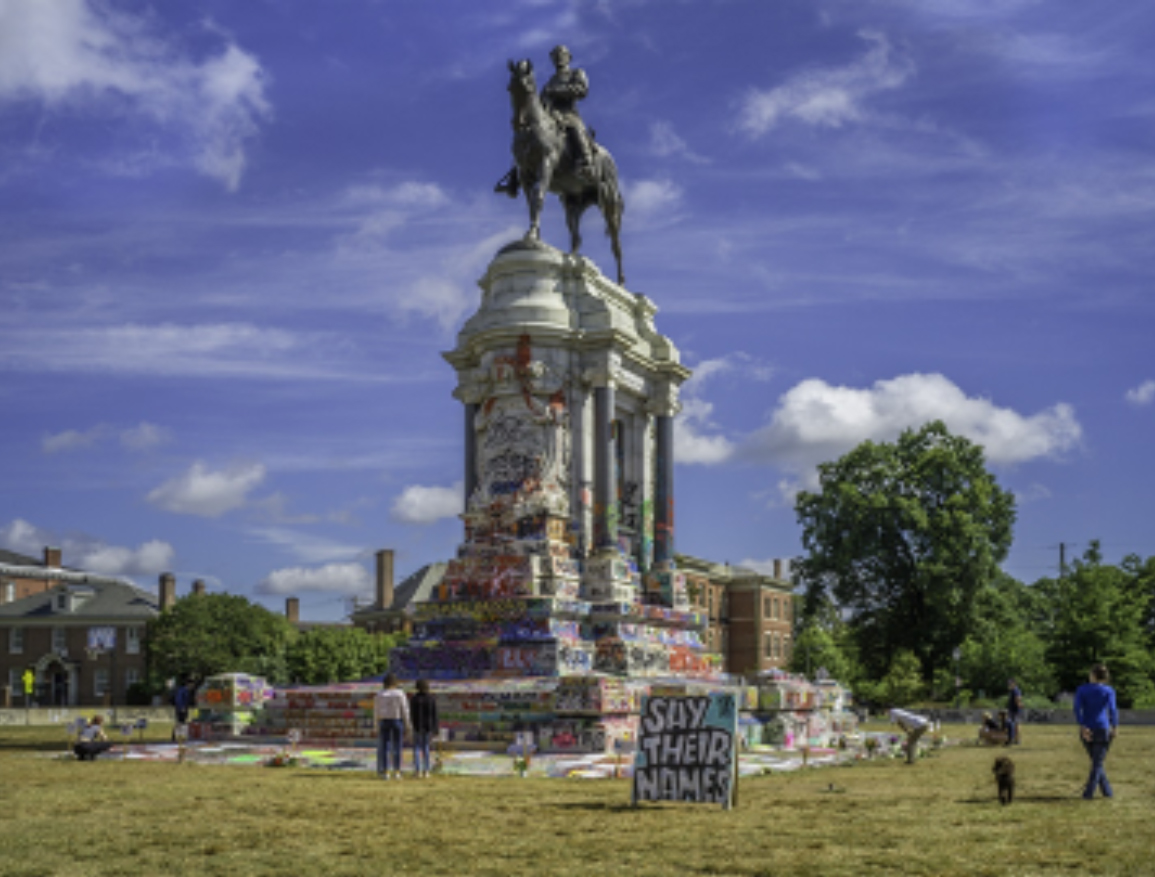
A recognition of this equation has long informed the (philosophical) anthropological reflection of Southern American murderousness toward its Black population. Jack Kerouac, for example, in his prose-poetic introduction to Robert Frank’s epoch-defining photographic collection Les Américains (Paris, 1958 and as The Americans, New York 1959), the most telling aspect of which is the racism that is part-and-parcel of the American atmosphere, would write very simply: “Man, black, mad mourners […] and death is like life, what else?” The French film-maker and critical theorist, Guy Debord, writing in 1966 in an extraordinary reflection upon the Los Angeles Watts riot of 1965, could articulate the insight of America’s problem by first observing that “It is no longer the crisis of the status of Blacks in America; it is the crisis of the status of America, posed at first through Black people.” (“Le Declin at chute de l’économie spectaculaire-marchande,” Internationale situationniste, no. 10 (Mars 1966): 4.) Wherever a group or population becomes a “problem” of the genre What is to be done with the Jews? What is to be done with the Negros? What is to be done with the Native Americans / Kulaks / Uighers? the problem is not this particular group of people but a psychotic kernel within a dominant mode or form of life that seeks a sacrificial victim in the targeted group, hence Debord will write that “[Blacks] are disfavored from the start,” and in this sacrificial role allotted to them – the great Harvard sociologist Orlando Patterson says nothing more than this in his important if somewhat neglected book Rituals of Blood, 1999 – as a population “Blacks as a whole must represent the poverty of a society of hierarchized wealth.” (Debord, “Le Declin et chute de l’économie spectaculaire-marchande,” 7). The great American essayist Elizabeth Hardwick articulated a structurally comparable insight – what it is that the Negro represents as a means of giving form to the psychotic kernel in American culture – when, also writing of the Watts riots of 1965, she observed: “We know that only the severest concentration will keep the claims of the Negro alive in America, because he represents all the imponderables of life itself.”7 One could write an essay, a long commentary just on this sentence, but suffice it that Hardwick’s formulation allows the reader to grasp that there is a question, an ethics of attention – the severest concentration – that allows one to begin to grasp and to formulate a response to the question being posed everywhere after the outpouring of affect following George Floyd’s killing, after the sudden and radical change in American sympathy for the commitments and language of Black Lives Matter, as well as the contingency of sympathy, namely the question, Why now? Why now when so much has already been visually and in real time documented? Why now since we need to know so that we might know how to sustain the change or, at the very least, prepare for another (unanticipated) change? It would not be an exaggeration to say that for many in the activist community there is almost a trauma, an unacceptable uncertainty around the question, Why now? Hardwick’s formulation says that it is indeed a question of attention and attention of a kind that is not normal – and maybe no longer normative – namely, attention that is severe and concentrated, in other words, durational and embodied, not fleeting, above all not an avoidance. Hardwick was very familiar with the thought of Simone Weil for whom attention was the opening not only to suffering but to divinity. (There is an intimate relation between attention and hospitality as Weil realized. In the ancient tradition, as found in The Odyssey and the Gospel according to Matthew, hospitality is conceived as something divine. There are many ways of conceiving the question of the human but a central way passes through the issue of who is deserving of attention, care, and hospitality, and thereby, in this tradition, who participates in the divine.) For Weil the full exercise of what it is to be human is available only in the act of attention where, on Weil’s argument, the object of attention is independent of the attending subject for “Attention consists in suspending thought, leaving it available, empty and ready to be entered by its object […] thought must be empty, waiting, seeking nothing, but ready to receive in its naked truth the object that is about to penetrate it.”8 The importance here of the autonomy of the object of attention is that “When one is attentive to the object, one is no longer paying attention to oneself,” writes Weil in a set of notes to herself, and this paves the way for one of her characteristic formulations in which she writes (in a manner that anticipates the work of Jacques Derrida on the impossibility of forgiveness) that attention “is contemplating the non-contemplatable.”9 Here is the context:
Contemplating the pain [or affliction] of others without allowing the act of looking to be distracted: not only the act of looking with eyes, but also without unsettling the act [or look] of attention through revulsion, or sadism, or through any kind of psychological consolation. That is beautiful. For that it is contemplating the non-contemplatable.10
What is the graphic transmission of George Floyd’s killing if not contemplating the non-contemplatable? If this passage has echoes of Susan Sontag’s critique of photography in Regarding the Pain of Others (2003) this is not an accident for Sontag, like her friend Elizabeth Hardwick, draws upon Simone Weil, in arguing against the photo-graphic capture of experience that it is only if we can attend with sufficient concentration - destroy the idolatry of the image after using it as a starting point11 - that we might be able (a) to avoid voyeurism and (b) to assume onto ourselves the pain and affliction of others, something less and less possible in a condition where one population has had enforced on it the social status of, or come to “represent all the imponderables of life itself.” It is, says, Hardwick, the unknown imponderables (in my diction, the unconscious psychotic kernel) which distract attention thereby necessitating the heroic, the severest concentration.
III.
Gilbert Ryle, brisk as only the English can be, but also an early commentator on Heidegger’s Being and Time, perhaps the first in English-language philosophy of a major order: “To take care entails being prepared for certain sorts of emergencies.”12
Wilson Harris, in the opening sentence of The Infinite Rehearsal: “Let me begin this fictional autobiography with a confession. The values of a civilization – the hope for a universally just society, for the attainment of the mind and heart of love, the genius of care – are an impossible dream…”13
We now have many names for emergencies but Care has emerged as the indispensable name.
IV.
La Librairie de Guy Debord: Stratégie. Ed. Laurence Le Bras. Paris: Éditions l’Échappée, 2018. 525 pp.
La Librairie de Guy Debord: Poésie. Ed. Laurence Le Bras. Paris: Éditions l’Échappée, 2019. 586 pp.
La Librairie de Guy Debord: Marx et Hegel. Ed. Laurence Le Bras. Paris: Éditions l’Échappée, 2021. 521 pp.
La Librairie de Guy Debord: Histoire. Ed. Laurence Le Bras. Paris : Éditions de l’Échappée, 2022. 528 pp. [As DR3 goes to press.]
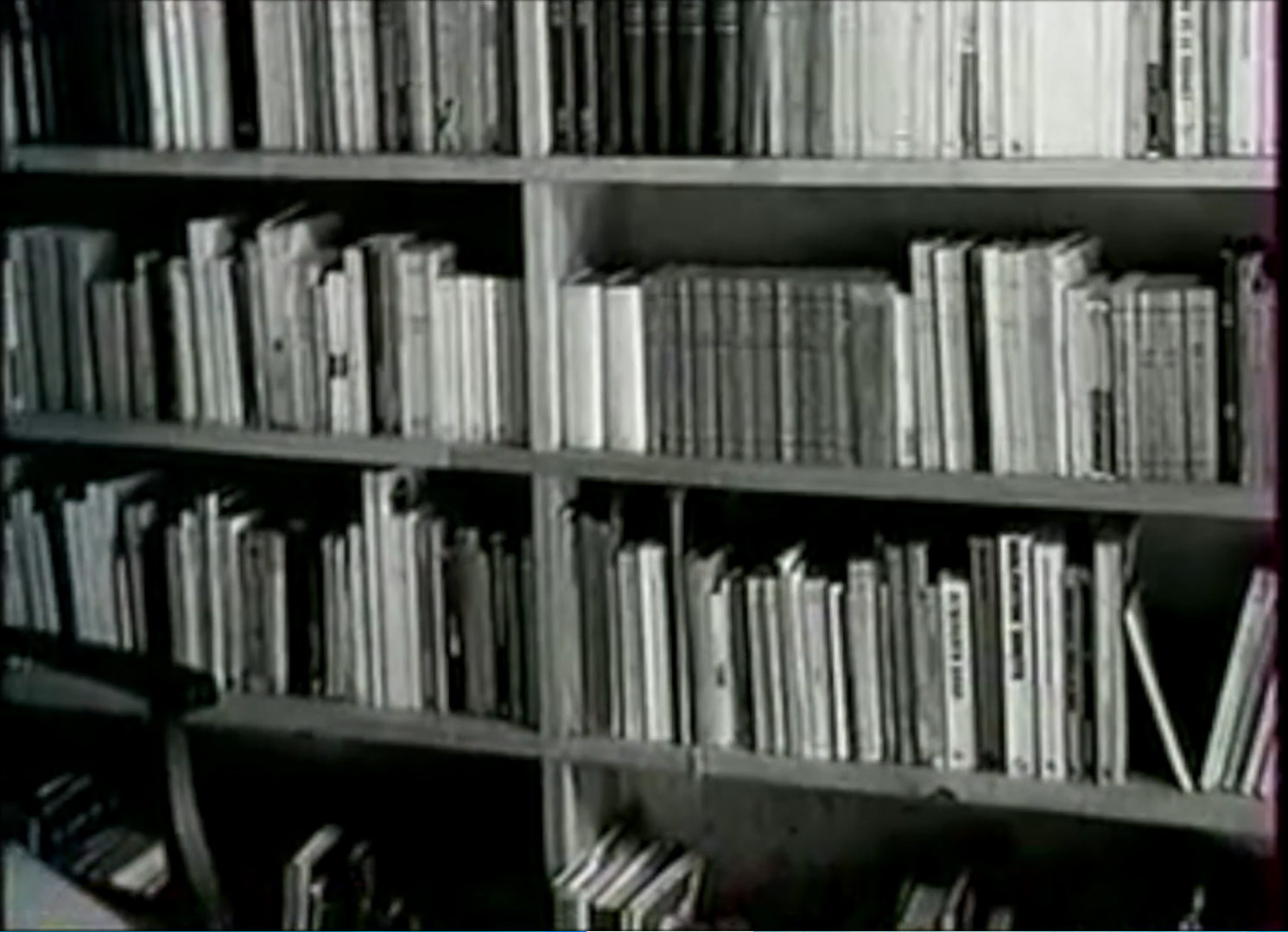
In 2001, as I was leaving Northwestern University, I wrote and published an essay on “Néo-Stoicisme et éthique de la gloire: Le Baroquisme chez Guy Debord.” Looking over one’s old publications can be a depressing business – especially if one’s writing got caught up in provincial arguments, which mercifully was not the case here14 – but I have continued to hold to this essay with only one regret: that a section on “Temps et musique” and a film still (or rather a screen shot) of Guy Debord’s library in the French country side of Champot in the Haute-Loire had to be cut. (Sollers was absolutely right in his film on Debord, Une étrange guerre, to emphasize the essential importance of Baroque music in Debord’s sensibility. There remains a serious reflection to be undertaken on the importance of Baroque music in Debord’s thinking – Not only is the use of Art Blakey’s Whisper not in In girum nocte et consumimur igni (1978) the unique instance of Jazz in Debord’s filmography,15 it is also the unique instance of non-Baroque music, if we accept Michel Corrette, whose Les Délices de la solitude, op. 20, Sonata VI in D Major, we hear in La Société du spectacle, as a composer from the late stage of the Baroque in music, and of the Baroque composers used by Debord, Handel – for his Thèmes cérémonieux des aventures16 – is the only non-French composer: De Lalande, Couperin, Boismortier, and Corrette are the composers whose music we hear in the films of Debord.) Debord’s reading, his culture, is evident at every turn, as is the directedness of that culture, and seeing the photography of Debord’s study in Champot served to cohere in my mind the desire on Debord’s part for a particularity of culture – not the cultivatedness of the average bourgeois.
It’s not long after this moment that a certain chauvinist strain in the American historiography on Debord started to appear emphasizing what it openly characterized as the Americanness of its approach and against what it considered the French approach to Debord, an approach that addressed the melancholy, the revolutionary pessimism, the classicism of his style, the systematicity of this thought (also known as philosophical anthropology), and worst of all, which began to separate Debord “from his colleagues” – what a quaint bit of piousness – in the Internationale situationniste. As the camera pans slowly in its approach to Debord’s country residence where the precious library is held, we hear Sollers in a voice-over reflecting on the role of retrait (withdrawal) and solitude so important to Debord, as he asks: “Seule? Non. La pensée essentielle de la liberté n’est jamais seule? [Alone? No. The essential thought of liberty is never alone!]” - Alas, certain things are simply not egalitarian: beauty, intelligence, good conversation, and style. I still treasure the screen shot of Debord’s library, it may even have been the first screen shot I ever took – I recall watching the film for the first time in 1999 – if I am not mistaken - with a colleague in New York as we worked on a translation of a Debord text, for it was so obvious that Debord’s culture was larger, more generous, and analytically encompassing than the use to which the academic literature of the late 90’s and 2000’s was putting a limited body of his work. The French Debord – well, his library was declared a national treasure and acquired by the State, much to the irritation of certain American admirers – was never, of course, narrow and aetiolated, and since the State – l’État – acquired his library, enormous work, of the kind well-established in French academic culture (see work on the collection of André Breton, but also on the library of Paul Celan) has been accomplished in making public the range and materials and significance of Debord’s culture of which the three volumes of Debord’s (carefully organized) reading notes under consideration are but the latest tranches. Here in these three volumes is all that most of us will ever need to be able to reconstruct Debord’s reading in poetry, Marx and Hegel, and strategy and therefrom draw our own conclusions. Lacenaire is there with Bossuet, La Bible de Sarcy along with poetry from the Tang Dynasty, Boulenger’s Les Romans de la Table Ronde with Gracián, but also Gertrude Stein with Marcel Mouladjil. Indeed, with Goethe, and the strong presence of Pessoa and Machado, one suddenly realizes that we are confronted with a reading in World Literature - the terms of which are wholly based on economies of circulation in translation and power - of a high and distinctive sensibility. In a saying attributed to the iconologist Erwin Panofsky, it is often said that who has the best photographs wins (in art historical research since one cannot physically visit every object of one’s interest), and here we might say, in view of how it is typical of the European avant-garde – Breton, Tzara, for example – that who has the best archives shapes history. The kind of (institutional and historiographic) work represented in these volumes is only possible because of the meticulous archives maintained by these artist-thinkers themselves. I recall reading of Asger Jorn’s arrival in post-World War II Paris and his thinking that Surrealists and former Dadaists and assorted avant-gardists would be into his wish to meet and talk for as long as he wanted to talk – all in the name of spontaneity. He was shocked to find that right across the social and political spectrum French writers and artists kept very strict hours for lunch and dinner since outside these times they were busy making their archives for posterity, something Duchamp helped Enrico Donati to realize when Donati asked him why Breton’s handwriting was always so perfect: PM, Duchamp replied: post-mortum.17 Posterity – the transmission of values. As Breton wrote in his “Prolegomena to a Third Manifesto of Surrealism, or Not” (1942): “my greatest ambition would be to allow the theoretical sense to be indefinitely transmissible after me.” This concern with transmission may yet prove to be the lesson of lessons of the historical avant-garde.

V.
Tombeau pour Okwui Enwezor
Okwui Enwezor, et al. Trade Routes: History and Geography. Johannesburg: Greater Johannesburg Metropolitan Council, 1997. 412 pp.
Okwui Enwezor, et al. Grief and Grievance: Art and Mourning in America. New York: Phaidon and New Museum, 2020. 264 pp.
I would run into Okwui Enwezor (1963 – 2019) in New York. On one such occasion he walked me around his exhibition The Short Century: Independence and Liberation Movements in Africa 1945-1994 (2001, Munich, Museum Villa Stuck). I had missed its Chicago installation and felt that I had lucked out to be walking through the New York iteration of the show with him at MoMA PS1 (2002). He was already a rising star in the curatorial firmament, but after this show, The Short Century, his reputation was firmly and irreversibly established. The catalogue of his which meant most to me was his first great show, Trade Routes, the Johannesburg Biennial, for this exhibition showed the scope and depth of his ambitions, which was never simply to put on Big Shows – the command of resources cannot be ignored; it has in its own right a certain impressiveness – but to take the emerging genre of the project show to a new level where it would explore new epistemological and curatorial models of research and knowledge. It is with the emergence of the ambitious project show that the idea of the star curator is born and with it all the by now well-known clichés about the curator lacking humility, getting in the way of the works, wanting to be considered on a creative par with the artist, etc., etc. Enwezor’s ambition, however, wanted to re-write the DNA of Western ideas of contemporaneity through Art – the capital A is required – in part by refusing to the West the privilege of measure or standard, by compelling a cultural confrontation – hence the prevalence of conflict as substance and framework so frequent in his shows - and not merely some anemic idea of contextualization, and to do so required, necessitated the command of considerable resources, could not, indeed, be an incremental thing. And what luck, the project mode of curating, the exhibition as epistemological model, coincided, post-Warsaw Pact collapse, with the expansion of Western ideas and wealth through globalization, and so both the resources and the infrastructure were available to take on the Western Idea of the order of things, even as new centers – Indonesia, China, Johannesburg, South Korea, Brazil, for example – were entering the fray whether to decenter or to polyphonize the strands of late modernization. This irony cannot be understated. The proliferation of biennials and large project shows was testimony to the wealth of globalization even as the issues of justice both within and beyond the West remained muted by this very wealth - until it didn’t, of course. It needs also to be emphasized, that the wealth of globalization led not only to a proliferation of biennials but a transmutation of art which the academic discipline of art history as traditionally conceived could no longer manage nor conceptualize, and so curatorial practice (research) – and not even museum studies – has become one of the principle means of organizing the contemporaneity of art and its symbolic dissemination. Trade Routes is a materialist articulation of this development. Think Allan Sekula – the analytic capacity of Sekula’s practice - on the ocean as hidden space and the (mostly) hidden role (but hidden from whom?) of the container ship in the development of globalization, the spreading of the modern conditions of production through sea lanes. Trade Routes – Commodification – Spectacular Time. Think John Akomfrah’s Nine Muses (2010) - the poetic capacity of Akomfrah’s practice - also an essay film on the ocean as a language of the human account, whence the ocean / okeanus, as the means by which commodified human bodies are transported to their laboring fate, which, in making Homer’s Odyssey the medium of reflection, confronts the nature of hospitality – this is the main reason why Nine Muses deploys Homer’s Odyssey – or rather the inhospitality confronted by labor built into the foundation of the modern world. We, les nègres, are “Bordeaux and Nantes and Liverpool and New York and San Francisco,” that is, the port cities of modernity, as Césaire’s great poem, Cahier d’un retour au pays natal, says, but each of these cities is also, as part of a poetics and spatial practice, an instance of where arrival is a graveyard as persisting topos for the colonial subjects whose labor, as with all oppressed groups, is the foundation of modernity. So powerful is this hold of the conditions of arrival that in many of the thinkers of Black modernity it has all but achieved the status of phylogenetic inheritance or condition whose urform is the slave ship of the Middle Passage
where the inheritors of the middle passage stewed,
five to a room, still clamped below their hatch,
breeding like felonies,
whose lives revolve round prison, graveyard, church.
The social articulation as architecture of a historical condition is further stated as
Below bent breadfruit trees
in the flat, coloured city, class18
escalated into structures still,
merchant, middleman, magistrate, knight. To go downhill
from here was to ascend.19
The middle passage never guessed its end.
This is the height of poverty
for the desperate and black.20
The phylogenetic register is made even clearer and more emphatic when Walcott’s poem speaks of “lives fixed in the unalterable groove / of grinding poverty.”21 One might now understand an Edward (Kamau) Braithwaithe whose poem “Postlude / Home” asks: “Will exile never / end?” or a St-John Perse in whose Anabase (1924) one finds the refrain “L’exil n’est point d’hier! L’exil n’est point d’hier!” (Exile is not of yesterday) for exile, the logic of separation that links departure and arrival, is never definitively overcome, and so the originary moment of in-hospitality upon arrival - a “degraded arrival […] as the beginning […] of our history”22 - is always present trans-generationally because embodied since and in the foundation of the City, that is, the modern world. There is plenty here over which to grieve, and for which one may indeed pronounce many grievances.
Grief and Grievance: Art and Mourning in America. The title is twice doubling – as if grievance is what comes of (unending or unacknowledged) grief (something built into the etymology of Old French grevance), that is, pain or torment, that grievance is a condition of continuance, “a history of repeated injuries”; as if grief is linked to grievance (as in, file a grievance) and to complaint – plaint: also art song of sadness – of the kind made by working people through their unions against management, but also of the kind made foundationally by elites of self-election in the founding act of separation and birth of this country (the USA) against its monarchical power (see the section of grievances in the Declaration of Independence of which, for example, the grievance against King George “For cutting off our Trade with all parts of the world”). The title doubles, also, in grief and mourning. – No matter how often I self-correct, I always need to be reminded that grief, which sounds so physical, so concrete, weighty monosyllable, i.e., Anglo-Saxon as I have learned this, is in fact Latinate, and that to mourn / mourning, which sounds so Latinate to me, is the term etymologically rooted in the Old English, and so also to be reminded that to grieve and to mourn are not simple synonyms – they are synonyms in usage, to be sure – as grief is to be in pain and to mourn is already the ritualized act, the social practice,23 of commemorating the pain, of learning to separate oneself from the danger of unending, ceaseless grief. Here we might return – as I returned in my reading and thinking in the temporality of COVID – to the insights of Elizabeth Hardwick shared with Guy Debord, where Debord tellingly observes that that “it is no longer the crisis of the status of Blacks in America; it is the crisis of the status of America, posed at first through Black people,” putting us, says Hardwick, in a condition where one population has had enforced on it the social status of, or come to “represent all the imponderables of life itself.” It is, says, Hardwick, the unknown imponderables (in my diction, the unconscious psychotic kernel) which distract attention thereby necessitating the heroic, the severest concentration. The temporality of Care (Heidegger), the disavowal of what is yet plainly in sight (what I learned from the function of camouflage in Diaz’ The Confederate Monument in the American South at the same time that I was reading Solange Faladé with Stanley Cavell) necessitate violence, but George Floyd’s murder ripped off the illusion in which our sociality is anchored and thereby laid bare the graphic nature of the violence and the role of the victim. Grief / Mourning is thus a calling to make public – to bring to attention is also a mode of caring - what is otherwise privatized pain, since such pain is foundational, not unlike the pain hidden in plain sight in “The Ones Who walk away from Omelas.”
Still, in America… What is the difference between the intense preoccupation with mourning in the 1980’s/1990’s reception of Blanchot, Derrida, and deconstruction and the current preoccupation with Black grief? Is it conceivable that the social and linguistic articulation of Black grief was made possible by the deconstructive discourse of mourning? Still, my question – to myself, obviously – is, What is the difference between the intense preoccupation with mourning in the 1980’s reception of Blanchot, Derrida, and deconstruction and the current preoccupation with Black grief?24 There is indeed a difference, and here we may have to await another exhibition, another archeology of curating as we begin to grasp more clearly what was Enwezor and what was - legitimate, let it be said - rather his early heirs, for I comprehend Enwezor, for whom the German language landscape was so very important - see Chris Dercon speaking of “Okwui’s relation to Germany”25 - as seeking to grasp and to articulate both the distinctiveness of Blackness in modernity and the challenges of universality, for in mourning no group is unique. The danger constantly skirted in this extraordinary exhibition is that Black grief is Black American grief, that Black grief is in some way unique amongst communal mourning, as if its phenomenology of grief cannot be shareable mourning – to participate is etymologically to share. In the conceptuality of Blanchot, mourning is the condition of being alive in modernity during the afterlife of the holocaust (for which Robert Antelme’s L’Espèce humaine was definitive in Blanchot’s thinking), the dropping of the bomb on Hiroshima and Nagasaki (see here Marguerite Duras’ contribution to the film with Resnais, Hiroshima, mon amour, and her notebooks on La Douleur bearing on the return of her husband Robert Antelme from Buchenwald26), and the technological expansion of power into all aspects of interiority, indeed, destroying even the usefulness of a fiction of interiority, expanding into the feats of post-colonialization. None and nothing can escape this après-coup: “Le désastre prend soin de tout” (the disaster takes care of all) we find in L’Écriture du désastre, hence that limpid statement, also from L’Écriture du désastre [the writing of the disaster]: “Le désastre ruine tout en laissant tout en l’état. (The disaster ruins all leaving all in place [but also: intact].)” And the strangeness of which statement is that we for whom this is become a natal condition may not even recognize it, or feel it as our condition, not unlike the prisoners in Socrates’ allegory of the Cave - which Blanchot would not have used - who have been chained in a cave since childhood and can only see shadows which they take for reality, to which Socrates’ interlocutor, Glaucon, responds, This is a strange image you have shown me and these are strange prisoners, meaning that these are strange prisoners who do not know or are not aware that they are indeed prisoners! The “Allegory of the Cave” is not a Blanchotian image, for sure, but its strangeness, the recognition of which, like a second sailing, comes from the interlocutor, Glaucon, is Blanchotian: something has taken place, something has occurred, which nevertheless would seem – that is, perceptually, phenomenologically, socially – not to have left in its wake any difference: The disaster ruins all leaving all in place, intact. This is something that recent Black American intellectual culture perfectly understands as the non-event of emancipation: the Emancipation Proclamation was enunciated, but it was performatively a non-event. (A statement, Let there be light, is paradigmatically performative, not by virtue of truth or falsity – it can be neither – but by virtue of its utterance leaving a difference in the world.) Saidiya Hartman: “Ultimately, I am trying to grapple with the changes wrought in the social fabric after the abolition of slavery and with the nonevent of emancipation insinuated by the perpetuation of the plantation system and the refiguration of subjection.”27 Blanchot’s text further limns this strangeness of the disaster by limning a spectral sociality or infrastructure, for “[the disaster] does not reach such or such, ‘I’ am not under its menace. It is in proportion to the extent that, spared, left aside, the disaster menaces me that it menaces in me that which is outside of me, an other than me which is passively becoming other. There is no reaching the disaster.”28 Whence, too, this sentence: “Danger que le désastre prenne sens au lieu de prendre corps,” which we might quickly – and hence, provisionally – translate as: “Beware that the disaster should begin to make sense [produce sense?] in place of becoming embodied.” Black grief is nothing if not embodied, but with this show is it in danger of becoming a machine for producing sense? A missing meta-curatorial dimension would have been to include ample materials, doubling the size of the present catalogue as a fitting tribute to Enwezor - letters, emails, provisional lists of artists, drafts, and an accounting of the development of Enwezor’s curatorial practice – to allow a viewer of the exhibition or a reader of the catalogue to construe Enwezor’s part - his fate? - to feel that we have, are confronted with, a tombeau for a compelling and definitive figure of his time, and thus a moment in the transmission of what matters, namely, affect as transmission (de prendre corps: becoming body). It is striking how there is no statement in the accompanying catalogue that is not definitive. Enwezor died just as it became no longer avoidable that the current phase and model of globalization is collapsing like a pyramid scheme. What might an exhibition on mourning in America be that took cognizance of this moment of collapse, retreat, and separation, both analytically and narratively, that is, as a possible opening to an alternative future not predicated on any form of commodification or idolatry of ownership? Or that recognized rage as sorrow (douleur) seeking its practice of mourning (deuil) to eschew reduction to (mere) animality? The model for such questioning, the questioning that puts one’s own being and preconceptions into the experience of doubt, is available in what is likely Enwezor’s most compelling and significant achievement, namely, the plural practice and plural histories of Documenta 11 (2002), and the Documenta Platforms (1-5), but especially Platform 2: Experiments with Truth: Transitional Justice and the Process of Truth and Reconciliation.
VI.
Les Magiciens de la terre – Jean-Hubert Martin
Imagine, I was in Paris, Summer of 1989. Recently married. And missed this great exhibition. Chose étrange, it is in Detroit that I meet poets Chris Tysh and George Tysh, who are long-time friends of Jean-Hubert Martin. They introduce me to Martin, whose work I have long admired, and I receive permission to translate whatever I want. So, once more, Detroit, is permissive. After DR3 I shall complete a translation of a text by Martin on the afterlife of Les Magiciens de la terre – as hommage and penance! For DR3, try as I may, I could not look at the texts in the time required for translation – durational and intensive attention - without being overcome by the sense of a missed encounter, for which a book is no substitute. You cannot feel what you have missed and be satisfied with a document. It would be like receiving a photograph edged in black and asking, What’s that?
VII.

Solange Faladé and Jacques Lacan
Pour Professeur Ming Tiampo, le 1er novembre XXI
J’ai vu, écrivait ce monstre sacré qu’est Rimbaud;
mais nous, après les autres civilisations,
nous voyons maintenant autrement
du cœur du vivant.
Julien Lenoir
Solange Faladé. Clinique des névroses. Séminaires transcrits par Emmanuel Koerner et Marie-Lise Lauth. Paris: Anthropos, 2003. 349 pp.
Solange Faladé. Le moi et la question du sujet. Séminaire 1988 – 1989. Transcrit par Emmanuel Koerner et Marie-Lise Lauth. Paris : Economica / Anthropos, 2008. 278 pp.
Solange Faladé. Autour de la Chose. Séminaire 1993 – 1994. Transcrit par Emmanuel Koerner et Marie-Lise Lauth. Paris : Economica / Anthropos, 2012. 216 pp.
Solange Adelola Faladé. “Penia et Poros, du récit mythique à l’événement historique,” Psychologie clinique, no. 18 (Winter 2004): 248-254.29
Solange Faladé. Mandela – De Klerk: Sujets de la science politique. De l’illusion du « même » à la reconnaissance du
« semblable. » Collection « École Freudienne. » Vanves : MJW Fédition, 2022. 145 pp. [As DR3 goes to press.]
From the moment that the subject speaks, from the moment that the subject is the
barred subject, from the moment that the subject makes the Grand Autre incomplete,
and when, once again the subject bears, when it makes, a demand to the Grand Autre,
at that very moment there will be created an emptiness [vide], a vacuole in the midst
[au sein] of the Grand Autre, this place which Lacan has called la Chose. The subject is
going to have to find out how to get along with [voisiner] what is forbidden [interdit],
this place of jouissance.30
Solange Faladé, Autour de la Chose, séance du 26 octobre 1993: 15.
VIII.
Michel Parmentier: December 1965 – November 20 1999: A Retrospective. Ed. Guy Massaux. New York: Ortuzar Projects and Paris: Éditions Loevenbruck, 2019. 244 pp.
Unfurled: Supports / Surfaces, 1966-1976. Ed. Elysia Borowy-Reeder and Wallace Whitney. Detroit: Museum of Contemporary Art, Detroit, 2019. 56 pp.
Michel Parmentier does not like to be treated as important
He needs to think he is forgotten33
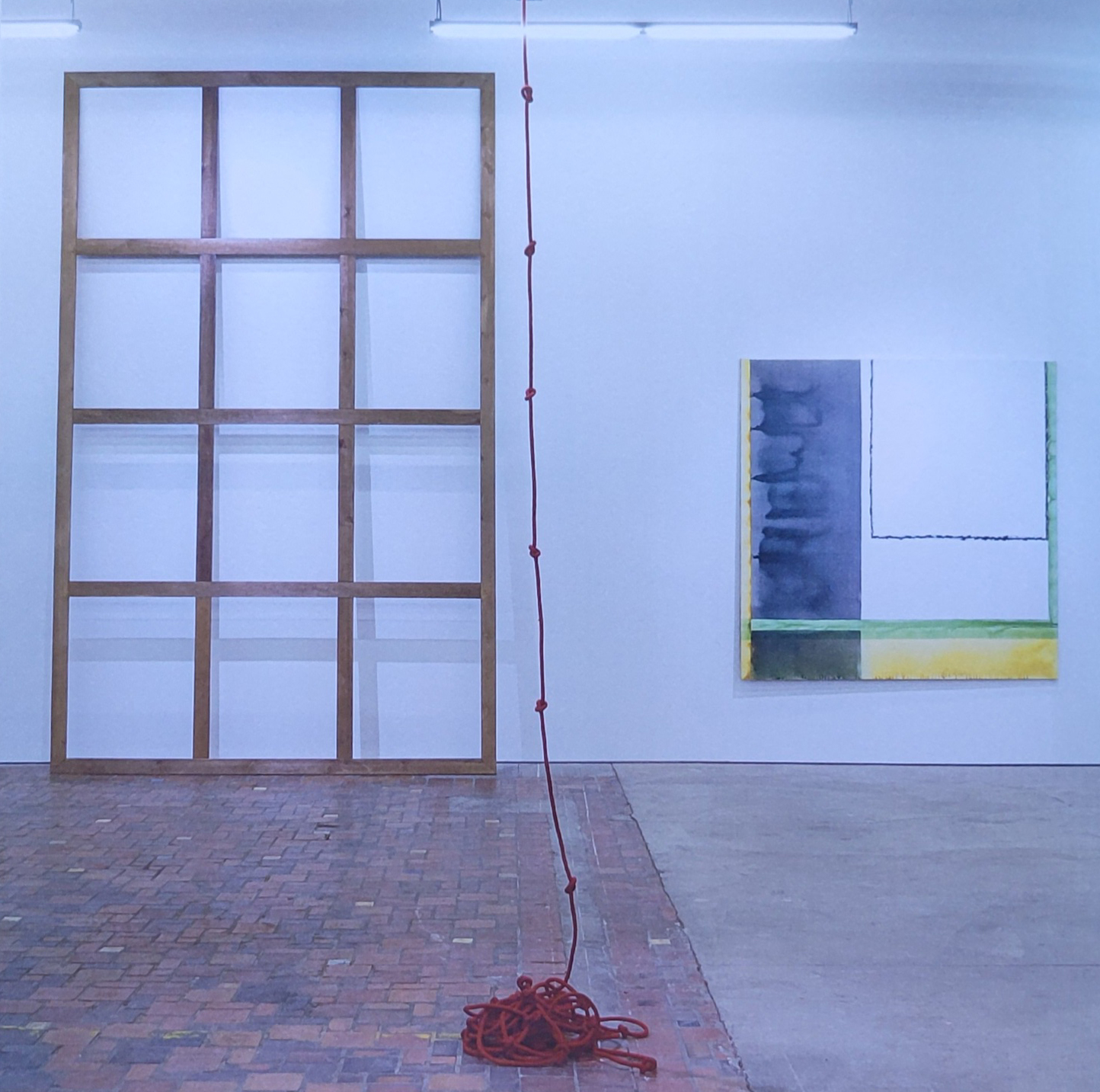
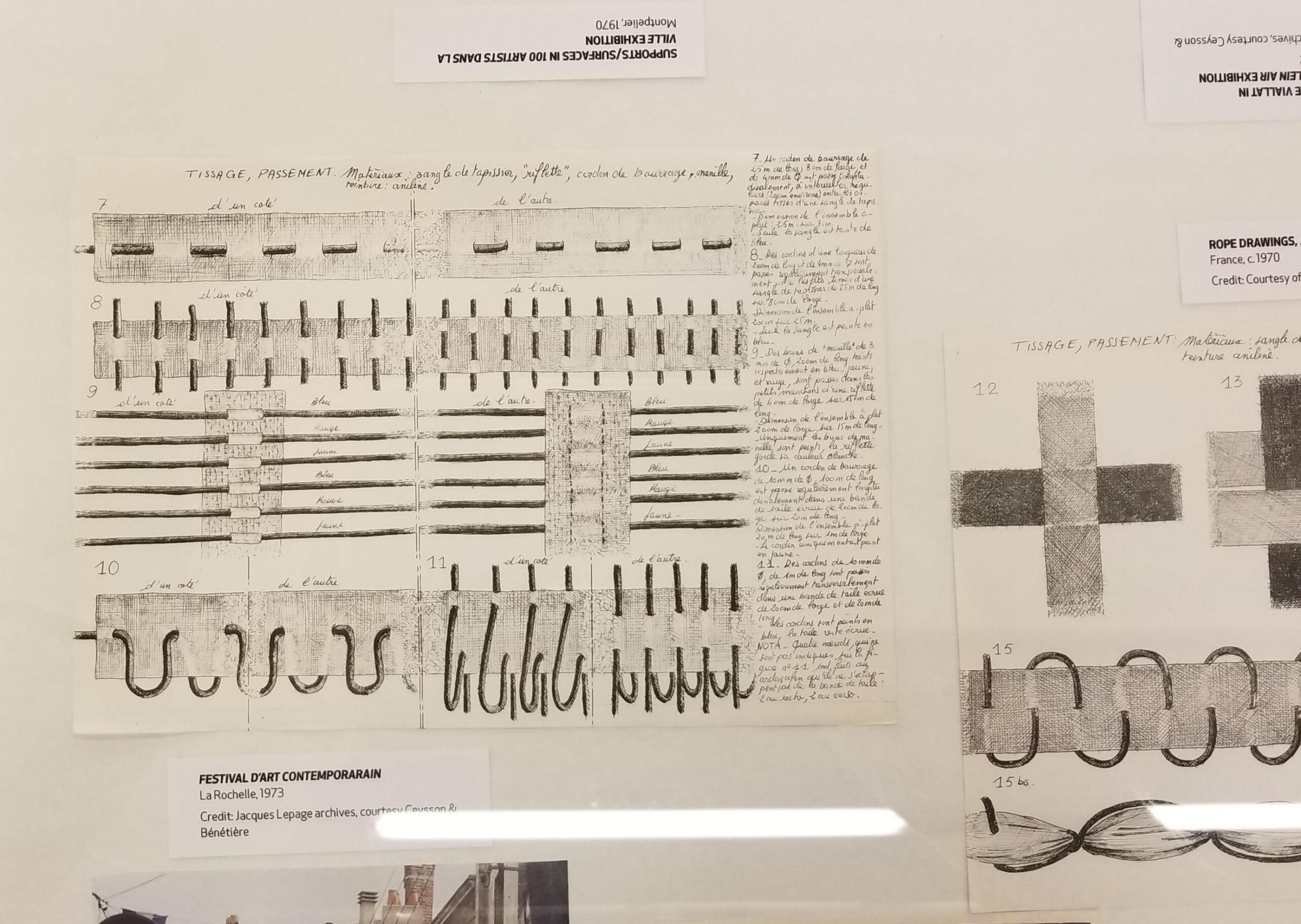
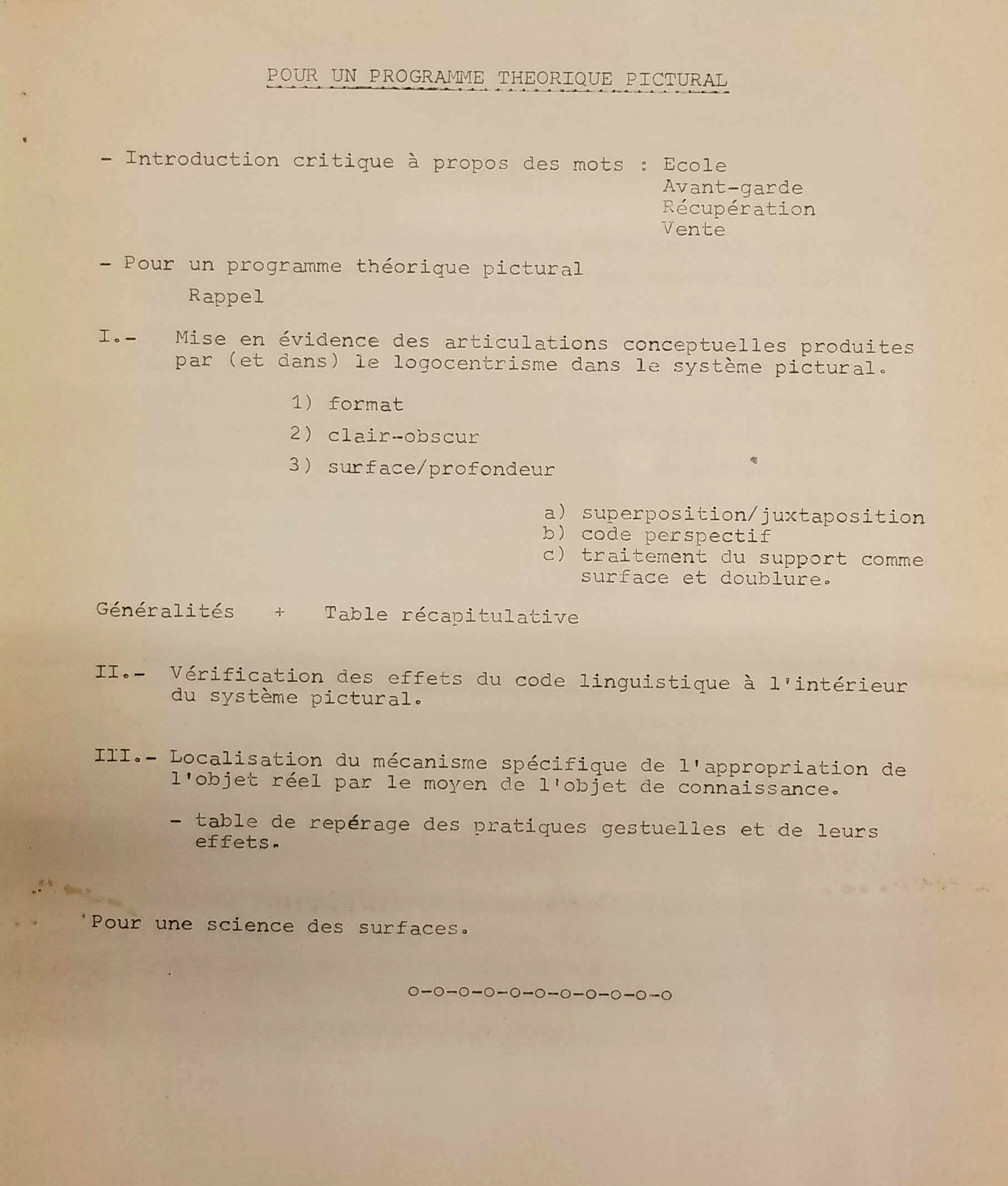


It remains, even in spite of such richness and delight, that I still found myself utterly - can I still say, wholly? - surprised by the moment - the rich, complex moment - that saw major exhibitions of Michel Parmentier and Supports / Surfaces in Michigan: Parmentier at the Broad Museum at MSU (2018) and Supports / Surfaces at MOCAD (2019). Though over the years I talked with many students – always two or three per year - about Supports / Surfaces, I quickly decided that I could not teach this as part of art history at my College, CCS. It simply could not be done. It was another world. And there is only so much that you can teach about Art from books. (I was flustered.)34 - And then out of nowhere there it was, in Detroit, and Michigan. This moment that saw the most advanced of advanced French painting in Michigan and on my doorstep in Midtown, Detroit - Supports / Surfaces, and in Lansing at MSU: BMPT (Buren, Mosset, Parmentier, Toroni), or at least, the Parmentier of BMPT, along with the politics of ’68, the seriousness of taking art seriously - Why would one not take life seriously? is what Cavell would respond in such situations - the journal Peinture: Cahiers Théoriques, letters and manifesto statements in vitrines, the politics of the immediate post-1968 moment and its distinctive brand of theory and practice articulated through painting where painting is understood as an object of knowledge , a (materialist) practice of painting and construction that is also peculiarly artisanal in the case of Supports / Surfaces, for they really believed, the members of Supports / Surfaces, in the work of the hand, for no matter how abstract, or minimal, or perverse looking, everything they presented is the result of the work of the hand – that rope with knots, for example, Claude Viallat’s 1971 / C14, 1971, ink on rope, the whole length, all 953 inches; they did not believe in computer programs, nor in machines - consider, say, MOCAD’s tremendously popular Roxy Paine sculpture-making machine Scumak from Meditations in an Emergency, MOCAD’s inaugural exhibition of 2006 - and they did not believe in, nor could any Supports / Surfaces artist have said, It’s conceptual so someone else can make it following our design. The many drawings of complex structures point toward this co-ordination of eye, hand, and mind.
Parmentier, on the other hand, pursued a genre of the end of art - or the end of painting, which he pursued with great repetitive patience, making the same gesture crayon in hand to establish a work that looked utterly uninflected, as if untouched by the hand, to look, in other words, impersonal - this painter read Beckett and Blanchot. Addie and I drove to Lansing with our son in tow as though going on a pilgrimage - with all due respect to the John Berger of Ways of Seeing, the 1972 BBC television series on visual culture selon Walter Benjamin, the days of pilgrimage are not over. Not even close. “The days of pilgrimage are over. We no longer go to images, they come to us,” pronounced Berger. A work by Parmentier is not an image but a work to be encountered in person. - More than ever in person means embodied, face-to-face. - It is a challenge to the ego of the viewer to look at what seems to deny perceptual difference, to look repeatedly at what seems to herald its own demise. The dates of this retrospective - December 1965 – November 20 1999 - are the first and the last, the beginning and end, of Parmentier’s painting. I sometimes think of Parmentier’s asceticism in Art as like that of a monk in the Egyptian desert, an anchorite, surprised that the world has (still) not yet ended! In the history of the Detroit art scene - but again, one is open to correction - there have been plenty of attacks on the bourgeois art viewer, but I cannot think of any sustained desire for an art that wants to finish with Art such as we find in Parmentier. Painting here is a different situation. Its situation is that of the patience of the concept. The paradox inherent in needing to see in the flesh a work that seeks to be impersonal is the very point. (Part of Berger’s greatness is that he knew this, but he needed to try on the Benjaminian version of the (technological) death of art for ethical reasons.) When one looks at the Supports / Surfaces installation at MOCAD - and how it just seemed to fit in - one is aware of the scrappiness of it all, as though the artists were trying to work - or give the impression of working - with what was at hand: this piece of rope – they loved rope / strings: the sea of the south of France? - this piece of fabric, this kitchen towel, this wood which is no longer a stretcher but which is stained and placed leaning against a wall as though midway between a stripped down canvas and an emergent sculpture - but I cannot tell you what it meant to see Daniel Dezeuze’ Grand Châssis, 1967, here, leaning against a wall in Detroit! - and there are, too, occasional evidently beautiful paintings such as Marc Devade, Sans titre, 1973 (ink on canvas). This heterogeneity of materials and looks – of supports and surfaces as elements of construction - is in stark contrast to Parmentier and BMPT – just think Daniel Buren – where look and process coincide as if forever. In Parmentier this is a form of austerity, whereas in Buren it is always linked to a certain playfulness and sense of surprise. Parmentier expects you, the viewer, to look and to look long and hard, whereas one feels that the artists of Supports / Surfaces, provincial mensch as they were, wanted to talk endlessly and interact with the objects around them in demonstration of their arguments with one another (and with the capital, Paris).35 The conversations and literature accompanying these two very French and very different art practices36 - and both, incidentally, in deep dialogue with contemporary American art practice of the 1960s - were of a kind not customary on the Detroit scene, and yet… Like ReFusing Fashion, the Comme des Garçons / Kawakubo show at MOCAD (curated by a collective consisting of Marsha Miro, Linda Dresner, Susanne Hilberry, John Corbin, and Michael Stone-Richard), Supports / Surfaces, brought here by Elysia Borowy-Reeder, then Director of MOCAD, was enormously successful and surprisingly right and so spoke to the way in which the epistemology of research – and surprise - is part of aesthetic experience, even as the work was always threatened by reductivism, whilst Parmentier showed something for which there is scarce any longer a vocabulary in contemporary commodified art: an art devoted to its own disappearance.37
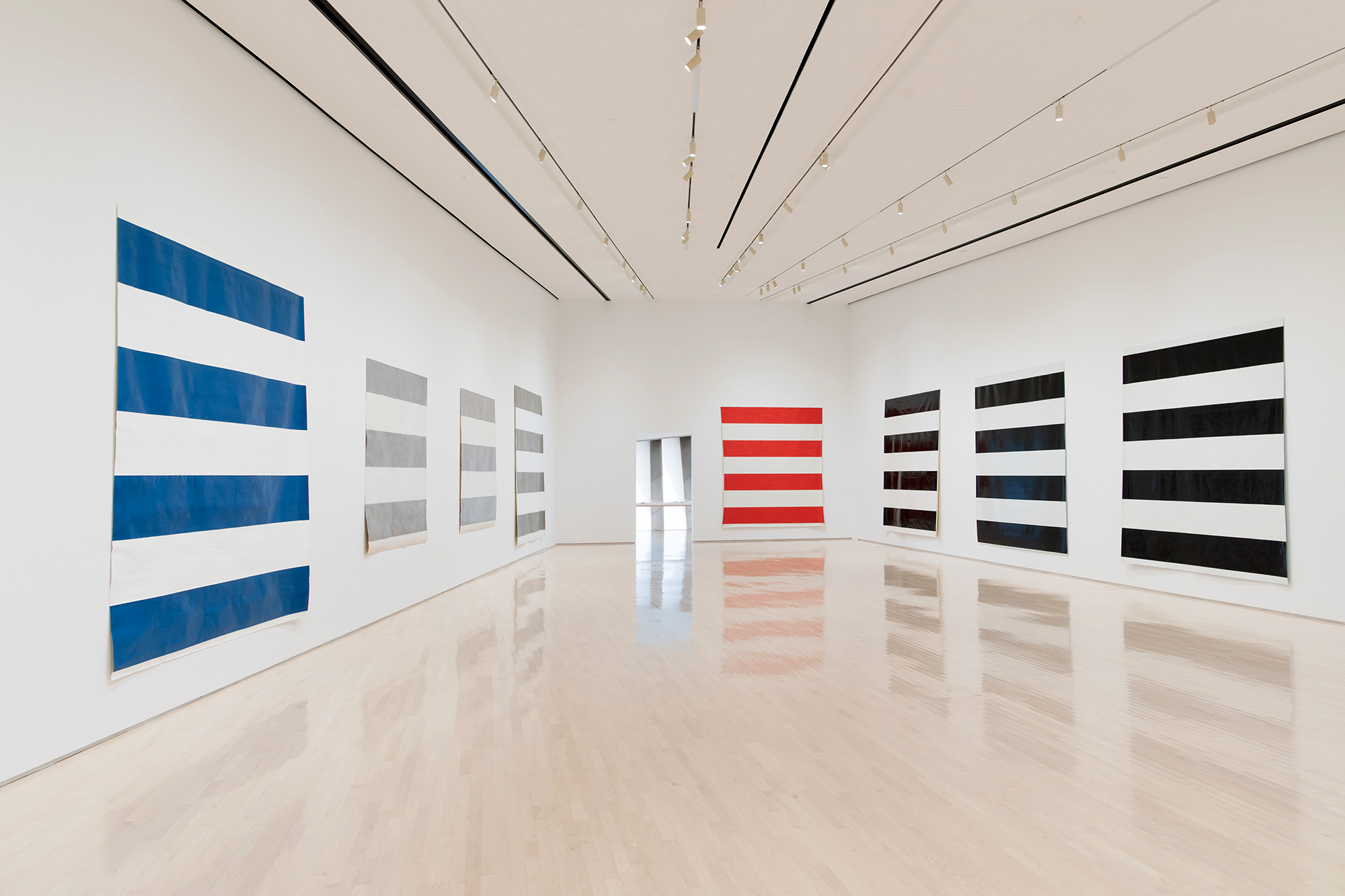
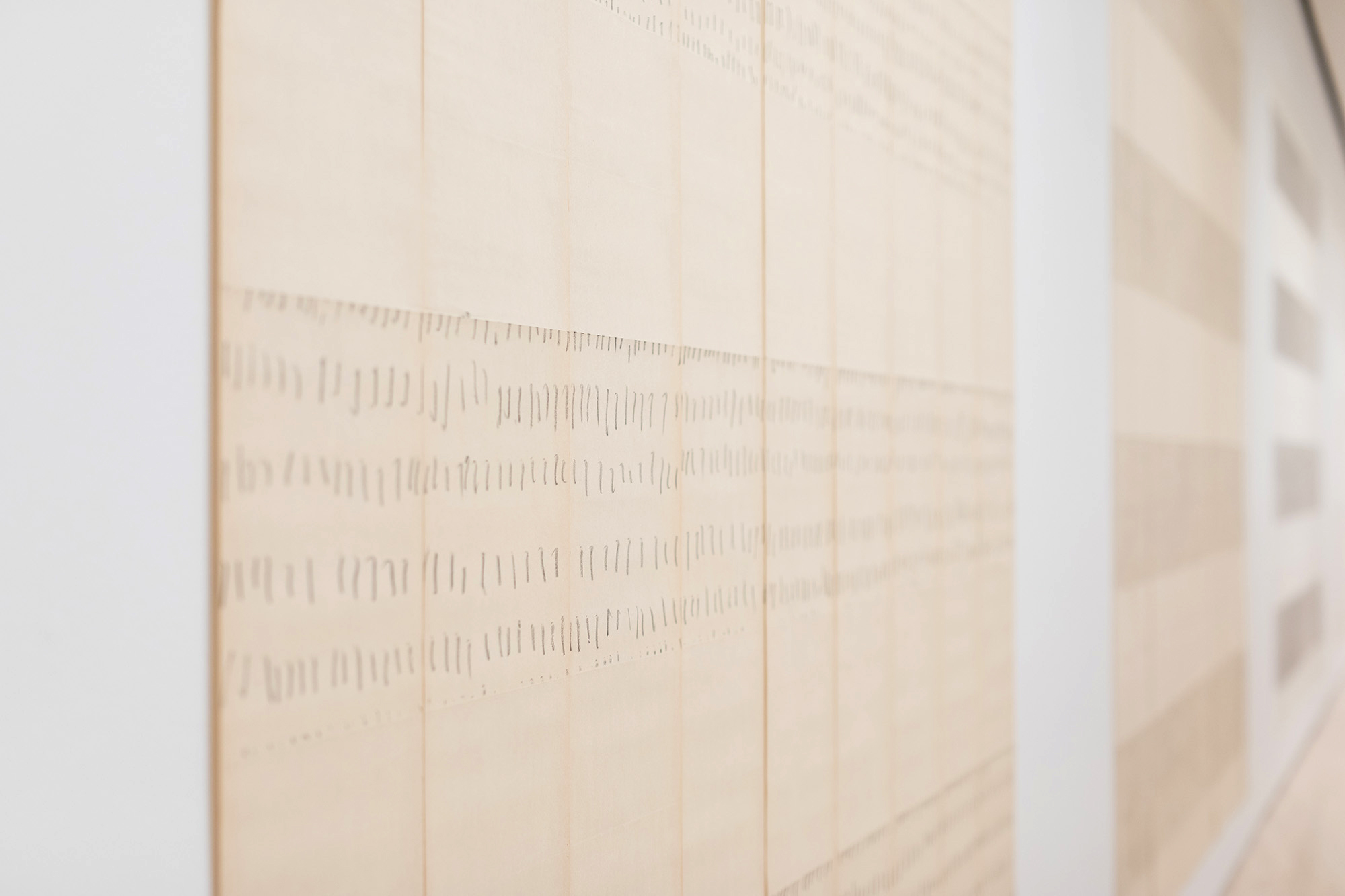
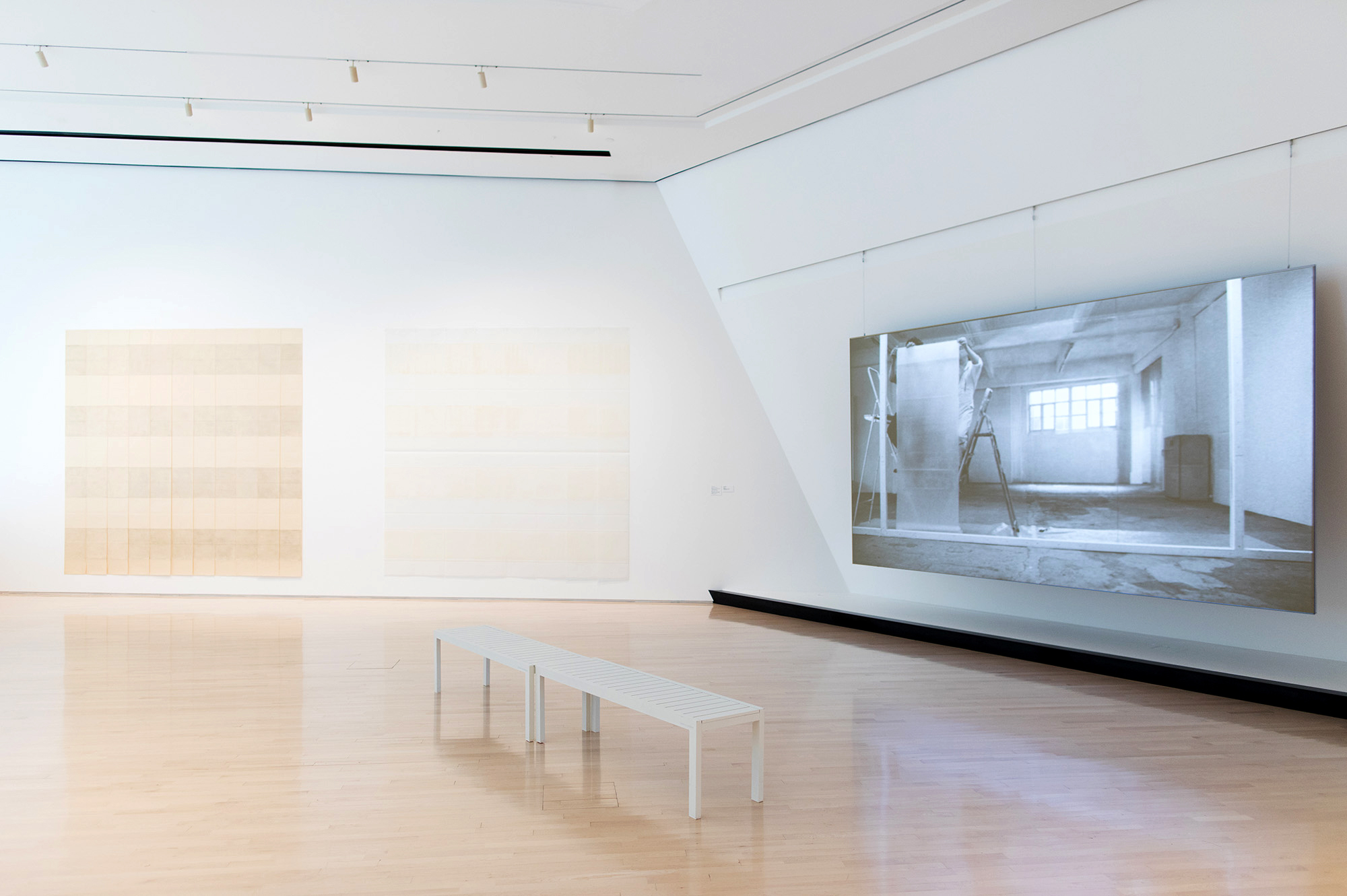
Michel Parmentier, installation view at the Eli and Edythe Broad Art Museum at Michigan State University, 2018.
Photo: Eat Pomegranate Photography
IX.
Before I leave the subject of the experience of surprise, I feel the need to touch on another instance of surprise and follow it through as an example of the role of identifications which I am beginning to realize is more and more one of the distinguishing features of contemporary Art Writing, in this case in the realm of music, and here I think of Chris Fachini’s sound system and dub music, also in Meditations in an Emergency, which also took me utterly by surprise and left me asking, What is going on here, with art boys and dub music, a music from a very particular part of my childhood in England, aspects of which still mean much to me, but which, in a real sense, I had long left behind? Let me explain.
In the Summer of 2006 as I was leaving Brooklyn for my new position – and life – at CCS in Detroit, I attended the Whitney Biennial. It was not a show that was particularly memorable, but I recall – without remembering the name of the artist – listening to some music that skirted around what it wanted to be before it became clear that it was…dub.. deep bass music designed for sound systems from the Jamaican club scene, with a form of vocalization best described as sprechstimme for the reggae voice, heightened speech, very rarely song, though like hip-hop there was often a professional (female) voice in the background. Dub always came with a musical (no song) VERSION for live perfomance in the dance hall for vocal performers – shouted – and was designed to be heard through a custom-made sound-system (the artisanal aspect of popular culture). Slow bass to rock you, but a voice to shock you. Here I was in The Whitney and out of nowhere I was hearing this music of the club scene of (a part of) my youth in what was clearly an art version, read meta, and so inevitably a lighter version. (Under heavy manners was one of the expressions used by dub performers to indicate the heaviness of dub, meaning, You – my competitor – will be disciplined; You will submit. A term of etiquette. A term of conduct – but what is performance theory if not etiquette in construction or being made visible?) I happened to be hanging with people who knew the artist but he had nothing of any interest to say and so I just left it behind and got ready to move to Detroit. Fast forward to the opening exhibition of MOCAD (with which I got involved the moment I arrived) in October 2006, and Klaus Kertess, the inaugural curator – I will deliver the inaugural lecture – has curated a certain Chris Fachini with a sound system into the show. I know what a sound system looks like and here is one in Midtown Detroit, playing dub. Granted we cannot be abreast of everything new, but I was genuinely taken aback at this trend, as I wanted to think of it, this sound culture. To be sure, dub music had long crossed the threshold from Black West Indian subculture into parts of student culture and the post-punk 1970s, i.e., the sound of dub had become one of the available sounds for cultural expression of difference and assertion, in the same way in which my daughters, without my knowing it, will as very young teenagers, start listening to Rage against the Machine and other sound performers, specifically sound performers, such as System of a Down. (One summer they sat me down in front of YouTube and introduced me to their sound culture and it was all noise based!) That’s how culture works – it ends up on the BBC or PBS…eventually, and the smart ones move on. But there was something else going on here, which I came to think of as not only very meta but also like a shadow of Alan Lomax, namely, the ethnographic collection of music as the means for listening not only to music away from the mainstream but a culture, a sound culture. There is something about hearing, and (structured or attentive) listening, that allows for the possibility of more available and thus receptive modes of sharing – we will rock you takes on new connotations – and the art frame, distinctive to Western modes of art, has become one of the principal ways of coming out of our skin and entering into the frequencies of otherness. The sound cultures of reggae and (parts of) dub most recently entered the mainstream through Steve McQueen’s Small Axe38 anthology collection (BBC and Amazon, 2020), and here in Detroit, in 2021 Red Bull showed Akeem Smith’s No Gyal Can Test, a multi-media installation – video, photography, sound, sculpture – the mainstay of which was the music, dance, and vernacular photography of Jamaican women displaying their pleasure through homemade fashion in the context of dancehall culture.39 Stunning. It conveys a world of intense woman on woman pleasure and sociality at once ethnographic and evanescent for which the frame of art becomes a moment of possible capture for limited transmission. Watching Smith’s video installations is as visceral as it gets in contemporary practice – only Steve McQueen’s films have left me more put out! And the reversible porosity of this process – from subculture to mainstream, black to white, and vice versa - can be grasped currently with Sonia Boyce’s social practice performances in Radio Ballads at the Serpentine Gallery where Boyce and collaborators have taken the music and social commentary of the English folk music revival - as embodied principally in the work, the music, and experimental radio documentaries of Ewan MacColl, Peggy Seeger, Charles Parker and collaborators between 1958 and 1964 (BBC Radio) - as base for an exploration of practices of Care.40 (It will always be the BBC which simply has the largest archives of music and documentary culture. Ask John Akomfrah.) Since there can be no doubt about the various sounds of pain or distress, Boyce inquires of the sound(s) of Care, and at certain points she frankly equates Care with Love.41 – It’s possible to see Sonia Boyce and Theaster Gates as two Black international artists based on either side of the (Black) Atlantic whose forms of Social Practice find articulation in vocalization through engagement with folk music: be it the blues, gospel, Black church music for Gates – Gates’ work with the Black Monks of Mississippi from 12 Ballads for a Huguenot House (Documenta 13) to the experimental vocalization of the Black Monks in The Black Monastic (Serralves Foundation, Porto, Portugal, 2014) is a key development here – or, for Boyce, the English folk music tradition as recovered by MacColl, Seeger, and others; however, what is most poignant is that though both root themselves at moments in the particularities of folk tradition each determinedly transcends the folk form as they enter into practices of hybrid vocalization drawing on Japanese monastic traditions of incantation (Gates) or Dada (Boyce): this is Boyce’s latest stage in the experimental vocal improvisations in Feeling her Way, her contribution for the British Pavilion of the Venice Biennale (2022).42 This same Sonia Boyce – rightly having a moment at the Venice Biennale – also, like Steve McQueen, had a developed take on the genre of Lovers Rock,43 so there is a genealogy – a series of affective identifications - running through certain artists like Gates, McQueen, and Boyce from the folk or cultural dancehall forms to experimental vocalization as a high point of fundamentally social practice forms defined by Care.
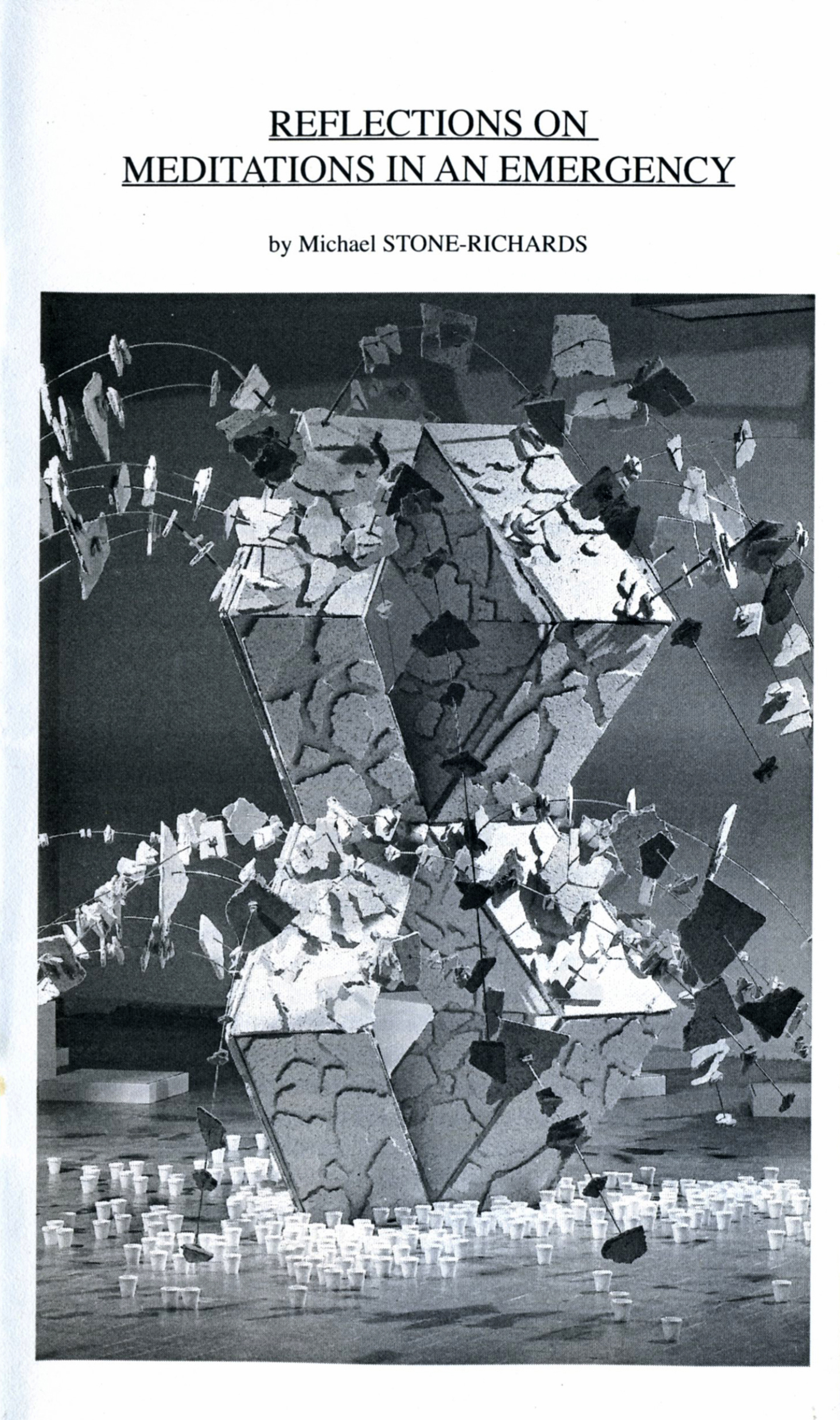
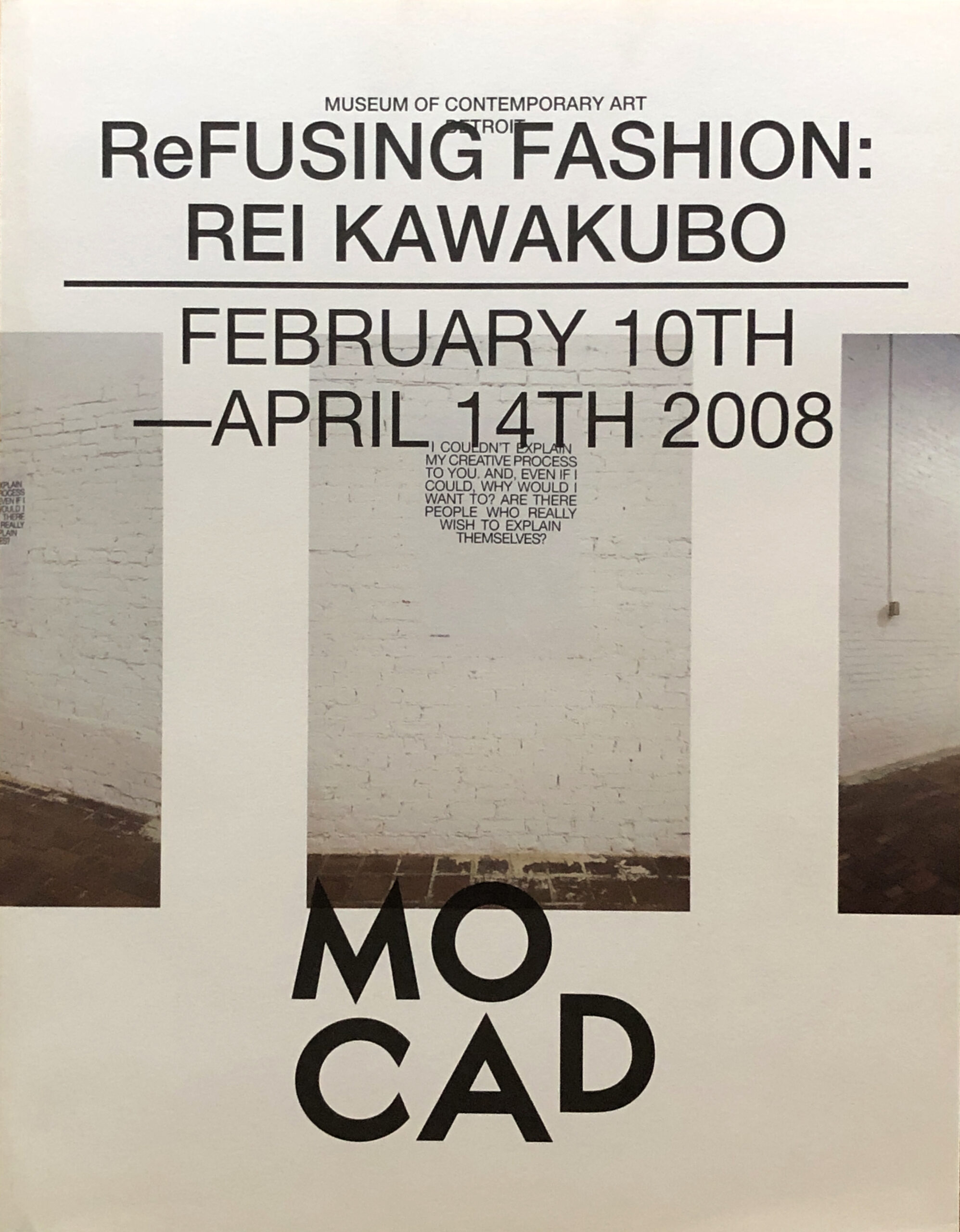
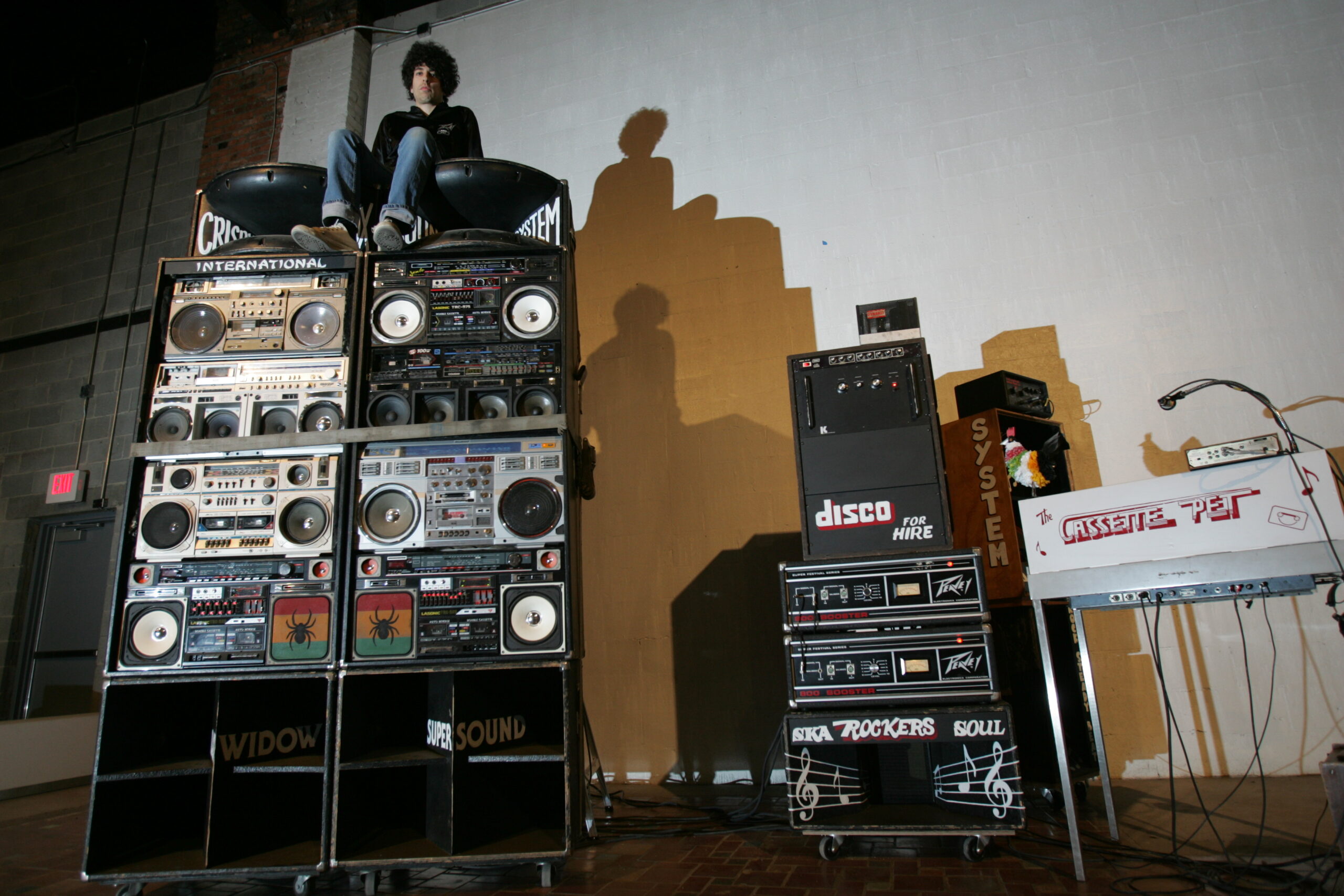
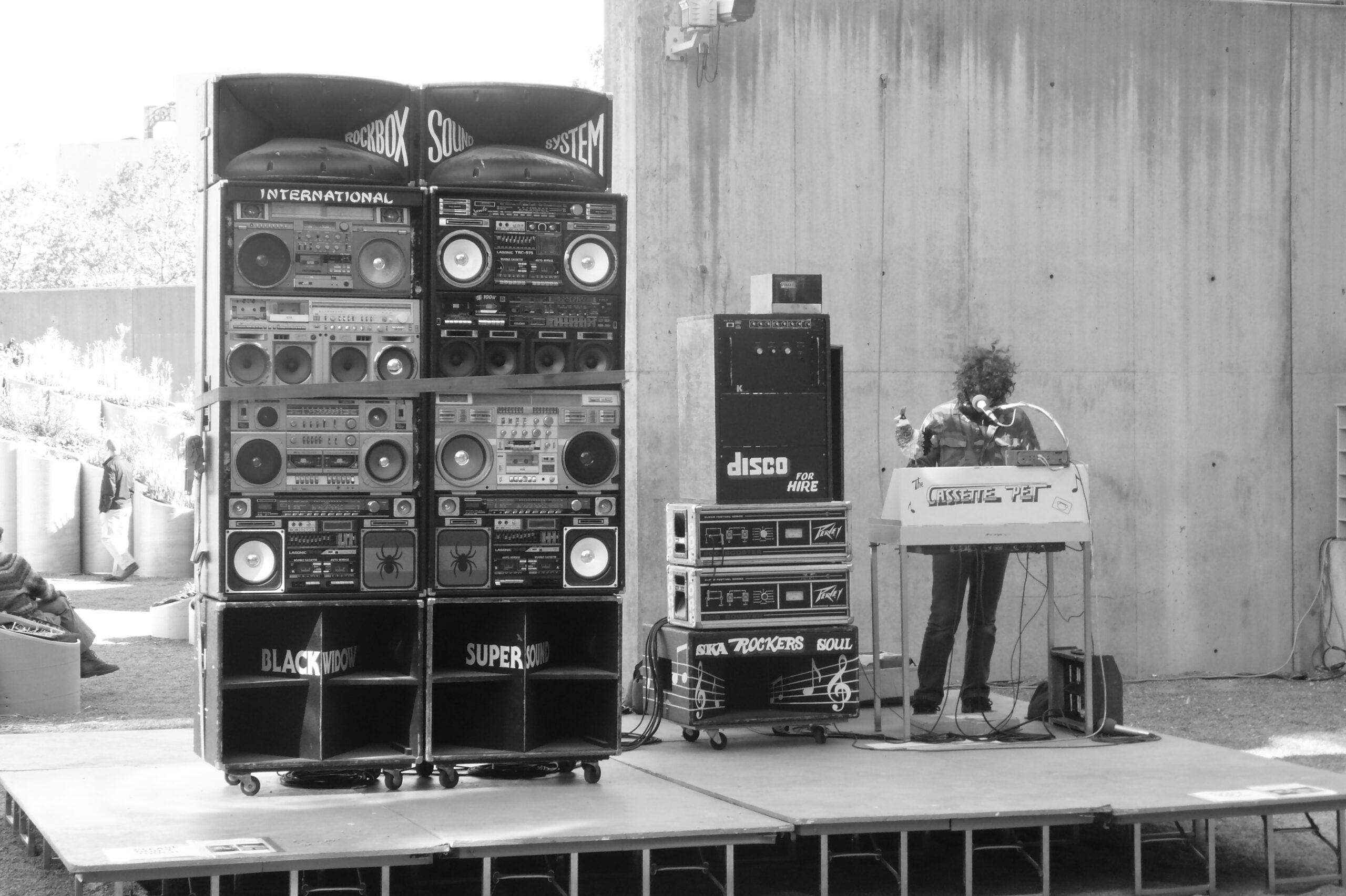
Christopher Fachini performing live at MoMA PS1, New York City, NY. 2008
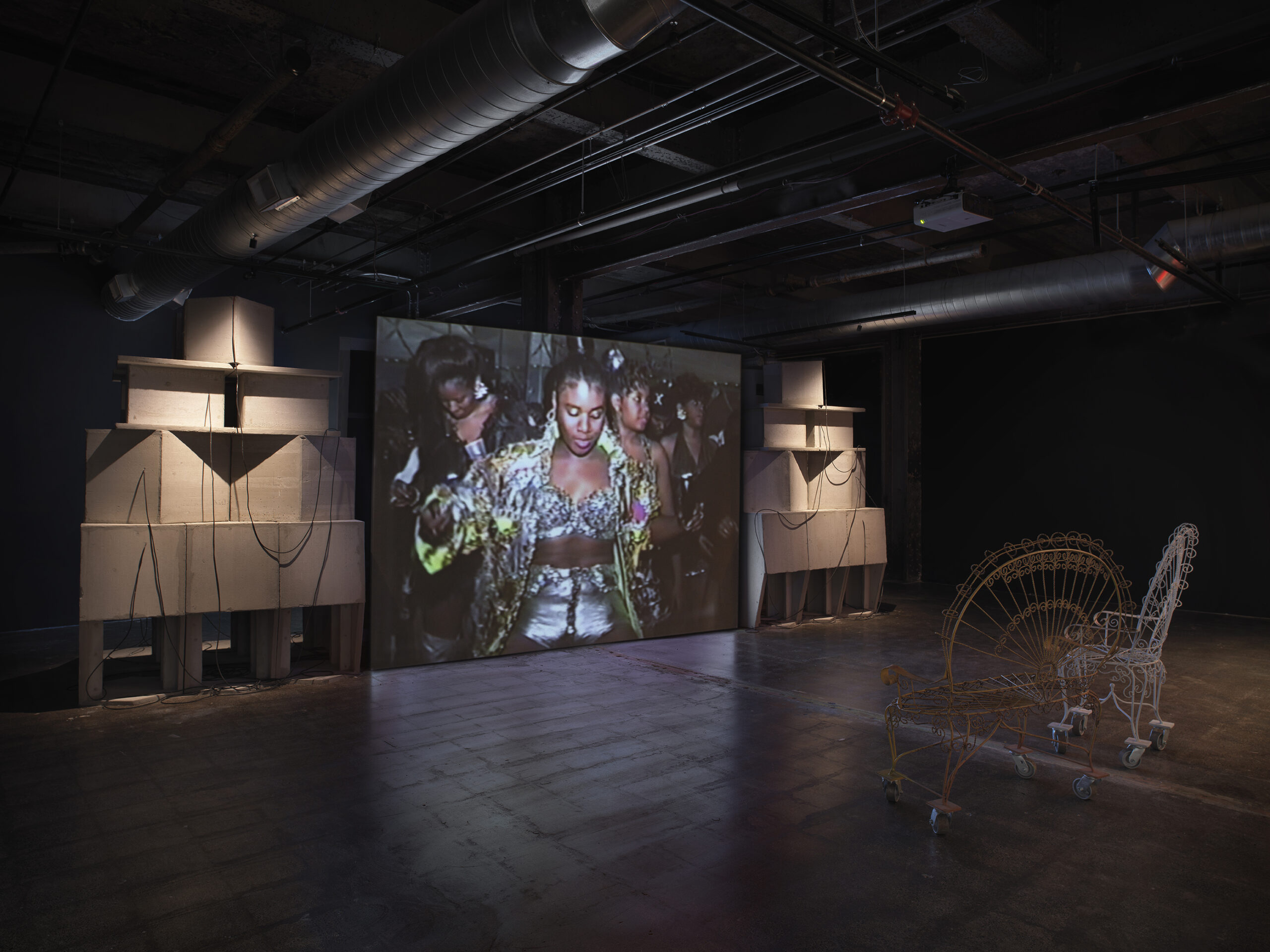
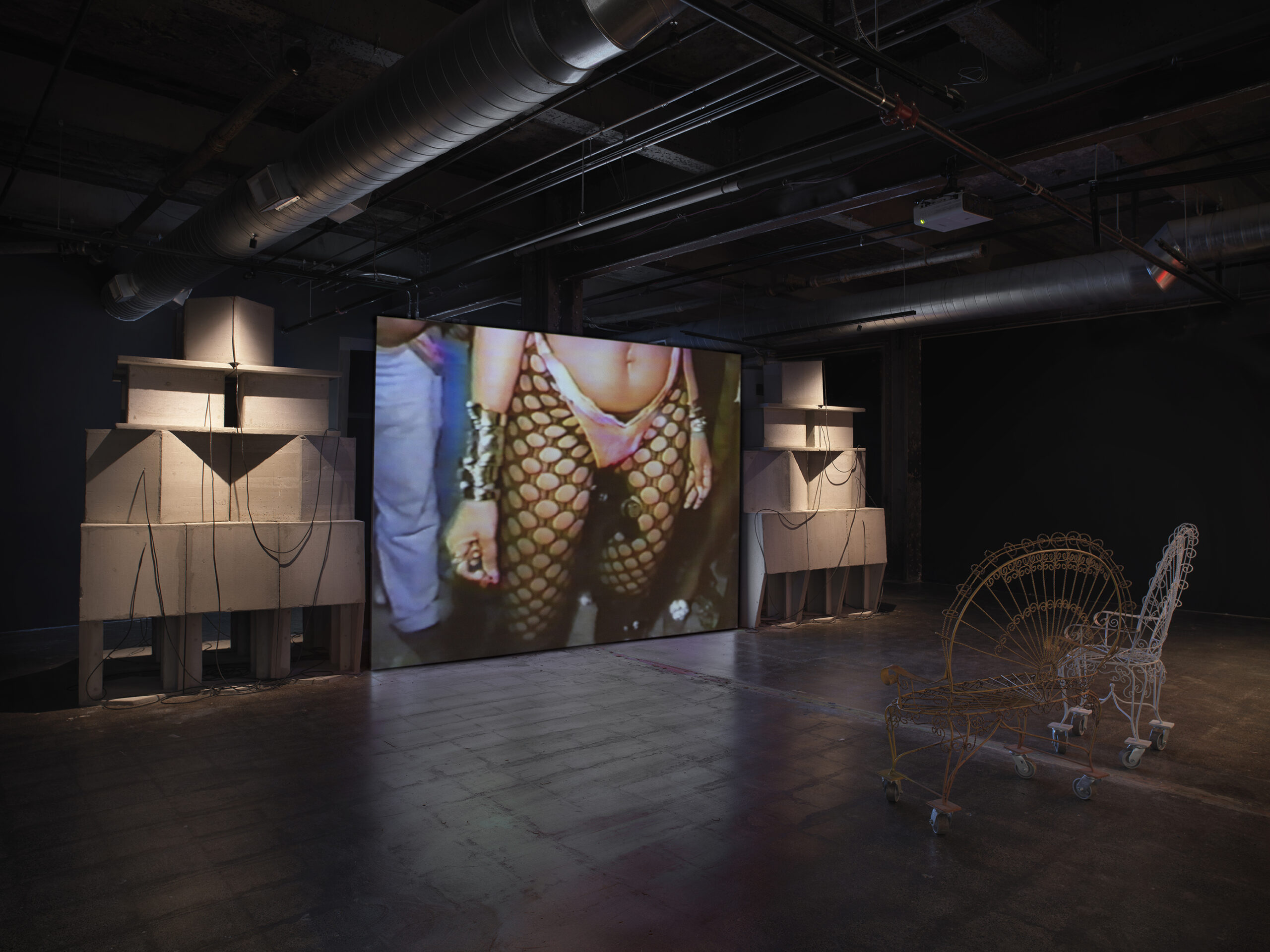
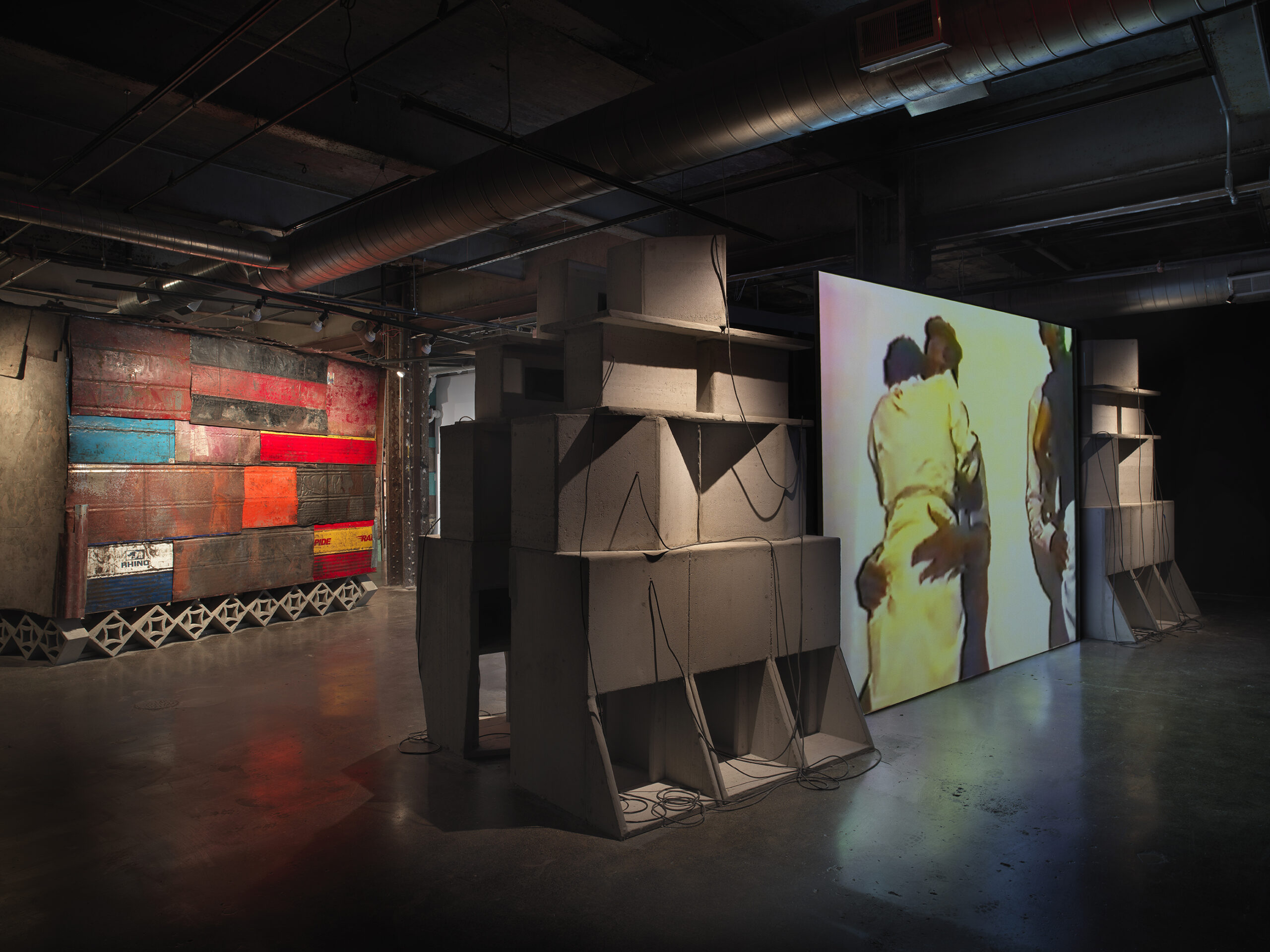
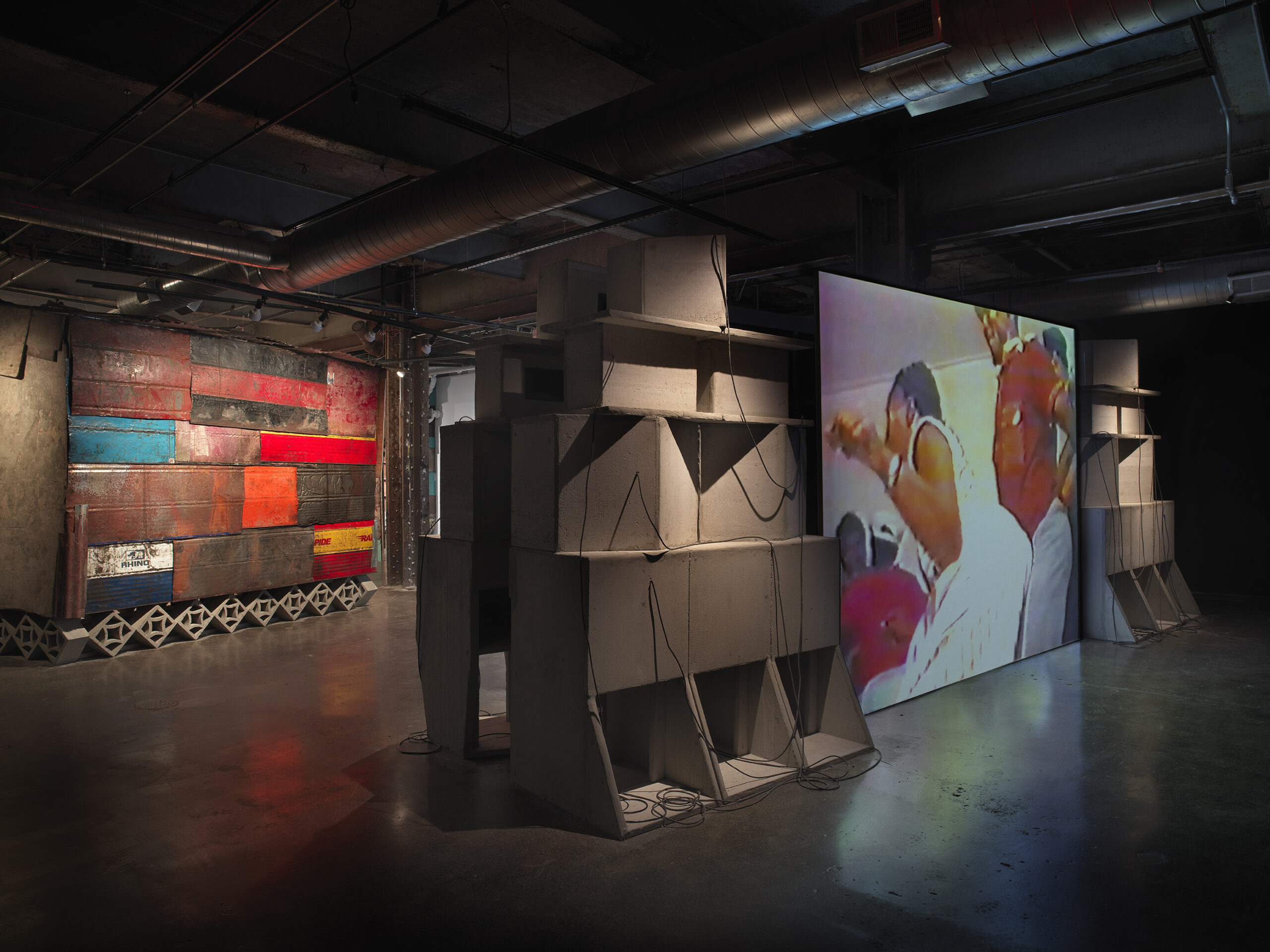
X.
Francesca Berardi. Detour in Detroit. Milano: Humboldt Books, 2015. 280 pp.
A few years ago, when I first read this book and met its author, I was comfortable in saying to all who would listen to me, This is the best book on Detroit in recent years! If irritation resulted, so be it, all the better if it led to the book being read. Detroit was fortunate to have such a friend, such a witness. A young Italian journalist on a fellowship in New York by chance visits Detroit and is taken by surprise, which is to say, not prepared for what she encounters. She decides to return to the city on her own in her own time knowing no one – this is the detour – on six occasions, using Airbnb. After a while people she meets begin to connect her with others with whom she might stay on her visits. This chance element makes her writing the record of a form of dérive of both city and interiors (of homes as well as people with whom she stays or comes to know). This openness, and its related receptivity is the mark of Francesca Berardi’s writing, but what it leads to is also telling, since she also reports on her experience of dwelling with others: she does something that is so very, indeed, exceptionally rare in writing about Detroit: she writes about domesticity and the spaces and acts of domesticity. Weaved as such accounts are into her experience of the arts scene - especially the post-studio practices for which Detroit has become rightly known in the past fifteen years or so - along with the most compelling account of the urban gardening scene (and not the usual suspects),44 and making visible the relations between certain modes of Black being in the city and White people and their institutions - in its heyday Amy Kaherl’s Detroit Soup was the only place for an organic meeting between the arts scene and Black working class people - Berardi uncovers new subjects of Detroit and allows for a new vision of hospitality, domesticity, and social / spatial practices to enter visibility and find orientation in the new mental map of Detroit in the act of emerging from the compulsive scenes of ruination.45 Here you will find accounts of an old-world Italian restaurant that does not exist in the Old World (“The Old Days, between Veal Scaloppine à la Tosca and Madonna’s Fingers,” 67-79). It is a work of great generosity of spirit. When placed in the context of the first great conceptual work on Detroit and the Heidelberg Project carried out by the architecture discourse formulated by Kyong Park (upon leaving Storefront for Architecture in New York) along with the School of Architecture at Columbia University (Richard Plunz), the School of Architecture at University of Detroit-Mercy (Stephen Vogel), and Architecture at Cranbrook (Dan Hoffman), Francesca Berardi’s Detour in Detroit offers a new and generous language for thinking Detroit.
XI.
We chase the sound / …/ Invented stories / With silent tracings
ADULT. and Shannon Funchess, Detroit House Guests
ADULT. / Nicola Kuperus and Adam Lee Miller. Here I can write, Our Avant-Garde, or at least, I want to, but I still have not arrived at a satisfactory formulation of what I would mean by this. The phrase came to me spontaneously after seeing them do a performance (with a vacuum cleaner) first at MOCAD and then in a space in the Russell Industrial Complex, and noticing an audience deeply attentive and co-creative. Addie and I became friends with two sets of people in Detroit in no small part because the question of domesticity was essential to their practice, by which I mean not only their various acts of making but also as an intentional practice of living, the practice not of making or producing stuff, but the Aristotelian praxis of transformation of the self through reflexive action that allows for shared world-views. We recall one friend saying, Have you noticed how no one talks about domesticity when discussing Cass Corridor artists? (They were too busy trying to be heroic.) And we responded, Or in any other facet of Detroit art – and this in spite of how urgent and complex the question of domesticity had become in critical theory, feminist and other wise. Just think Beatriz Colomina’s Domesticity at War (2017)! Across their intermedial practice – in music, photography, film, painting, performance – it is strangely powerful and not a little disorienting when one realizes that they are constantly turning around this question of domesticity: of home, of how to live, of how to be alive, of how the domus and its attendant ideology imputes camouflage, and with it, loss of agency, even as intentionality and attention is put into the curating of interiors for living. – Theirs is a space for dreaming. - Domesticity is protection, projection, Care, but also bathos. Domesticity is immanent temporality, not ecstatic temporality, as base for possible release and return to ground. (The films, the horror films by Nicola and Adam, are nothing if not an all-out assault on domesticity. This is part of their dialectic.) Domesticity is both the making and un-doing of woman and femininity. An ethnomethodological dramaturgy. I see these issues and questions in the way in which after this national tour or that European tour or that British tour (since the Brits are no longer Europeans) they always return to Detroit, which is also to say, to their space of intimacy, the place of retreat and welcome to friends – the Detroit House Guests of 2017! This project in domesticity and hospitality when artists were invited to live, perform, and record with ADULT. in their Detroit home, without necessarily being friends ahead of time – Dorit Chrysler, Shannon Funchess, Michael Gira [see DR3], Robert Aiki Aubrey Lowe, Douglas J. McCarthy, Lun*na Menoh [see DR3]. I regret that I cannot reproduce the black and white photographs that accompany the album, an almost ethnographic set of photographs of cooking, shopping for food, moments of play and relaxation, a couple of loo roles, a warm unmade bed, people without makeup, and photographs of performances in the house (not in the studio), as well as photographs of making and changing of linen! – And yet how the color photographs of the album cover make the humble quilt suddenly mysterious in that surréaliste manner of staging that Nicola perhaps inherited from her fascination with Guy Bourdin - another source of our friendship and my admiration. 24 years. In Detroit. Nicola Kuperus and Adam Lee Miller. Intermedia artists of international renown, unique in the Detroit landscape, generous in their talents with others: again, music, film, plastic arts, performance art, photography as a unified but challenging practice - on stage, in the city, in airplane hangars, in industrial settings, in colleges (Rhode College, CCS, and others), in galleries, in museums, but also in their home. Over 24 years they have been a key measure of avant-garde collaboration and fearless innovation both in Detroit, nationally, and internationally. Their concept work Detroit House Guests was a landmark in art / music collaboration and the practice of hospitality, a subject, like domesticity, almost untouched by most artists in Detroit. Our avant-garde, meaning, provisionally: something distinctive to us, something emergent from here, implicating the question of place, and yet, at the same time, if an avant-garde cannot be reducible to place, place, then, as the point of departure. Place, too, as the occasion of being, the means of flourishing. Detroit. 24 years of it - even more, if you include the College Years at CCS – 24 years of intentional being, of the practice of becoming who we are – who we might yet be – in acts of fierce invention. And when Nicola performs with not one but two microphones? The noise / sound barrier is broken, shattered. Definitively. The sound-world they create a new kind of hospitality. There is nothing like them! They exemplify the politics of staying so central to contemporary practice where the reflexive practice of Care has become necessary at the communal level, but where love becomes indistinguishable from friendship in the moments of intimacy in which we all long to be. What if, then, our avant-garde is a figure of the outline of a new kind of friendship?
Another world / Another life.
ADULT. and Douglas J. McCarthy
Endnotes
[1] For the longest time, imagine, I wondered what happened to volume 2 of this book!
[2] https://pirate.care/pages/concept/. Accessed 08-27-22
[3] It is not difficult to grasp how performance art could make the everyday a subject of art and so invite viewers (or participants) to enact the invisibility of the matter, a kind of ethnomethodological null set, as it were!
[4] In the series collectively known as Iconoclasm from 2018, Sam Durant of CalArts composed a set of large-scale grisaille drawings, on the scale of history paintings, on the theme of the destructions of monuments as markers of political dissolution. It’s exhibition at the Library Street Collective in Detroit in 2019 was one of the most important shows in recent memory in Detroit.
[5] Photography is part-and-parcel of the circulation of suffering, of the figuring of social pain. It is, one might say, an anthropological condition: not only American lynchers posed for photographs at lynchings, like a Sunday afternoon picnic, and them made postcards of the event to share with others, the Japanese soldiers who committed the massacres of Nanjing, China in 1937 also took photographs and also made postcards of their victims to be sent openly through the mail. The photo-graphic image is simply the unit – the most effective unit – in a chain of mimetic behavior par excellence as conceived by the late philosophical anthropologist René Girard. Examples abound.
[6] Arthur Kleinman and Joan Kleinman, “The Appeal of Experience; The Dismay of Images: Cultural Appropriations of Suffering in Our Times,” in Social Suffering, ed. Arthur Kleinman, Veena Das, and Margaret Lock (Berkeley: University of California Press, 1997), 1.
[7] Elizabeth Hardwick, “After Watts” (1966), in The Collected Essays (New York: NYRB, 2017), 154. My italics.
[8] Simone Weil, quoted in Joan Tronto, Moral Boundaries: A Political Argument for an Ethic of Care (New York and London: Routledge, 1994), 128.
[9] Simone Weil, Oeuvres complètes (Paris: Gallimard, 1997), VI.2: 419.
[10] Weil, ibid, 418-419.
[11] There is every reason. For instance, to believe that Robert Frank’s practice has built into it an attack on the idolatry of the image in relation to suffering, pursuing a désoeuvrement (un-working, un-doing) of the photographic image which tellingly, given Frank’s movement from photography to film, Kerouac refers to as film.
[12] Gilbert Ryle, The Concept of Mind (1949) (Harmondsworth: Penguin Books, 1978), 134. My emphasis.
[13] Wilson Harris, The Infinite Rehearsal (London and Boston: Faber and Faber, 1978), 1.
[14] I shall be eternally grateful to the late Malcolm Bowie who, when he read my ms on Voice and the Enigma of Place: On Surrealist Experience, called me from All Souls to my then office at Northwestern and asked, Why do you encase yourself in so many footnotes referring to other people’s problems? Say what you have to say and leave others to draw their conclusions.
[15] And the melancholy and beautiful composition Whisper not by Art Blakey? A piece of pure nostalgia and commemoration on the part of Debord. Whisper not was recorded live at the Club Saint-Germain in December 1958 and it was only this live recording which was available in France. See, Art Blakey and the Jazz Messengers (Paris, 1958). CD, RCA, Bluebird 61097-2.
[16] Cf. Sur le passage de quelques personnes à travers une assez courte unité de temps, 1959, b&w, 35 mm, dir. Guy Debord.
[17] I recall as a teenager – who had in any case always written with a Waterman fountain pen – reading of Rilke starting over any letter in which he made a mistake, and then one day, in conversation with Prynne, who also has a beautiful hand, hearing him say of himself, “My dear, I am nothing if not an archivist!” Prynne, until his retirement from Gonville and Caius, was the College Librarian. The handwriting already, thus, points to the archive.
[18] My emphasis.
[19] My emphasis. One is reminded that in Charles Darwin’s title The Descent of Man (a falling away, a moving away from, a decline from) represents an ascent for the species.
[20] Derek Walcott, “Laventille,” Collected Poems, 1948-1984 (New York: Farrar, Straus and Giroux, 1986), 86.
[21] Walcott, “Laventille,” 88. My emphasis.
[22] Derek Walcott, “The Muse of History,” What the Twilight Says: Essays (New York: Farrar, Straus, and Giroux, 1998), 41.
[23] See The Metropolitan Museum exhibition, Death becomes Her: A Century of Mourning Attire, 2015. https://www.metmuseum.org/exhibitions/listings/2014/death-becomes-her. Accessed 04-15-22. Maundy Thursday.
[24] Cf. Loss: The Politics of Mourning, ed. David L. Eng and David Kazanjian (Berkeley and London: University of California Press, 2003).
[25] Chris Dercon, “Un Bauhaus pour la prévention de la guerre? Ça n’existe pas?” in Anselm Kiefer: Pour Paul Celan (Paris: Rmn-Grand Palais, 2022), 20. This statement by Dercon pointedly does not speak of Enwezor’s relation to Kiefer, but the relation to Germany.
[26] Marguerite Duras, La Douleur, in Cahiers de la Guerre et autres textes, ed. Sophie Bogaert and Olivier Corpet (Paris: P.O.L / Imec, 2006), 175-204.
[27] Saidiya V. Hartman, “The Burdened Individuality of Freedom,” Scenes of Subjection: Terror, Slavery, and Self-Making in Nineteenth-Century America (Oxford and New York: O.U.P., 1997), 116.
[28] Maurice Blanchot, L’Écriture du désastre (Paris: Gallimard, 1980), 7.
[29] This text on “Penia et Poros,” which, in its insistence on jouissance and la Chose, contains the core of a Lacanian account of racism and the subject of the unconscious, can also be readily found online, but see it in the context of the fascinating Collectif de Pantin, a group, since 2018, devoted to the study of psycho-analysis and racism. I hope to be able to publish a translation imminently. Cf. https://www.collectifdepantin.org/posts/penia-et-poros-du-recit-mythique-a-levenement-historique-par-solange-adelola-falade. Accessed 04-15-22
[30] This place of jouissance, which is also a place of suffering.
[31] Cf. Hervé Bouchereau and Chantal Pontbriand, ed. Sur ma manière de travailler (Montréal: Parachute, 2002).
[32] In another context, I think it would be worth pursuing a comparative study of the role of oral transmission in French psycho-analytic contexts beginning with the SFP (1953 – 1965) and the oral teaching of the Method in acting by Lee Strasberg beginning 1956.
[33] Michel Parmentier, in Michel Parmentier: December 1965 – November 20 1999: A Retrospective, ed. Guy Massaux (New York: Ortuzar Projects and Paris: Éditions Loevenbruck, 2019), 1.
[34] Though I am clearer about how I might go about teaching this moment of French art (in relation to its dialogue with American art of the 1960s) at my College, I am still by no means sure that the resources would be available - this is not visual culture - as the whole enterprise is massively meta: both movements, Supports / Surfaces and B.M.P.T., are interpreting advanced American art of the 1960s and interpreting European modernist art history – for instance, the role of Matisse in this moment of contemporary French art - never mind the whole business of the role of Tel Quel at this moment! For an accessible situating of Tel Quel and Supports / Surfaces, cf. Philippe Forest, “L’Avant-garde artistique: Peinture et Supports / Surfaces, ” Histoire de Tel Quel, 1960-1982 (Paris: Seuil, 1995), 419-426. At the heart of Tel Quel is the critic, Marcelin Pleynet, who would be important independent of Tel Quel. Pleynet is the French critic of his generation with arguably the most concrete knowledge of contemporary advanced American art practices, at the very least before the appearance of the writers associated with the journal Macula - Jean Clay, Yve-Alain Bois, Hubert Damisch, etc. of whom Bois is the most consistently dismissive of the French culture of art writing about modernism.
[35] Supports / Surfaces’ provincialism was very much part of their identity.
[36] Does one need to point out that these two groups, Supports / Surfaces and BMPT, had little time for each other?
[37] Cf. Philip Armstrong, “Michel Parmentier: Between Refusal and the Abandonment of Painting,” in Michel Parmentier, 86-89.
[38] Small axe, but hear also, small acts, that is, the everyday.
[39] In May of 2021, I held a conversation with Akeem Smith about his solo exhibition at Red Bull Arts, Detroit. See, “Archiving the Black Diaspora: Jamaica 1980 – Y2K,” Akeem Smith in conversation, CCS Creative Boost and Red Bull Arts, Detroit.
[40] See the rich documentation for Radio Ballads on the website of the Serpentine Gallery: https://www.serpentinegalleries.org/whats-on/radio-ballads/ The catalogue opens: “What are the sounds of care, and how do we listen and hold them?” In addition, see the very accessible history, Ewan MacColl, “Concerning the Radio Ballads,” in Ewan MacColl and Peggy Seeger, I’m a Freeborn Man (New York: Oak Publications Inc., 1968), 5-16.
[41] Cf. Sonia Boyce, Like Love (Berlin: The Green Box, 2010).
[42] Cf. Emma Ridgway and Courtney J. Martin, Sonia Boyce: Feeling Her Way (London: British Council and Yale University Press, 2022). On Social Practice / vocalization, cf. Michael Stone-Richards, “Play, Music, and Learning to live with the Dead: The Sound of Care in Theaster Gates and Sonia Boyce,” Care of the City (forthcoming, Sternberg Press).
[43] Cf. Mark Crinson, “Telling Lyrics,” Annotations 2 (1998): 24-27.
[44] On the Black presence in urban gardening, cf. Berardi, “A Passion for Basil can change your Life (And if nothing else, there’s wild Garlic),” Detour in Detroit, 55-66.
[45] See, for example, the chapters set in interiors and which set out on the quest for ideas from the habitants of such interiors, for example, Grace Lee Boggs, “The Strength and Grace-fulness of a Revolution,” Detour in Detroit, 139 - 147, and on Scott Hocking, “Dialogue between a Detroit Artist and a Pheasant Enthusiast,” Detour in Detroit, 196-213.
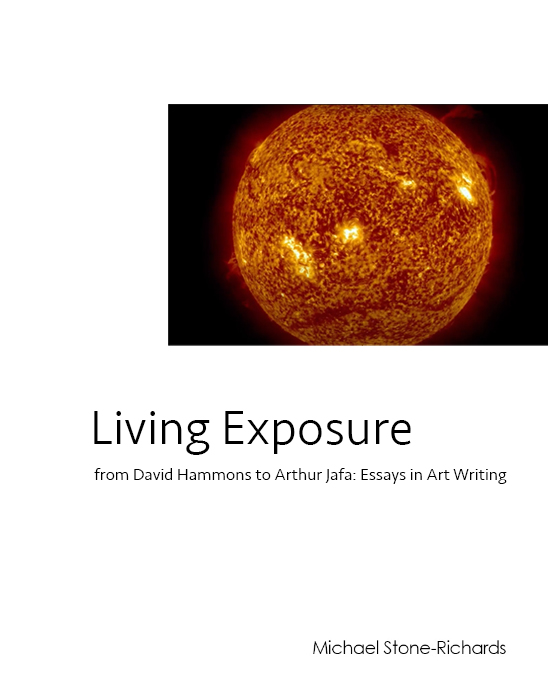
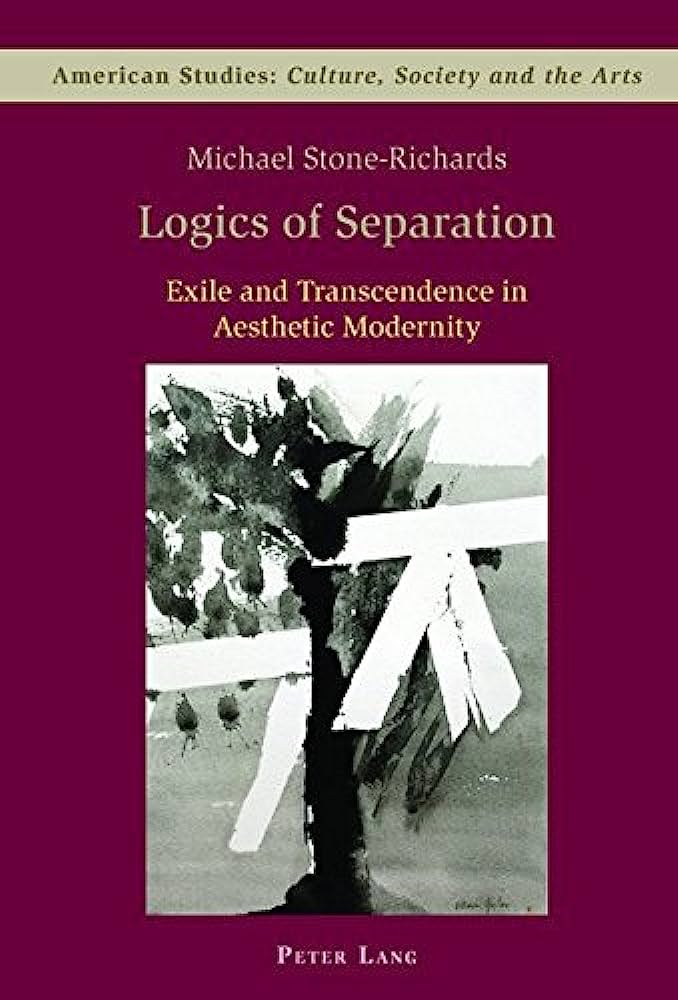
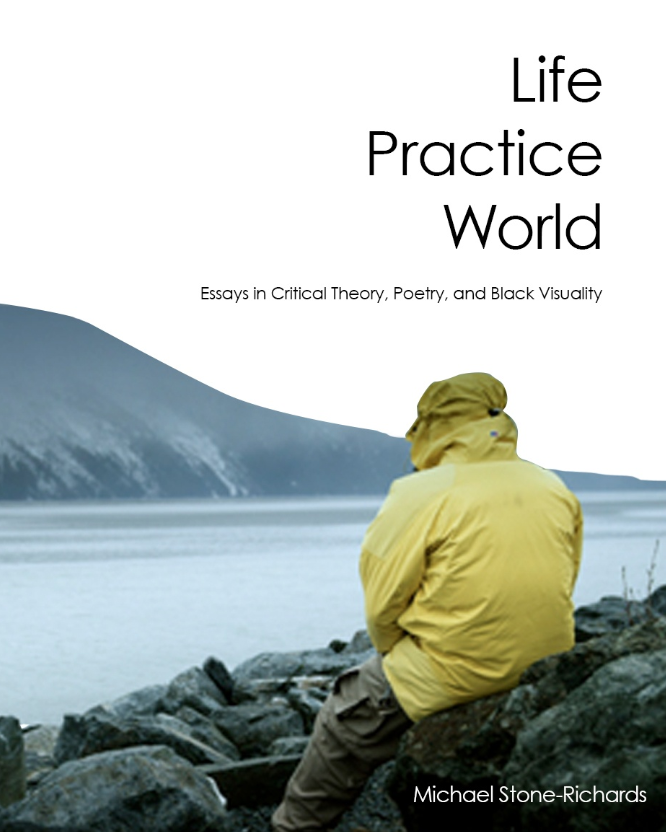
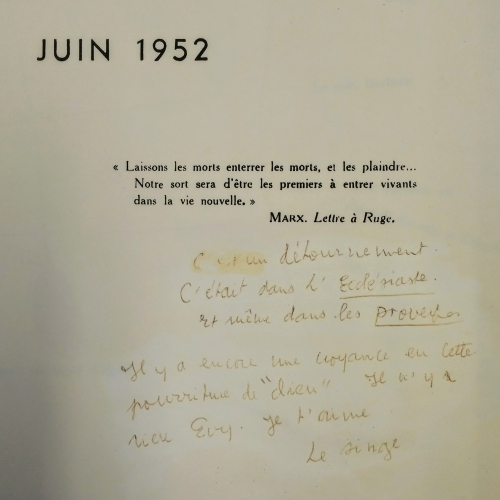
Excerpt from "Envoi," Detroit Research, volume 3 (Spring-Summer 2022).
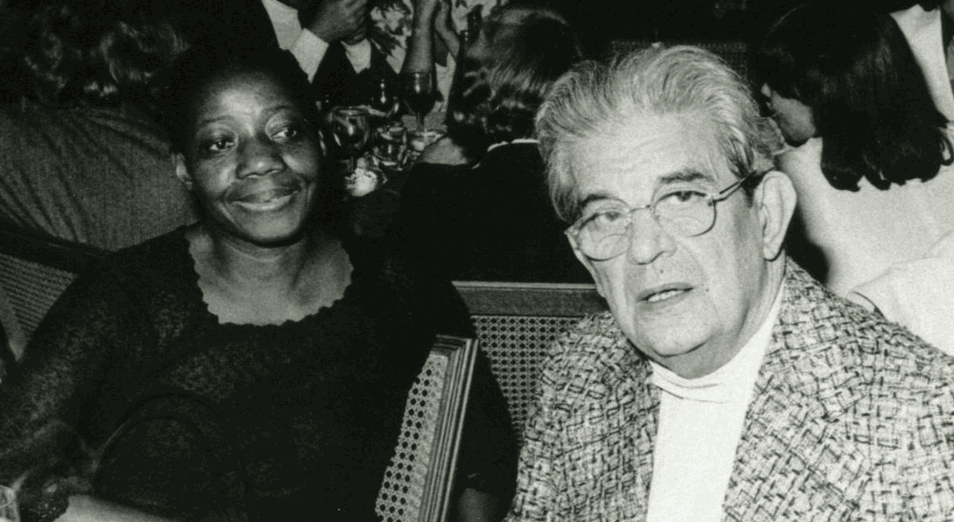
Pour Professeur Ming Tiampo, le 1er novembre XXI
J’ai vu, écrivait ce monstre sacré qu’est Rimbaud;
mais nous, après les autres civilisations,
nous voyons maintenant autrement
du cœur du vivant.
Julien Lenoir
Solange Faladé. Clinique des névroses. Séminaires transcrits par Emmanuel Koerner et Marie-Lise Lauth. Paris: Anthropos, 2003. 349 pp.
Solange Faladé. Le moi et la question du sujet. Séminaire 1988 – 1989. Transcrit par Emmanuel Koerner et Marie-Lise Lauth. Paris : Economica / Anthropos, 2008. 278 pp.
Solange Faladé. Autour de la Chose. Séminaire 1993 – 1994. Transcrit par Emmanuel Koerner et Marie-Lise Lauth. Paris : Economica / Anthropos, 2012. 216 pp.
Solange Adelola Faladé. “Penia et Poros, du récit mythique à l’événement historique,” Psychologie clinique, no. 18 (Winter 2004): 248-254.29
Solange Faladé. Mandela – De Klerk: Sujets de la science politique. De l’illusion du « même » à la reconnaissance du « semblable. » Collection « École Freudienne. » Vanves : MJW Fédition, 2022. 145 pp. [As DR3 goes to press.]
From the moment that the subject speaks, from the moment that the subject is the barred subject, from the moment that the subject makes the Grand Autre incomplete, and when, once again the subject bears, when it makes, a demand to the Grand Autre, at that very moment there will be created an emptiness [vide], a vacuole in the midst [au sein] of the Grand Autre, this place which Lacan has called la Chose. The subject is going to have to find out how to get along with [voisiner] what is forbidden [interdit], this place of jouissance.30
Solange Faladé, Autour de la Chose, séance du 26 octobre 1993: 15.
Endnotes
29. This text on “Penia et Poros,” which, in its insistence on jouissance and la Chose, contains the core of a Lacanian account of racism and the subject of the unconscious, can also be readily found online, but see it in the context of the fascinating Collectif de Pantin, a group, since 2018, devoted to the study of psycho-analysis and racism. I hope to be able to publish a translation imminently. Cf. https://www.collectifdepantin.org/posts/penia-et-poros-du-recit-mythique-a-levenement-historique-par-solange-adelola-falade. Accessed 04-15-22
30. This place of jouissance, which is also a place of suffering.
31. Cf. Hervé Bouchereau and Chantal Pontbriand, ed. Sur ma manière de travailler (Montréal: Parachute, 2002).
32. In another context, I think it would be worth pursuing a comparative study of the role of oral transmission in French psycho-analytic.
Hommage à Solange Faladé
André Breton, “Vigilance,”
Jean-Luc Nancy, “André Breton,”
Martine Broda, “thorn” and “explosive immobile,” in Detroit: Imaginary Cities (Detroit: MOCAD, 2007).
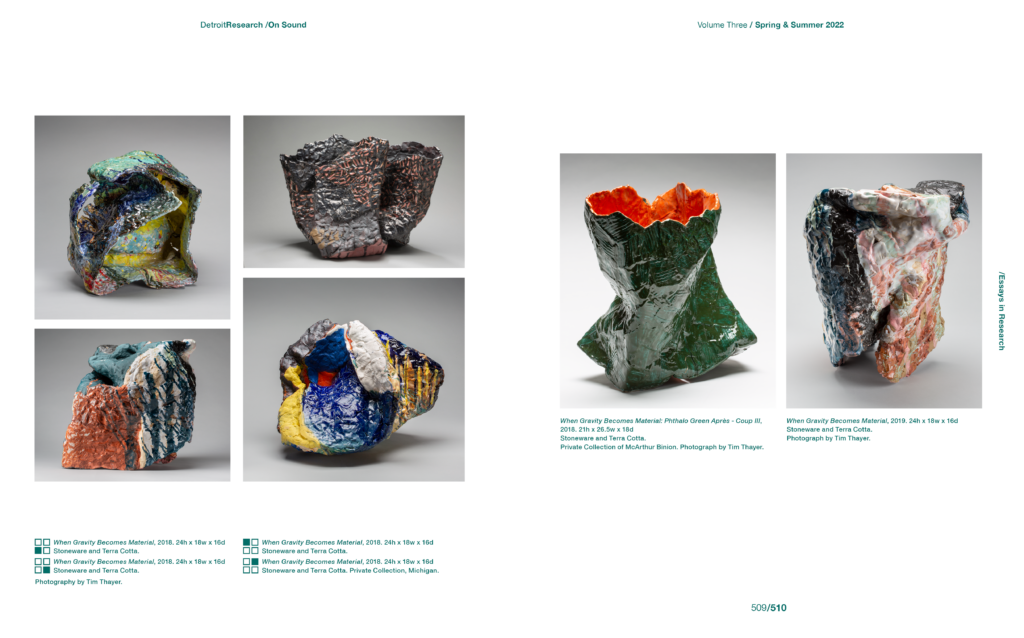
Lecture: Reframing Utopias: Radical Anxiety / Radical Futures
March 2021
Lecture: Negation, Disavowal, and the Ethics of Attention: Between Solange Faladé and Stanley Cavell
February 2021
Lecture: Negation and Disavowal in Spatial Politics
October 21, 2020
Lecture: Detroit 1967 + The Politics of Pleasure
Museum of Contemporary Art: Detroit
October 25th, 2017.
MSR interviewed by John Sauve about Detroit Research and his book Care of the City: Detroit.
New Departures and Transitions: Medium, Materiality and Immateriality at G. R. N'Namdi Center for Contemporary Art.
Video By: Gilda Snowden
ReFusing Fashion: Rei Kawakubo, Michael Stone-Richards and John Corbin talk on fashion. WDET-Detroit Today, 2008.
Duration: 23 min
Arts Writing, Michael Stone-Richards, Nick Sousanis, Rebecca Mazzei and George Tysh talk on art writing in the Metro Detroit Area. WDET-Detroit Today, 2007.
Duration: 50 min
The Sensibility of the Collector, June 22, 2006.
Participants: Charles Randall Dean, Glenn Horowitz, Francis Levy (moderator), Michael Stone-Richards, Peter Subkowski
Video By: Philoctetes



